
| JAPANESE | TOP PAGE | |
|---|---|---|
| 0 | 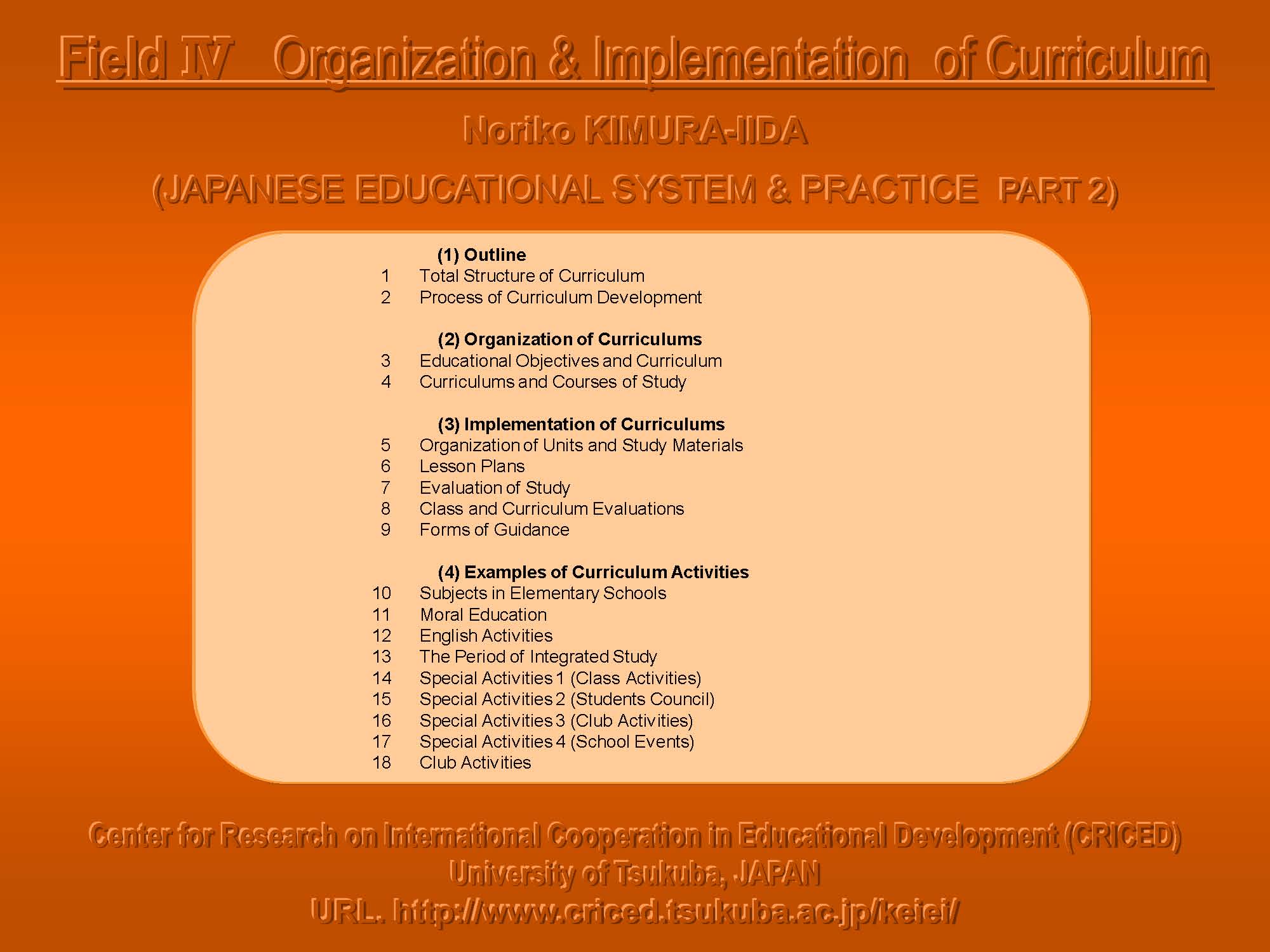 |
Download : IV Organization & Implementation Curriculum |
| 1 | 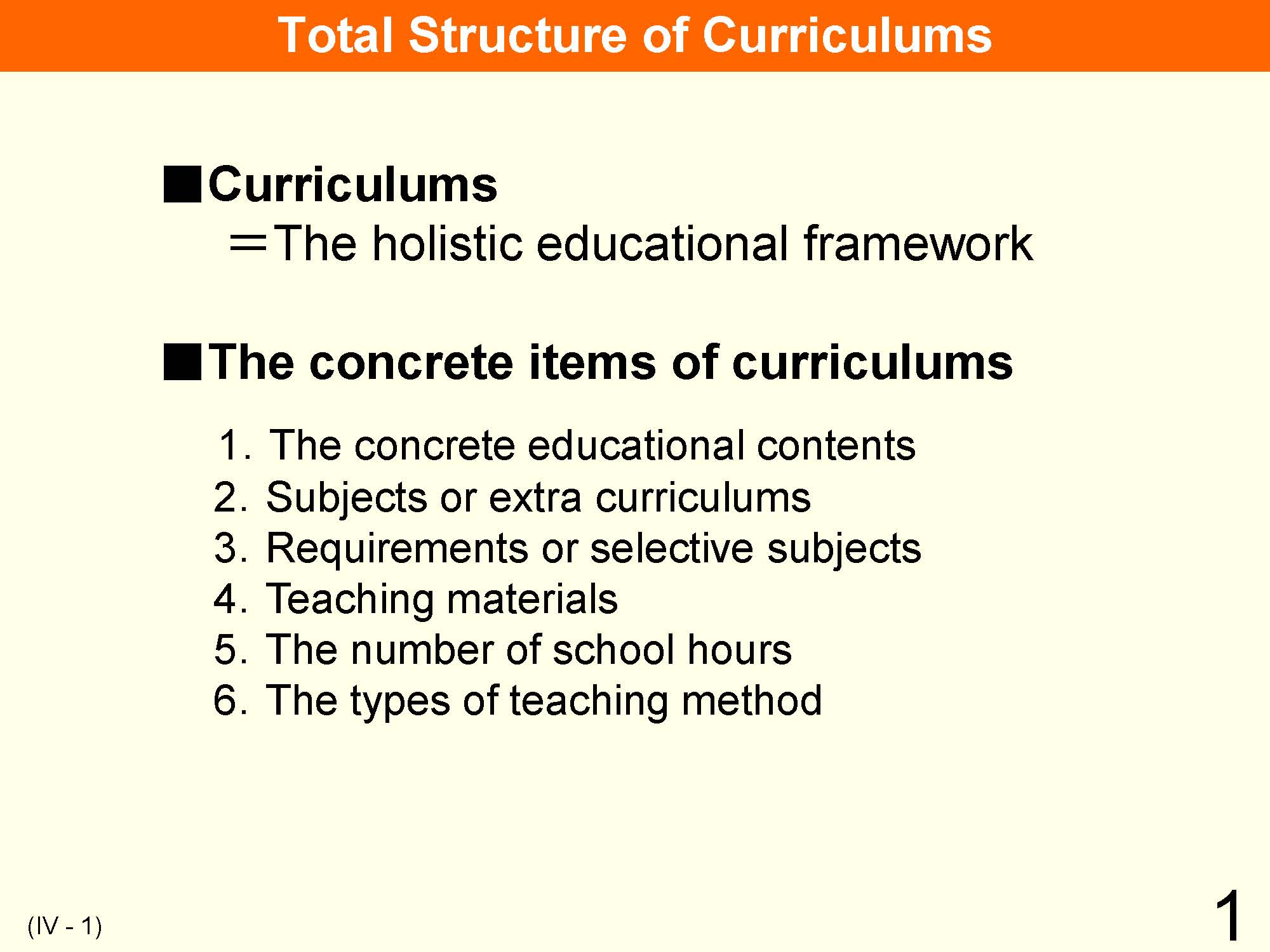 |
Each school sets up its ideas and educational objectives. The curriculum is a school’s educational plan that organizes each grade’s core requirements in a systematic management style. |
| 2 | 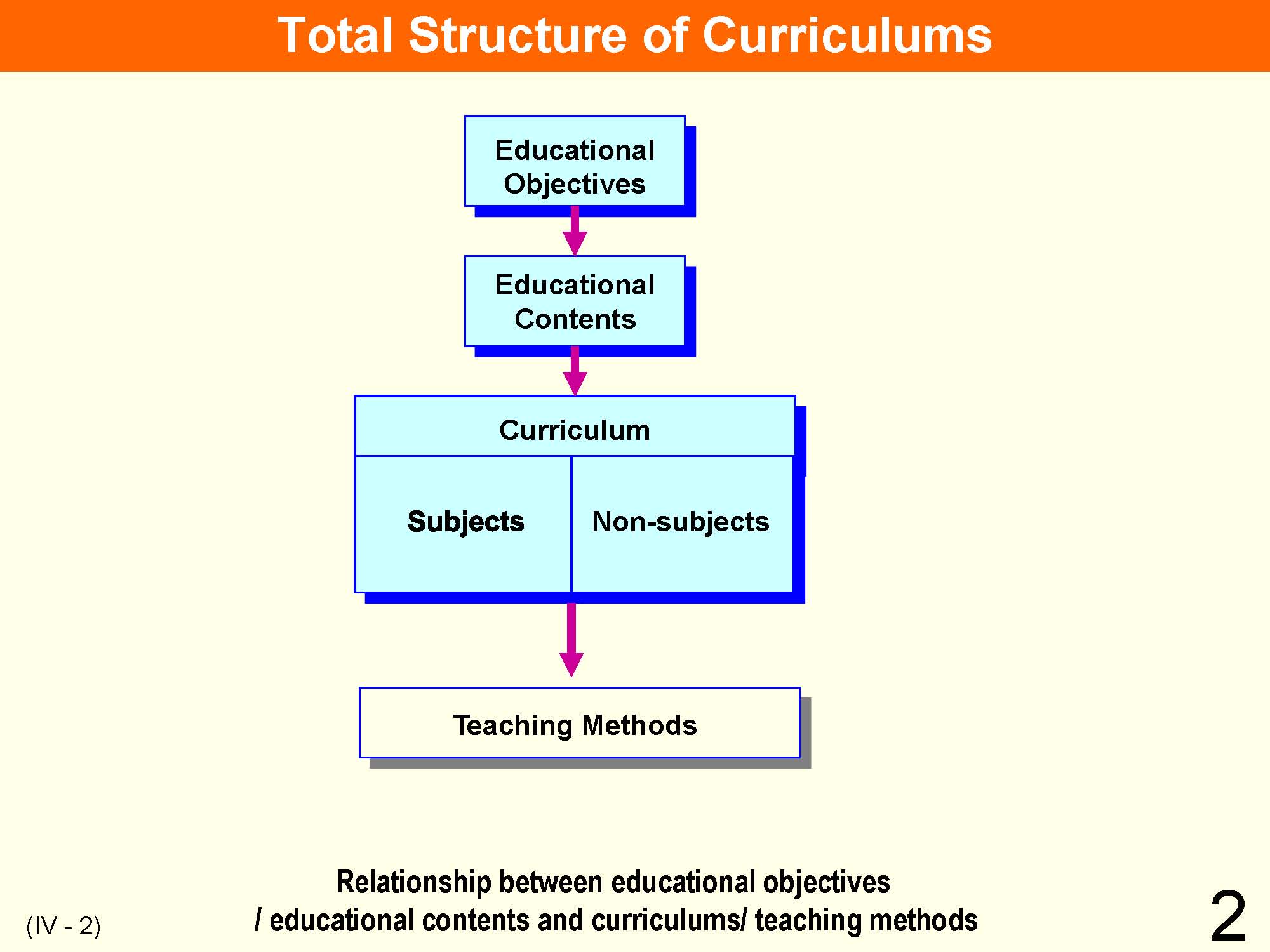 |
“Educational objectives” are concepts of “what kind of human beings are to be nurtured.” In order to achieve such objectives, educational contents must be determined. The educational contents of “what to teach learners” are “curriculums” that have a close relationship with teaching methods (how to teach). The curricula of schools in Japan consist of two areas: “subjects” and “non-subjects.” For example, in elementary schools, according to the Courses of Study revised in 2008, there are nine subjects: “Japanese language,” “social studies,” “arithmetic,” “science,” “lifestyles,” “music,” “drawing and handcrafts,” “home economics” and “physical education.” In “non-subjects,” there are “moral precepts,” “foreign language activities,” “periods of integrated study,” and “special activities.” |
| 3 | 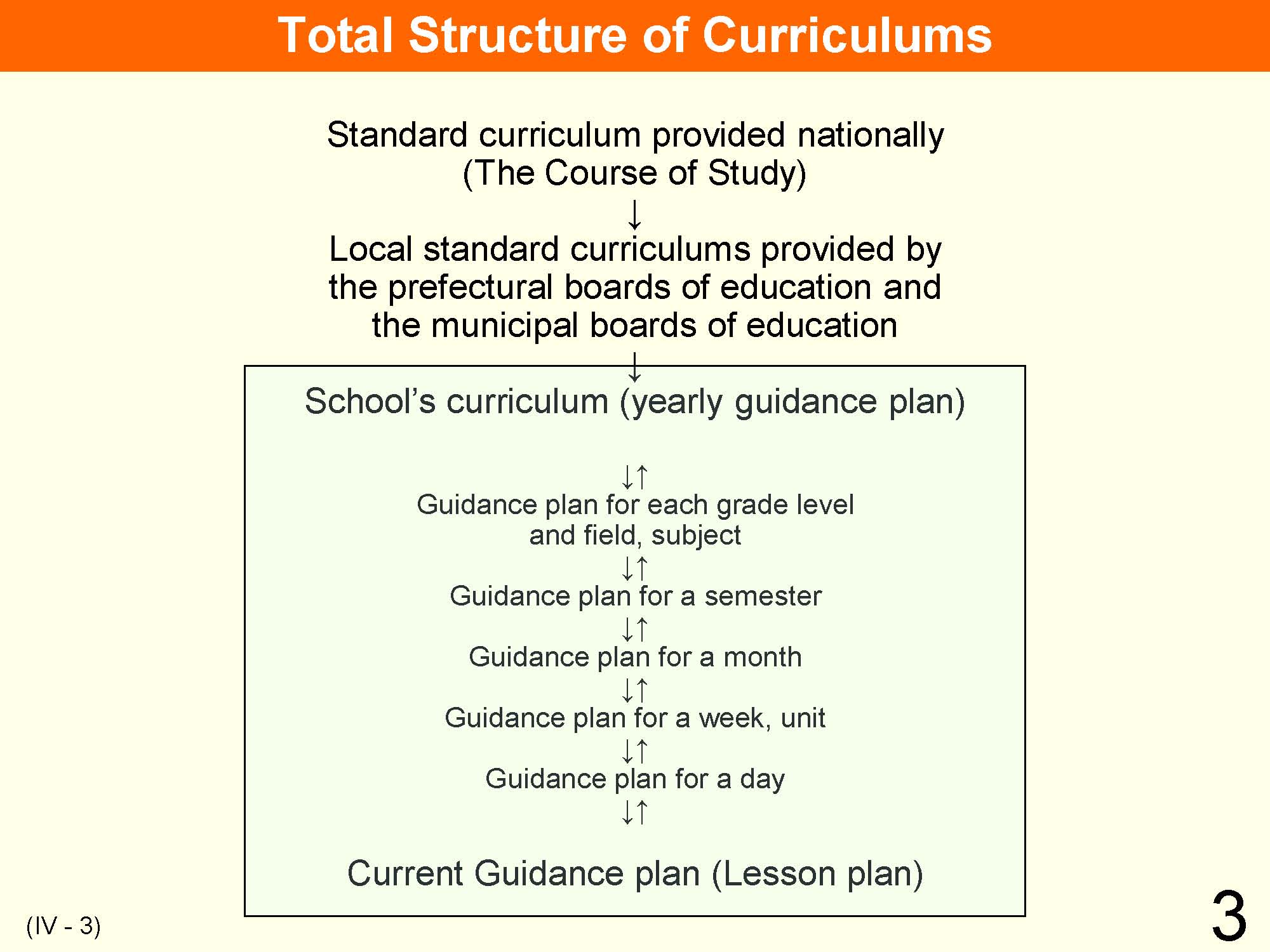 |
In Japan, local standard curriculums provided by the prefectural boards of education and the municipal boards of education, are based on “The Course of Study,” which is the standard nationwide curriculum. Each school makes its “yearly guidance plan” as a general plan at the beginning of the year. This guidance plan provides direction for (1) Guidance plans for grades, fields and subjects, (2) Semester guidance plans, (3) Monthly guidance plans, (4) Weekly and unit guidance plans, (5) Daily guidance plans and (6) Current lesson guidance plans. Plans are gradually made from (1) to (6). These plans are evaluated through actual classes and periodically reexamined. The school also makes its “Course of Study” at the beginning of the year. This plan is made for each subject and extracurricular activity (moral education, special activities, the period of integrated study) at each grade level and for each class. |
| 4 | 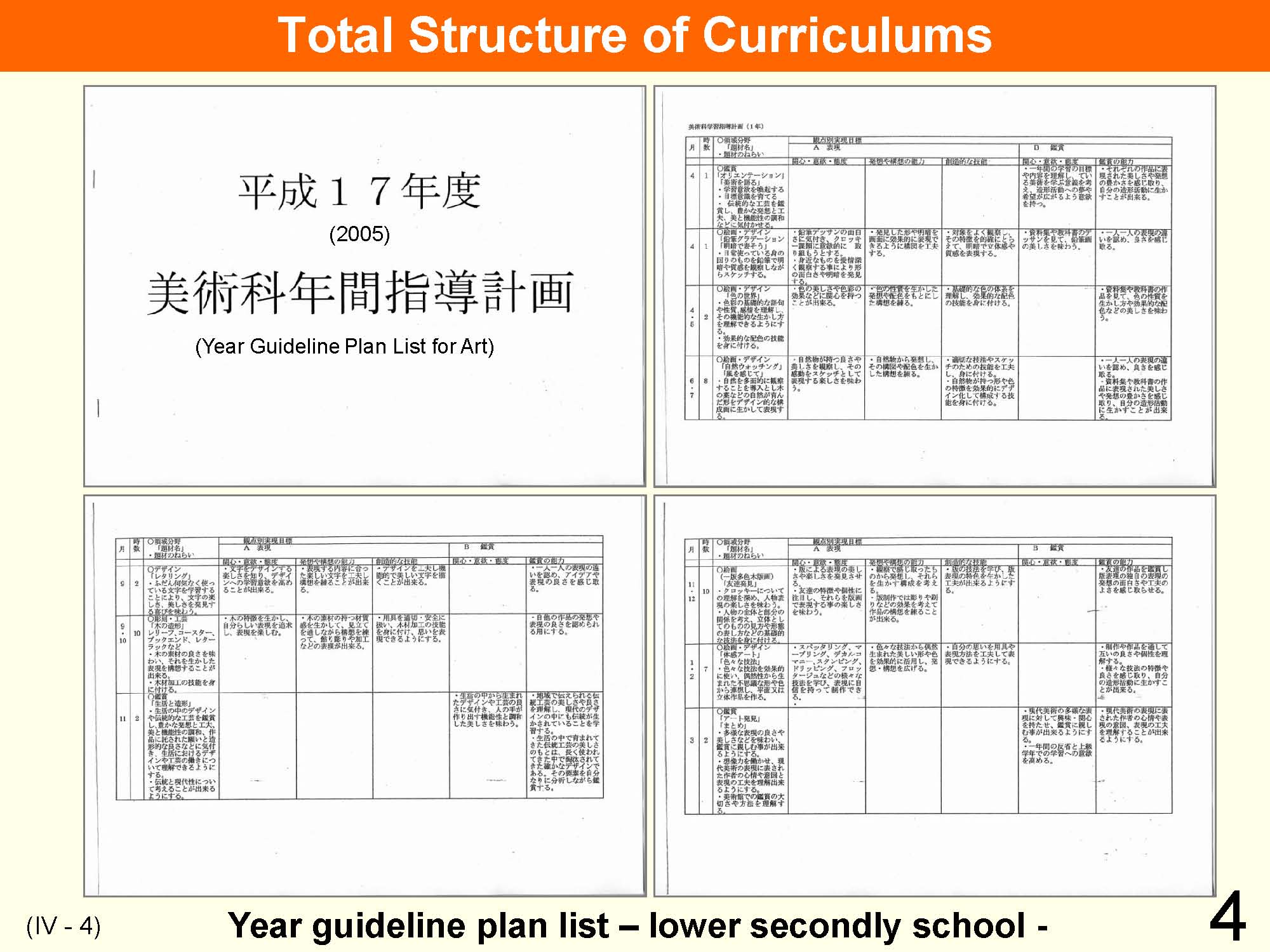 |
The picture above provides one example of “yearly guideline plan list” at a lower secondary school (Art). Using this list, teachers are able to plan yearly instructions for each subject they teach, and also to review their actual lessons in comparison with initial plans. |
| 5 | 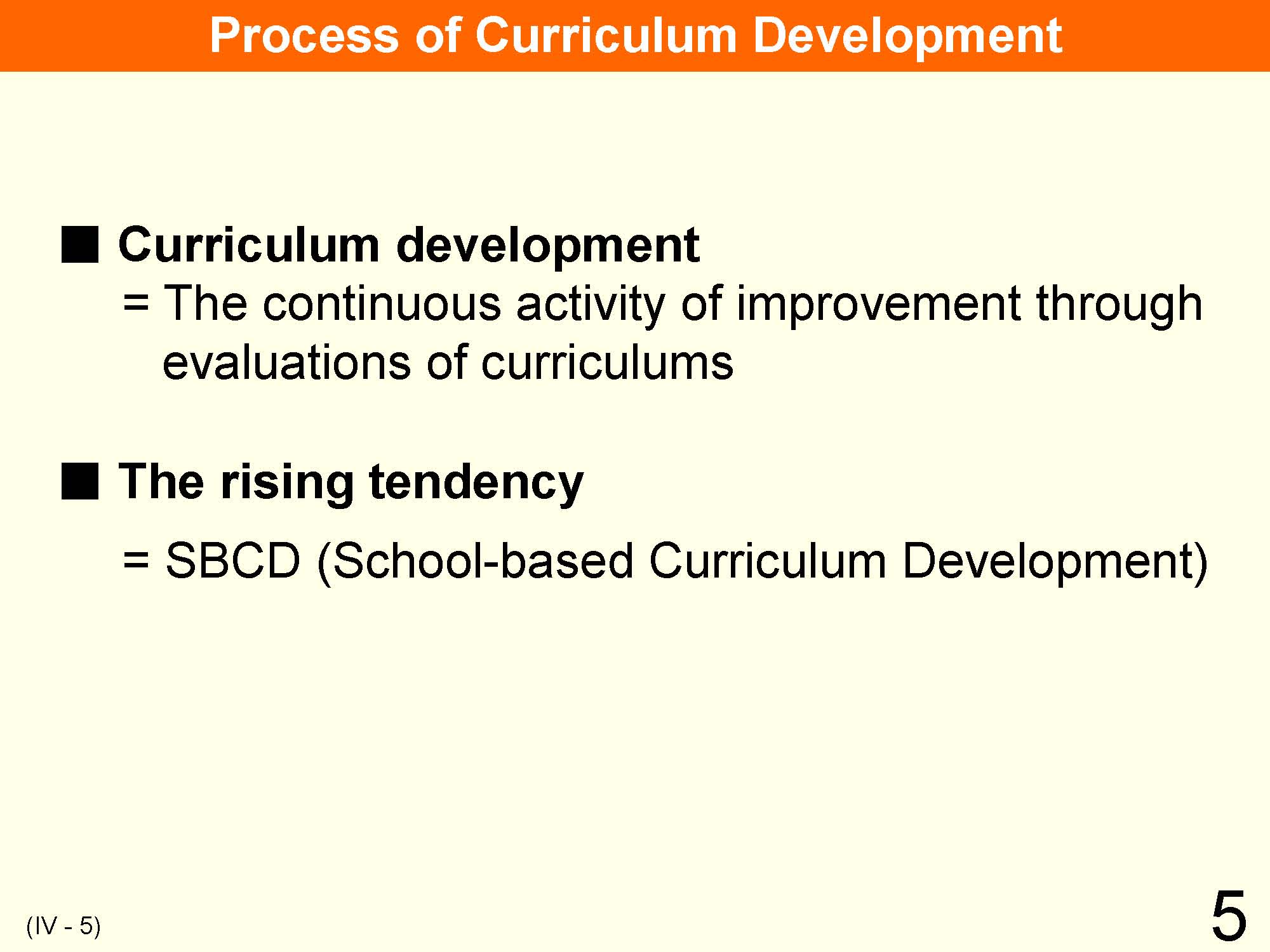 |
Curriculum development is an activity that evaluates a school’s curriculum continuously from the perspective of social change, etc., and then improves it. It includes curriculums at various levels, for instance, schools, communities, and the national curriculum. In Japan, the implementation of the fundamentals of the Course of Study and each school’s full involvement in curriculum development commenced after CERI (Center for Educational Research and Innovation) of the OECD advanced an idea called SBCD (School-based Curriculum Development). |
| 6 | 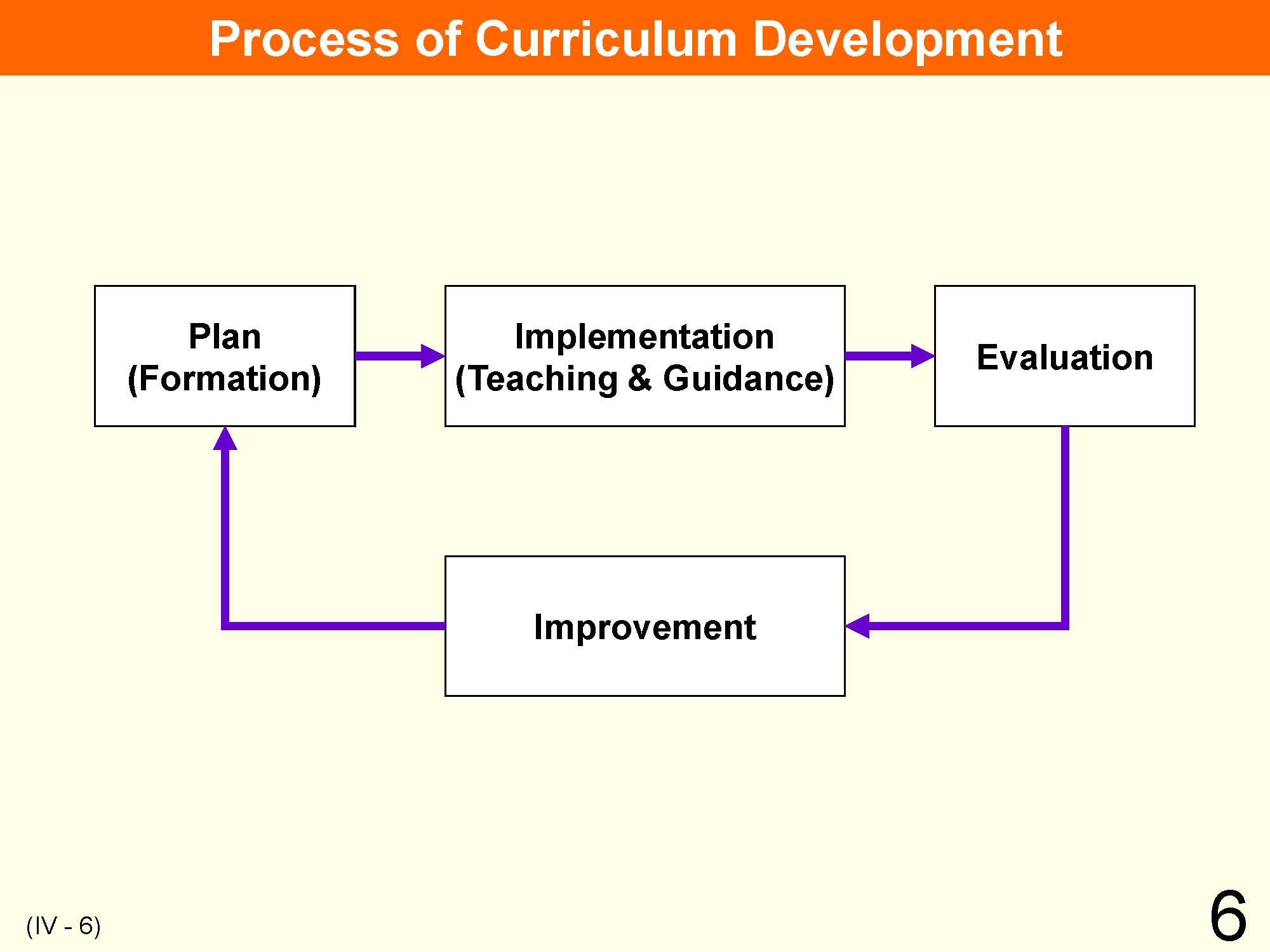 |
Curriculum development is a dynamic process of curriculum improvement through “doing (teaching and guidance)” and evaluation of the results of a planned curriculum. “Teaching” is one of the practice models in the curriculum development process. It is important that the unity of “process of teaching improvement” be incorporated into curriculum development. |
| 7 | 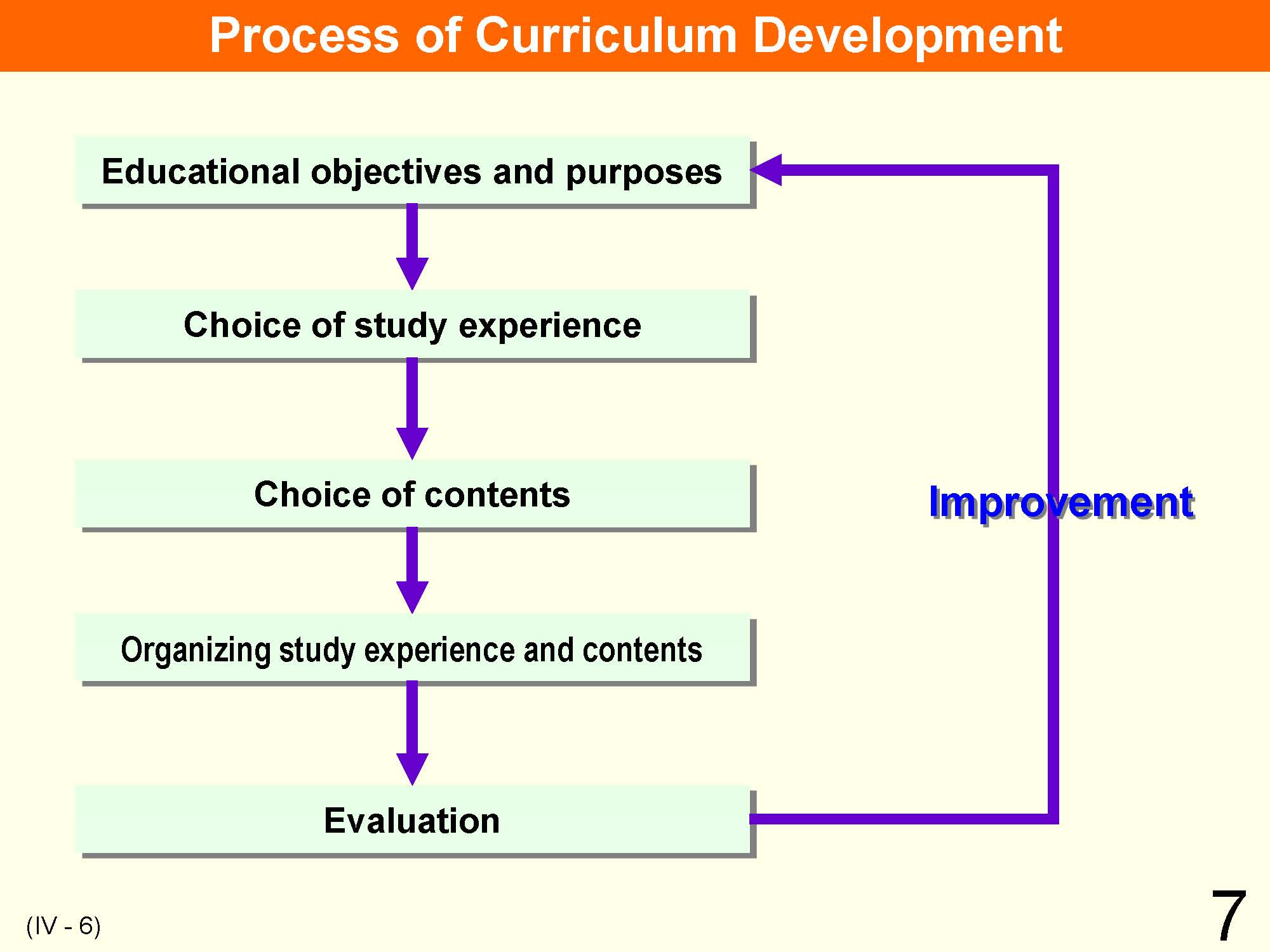 |
The above chart illustrates the process of curriculum development in Japan. This process needs a set of procedures which are to (1) set educational objectives, (2) select study experiences, (3) select contents,(4) organize study experiences and contents, (5) perform evaluations, and (6) make improvements. By this set of practical procedures, each school develops its own curriculum. |
| 8 | 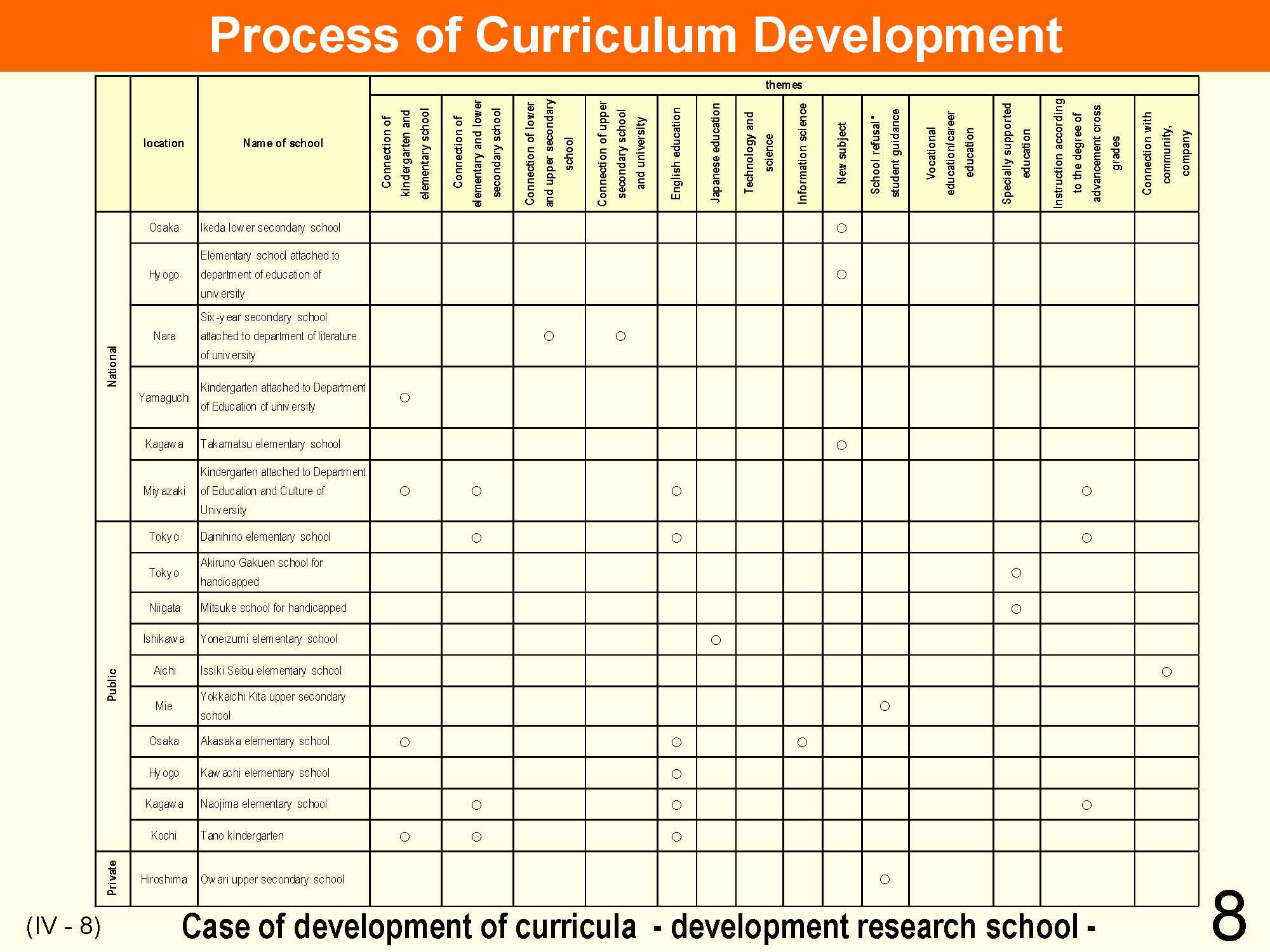 |
This is one example of the themes of the “Development Research School” laid out by the Ministry of Education, Culture, Sports, Science and Technology (MEXT) in 2002. In Japan, the importance of developing creative and practical curricula at each school is emphasized. Research into original and new curricula development, such as at various “Development Research Schools”, is in progress at national and local levels. |
| 9 | 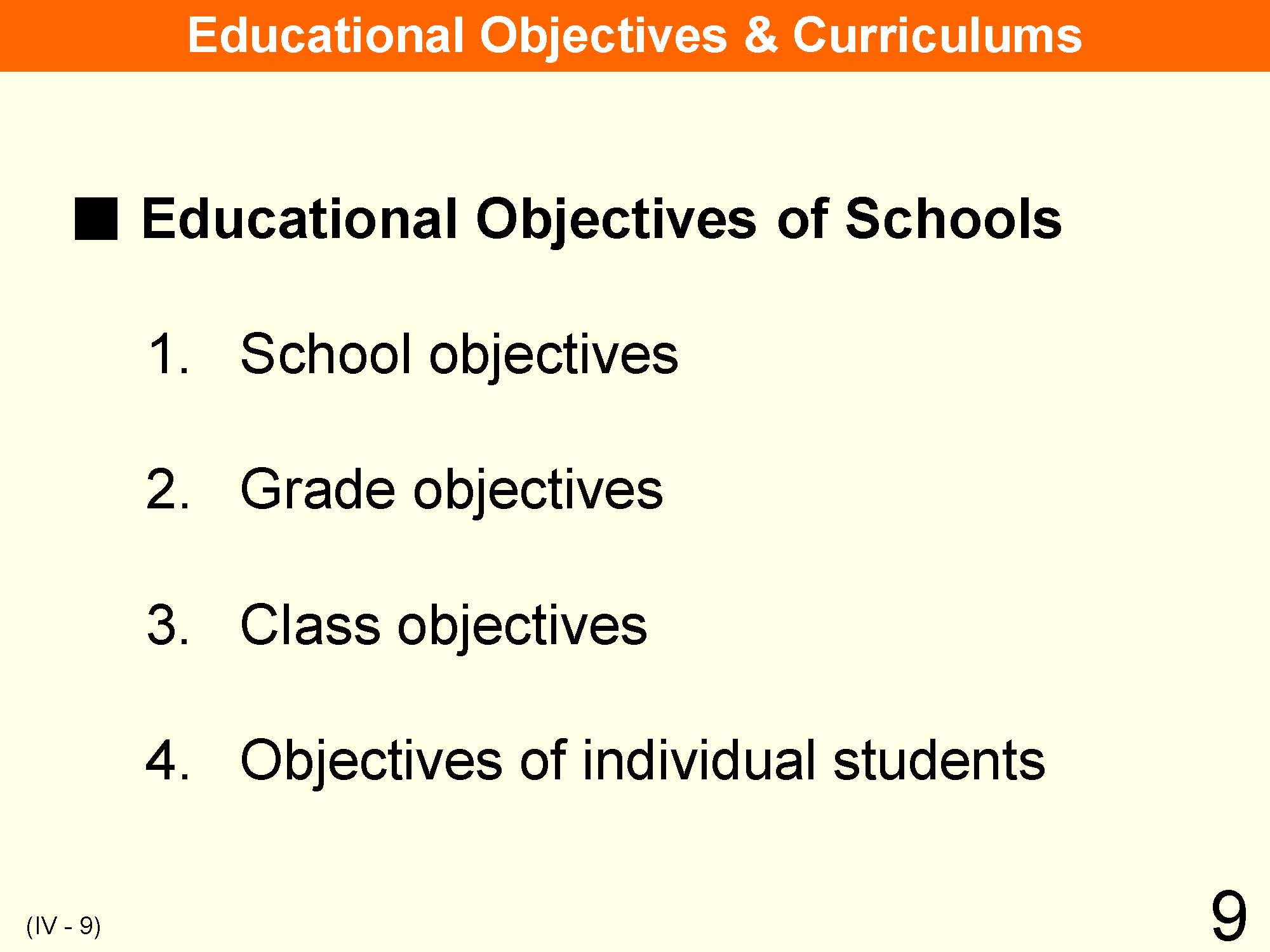 |
Educational objectives of schools are ideas formulated by each school on what education ought to be. They indicate the concept of the ideal type of person that each student should become through participation in school educational activities. Educational objectives of schools can be divided into 4 levels: (1) school objectives, (2) grade objectives, (3) class objectives, and (4) objectives of individual students. |
| 10 | 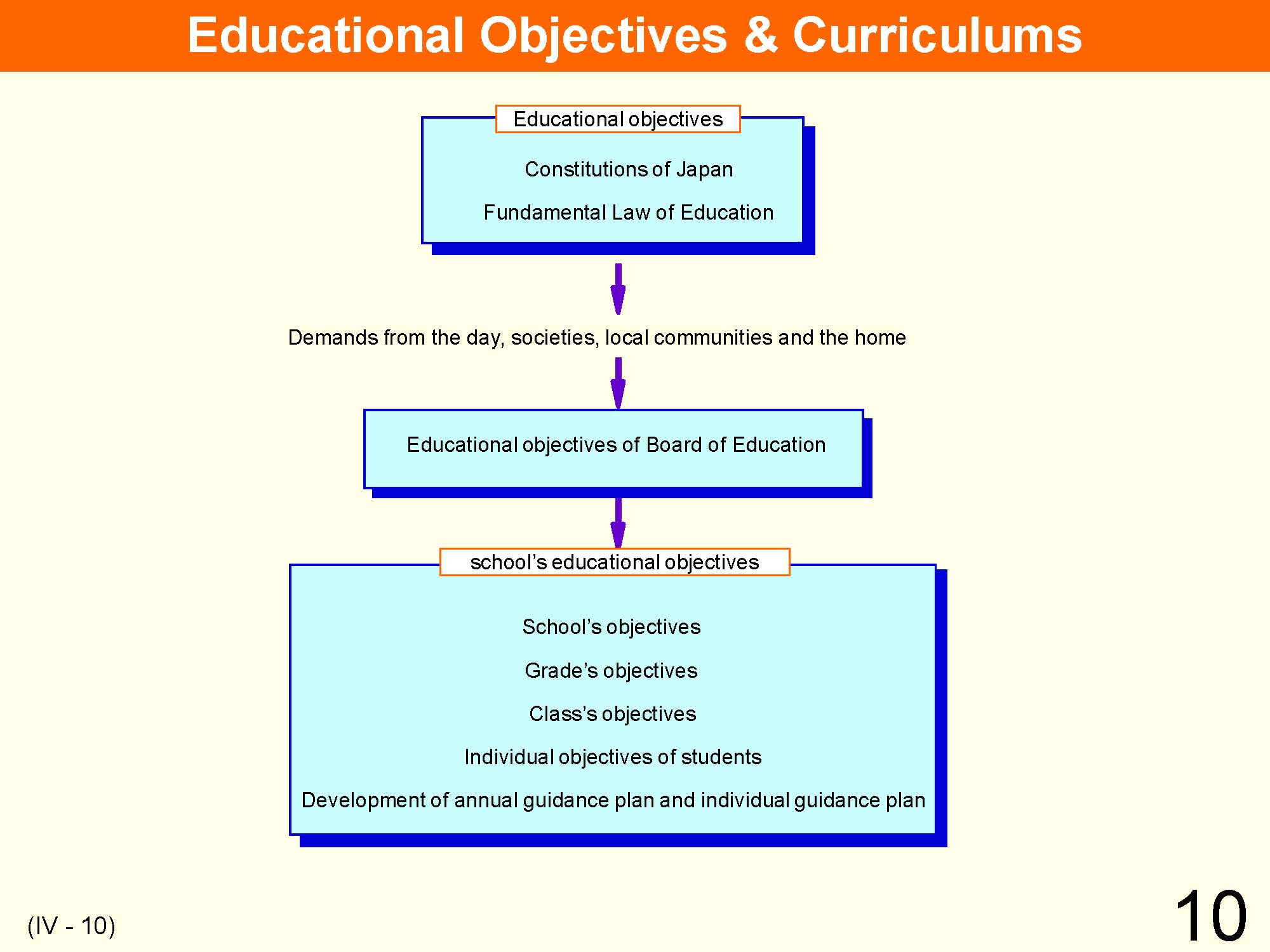 |
In Japan, the Constitution and the Fundamental Law of Education provide educational objectives, and on the basis of them the Boards of Education and schools determine educational objectives. School educational objectives show each school’s educational philosophy. various educational activities are carried out in schools to achieve the objectives. |
| 11 | 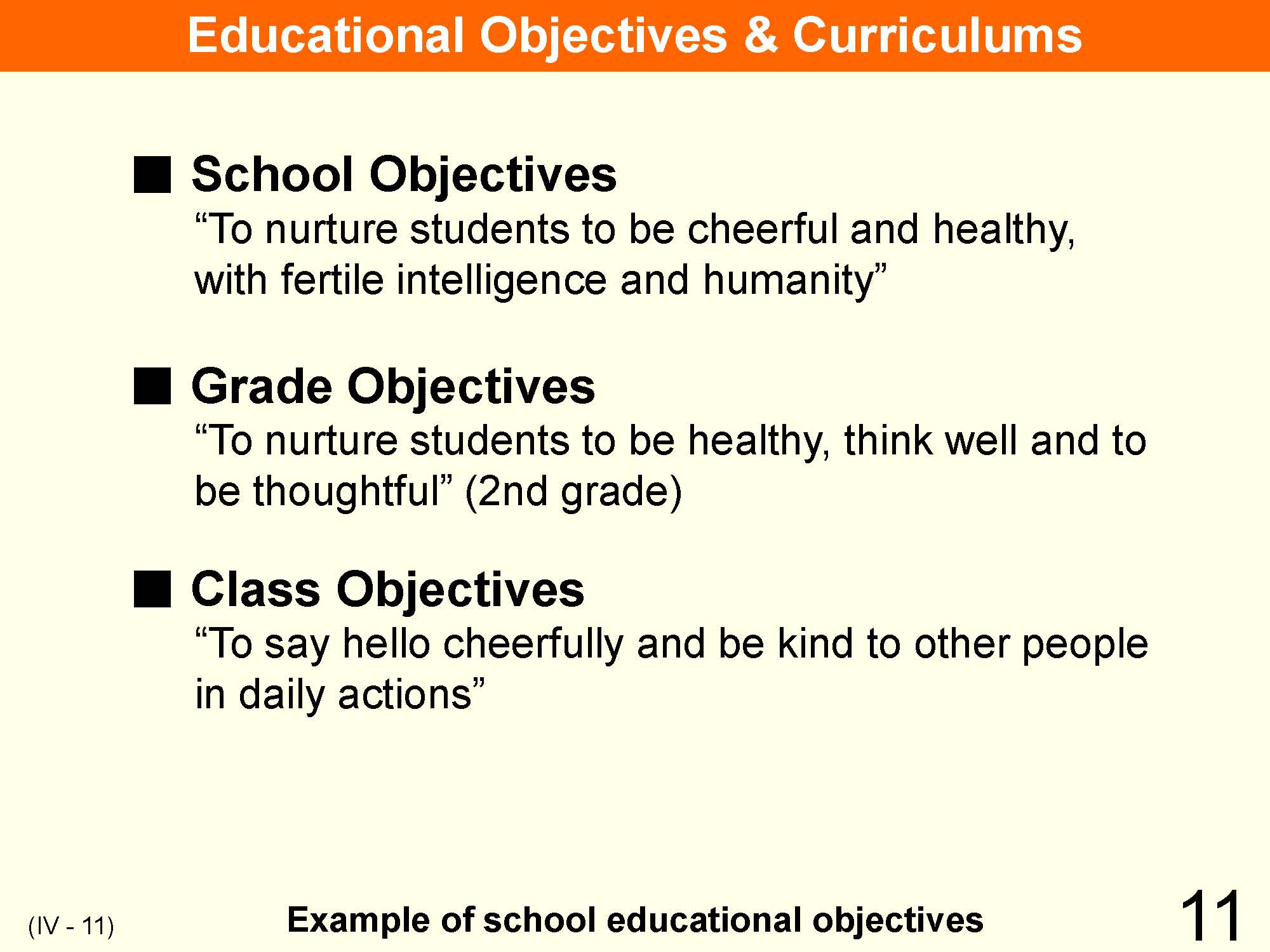 |
This is an example of educational objectives at an elementary school. School educational objectives consist of ‘school objectives,’ ‘grade objectives’ and ‘class objectives.’ It can be said that the objectives of school activities become more practical over time. |
| 12 | 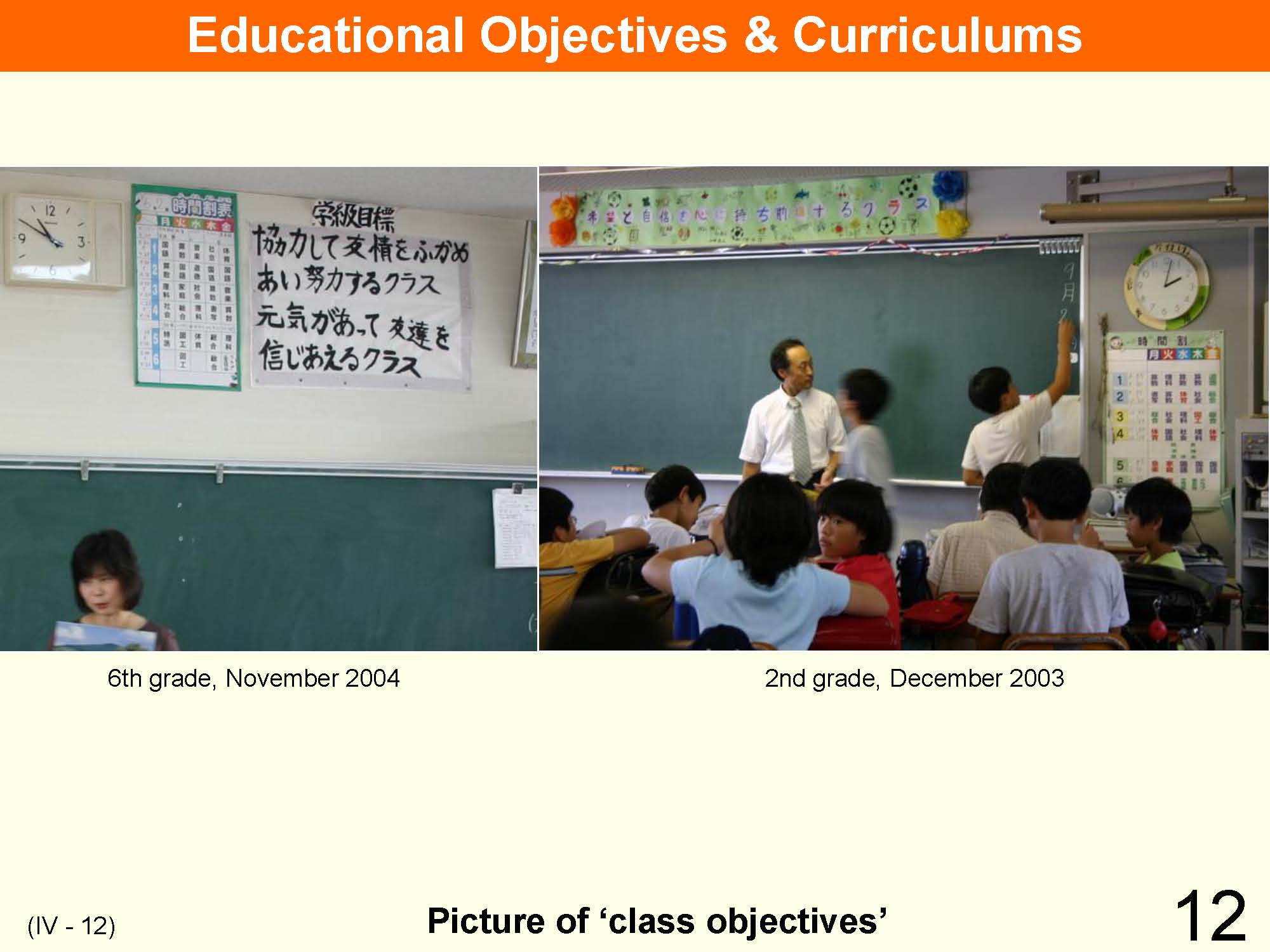 |
This picture is an example of posted ‘class objectives.’ Among a variety of posters in the classroom, ‘class objectives’ are educational objectives for all the students who belong to the class to aim for during the school year. These are posted where students can see them daily. ‘Class objectives’ play an important role in assisting each student to go over and to reflect on daily personal educational activities and priorities. |
| 13 | 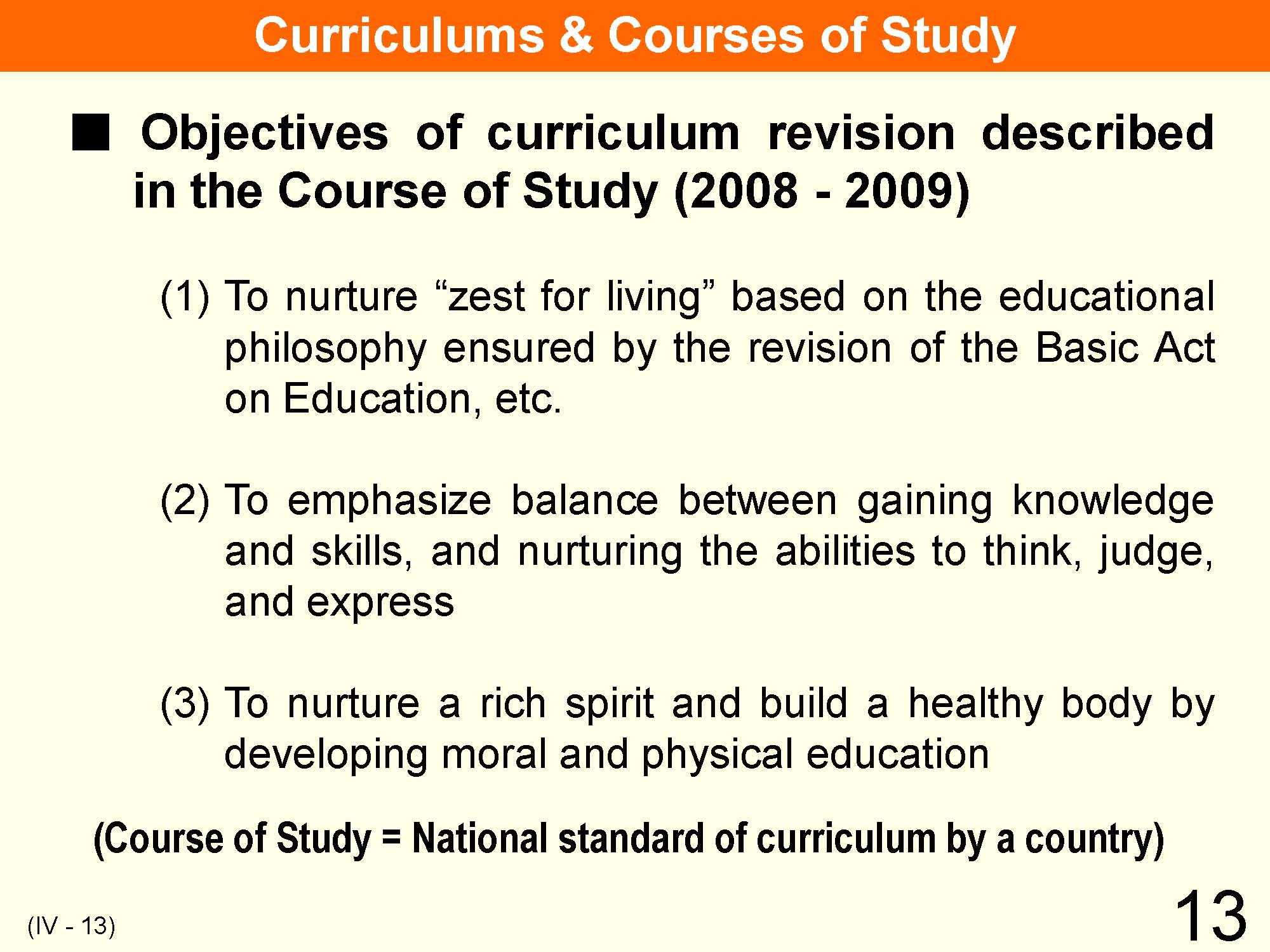 |
In Japan, the official “Course of Study” is the basis of the national curriculum which is revised once in about every 10 years. The most recent version of the Course of Study was issued on March 28th 2008 comprising the Course of Study for elementary schools, the Course of Study for lower secondary schools, and the Course of Study for kindergartens, and the Course of Study for upper secondary schools and the Course of Study for special needs were issued on March 9th 2009. |
| 14 | 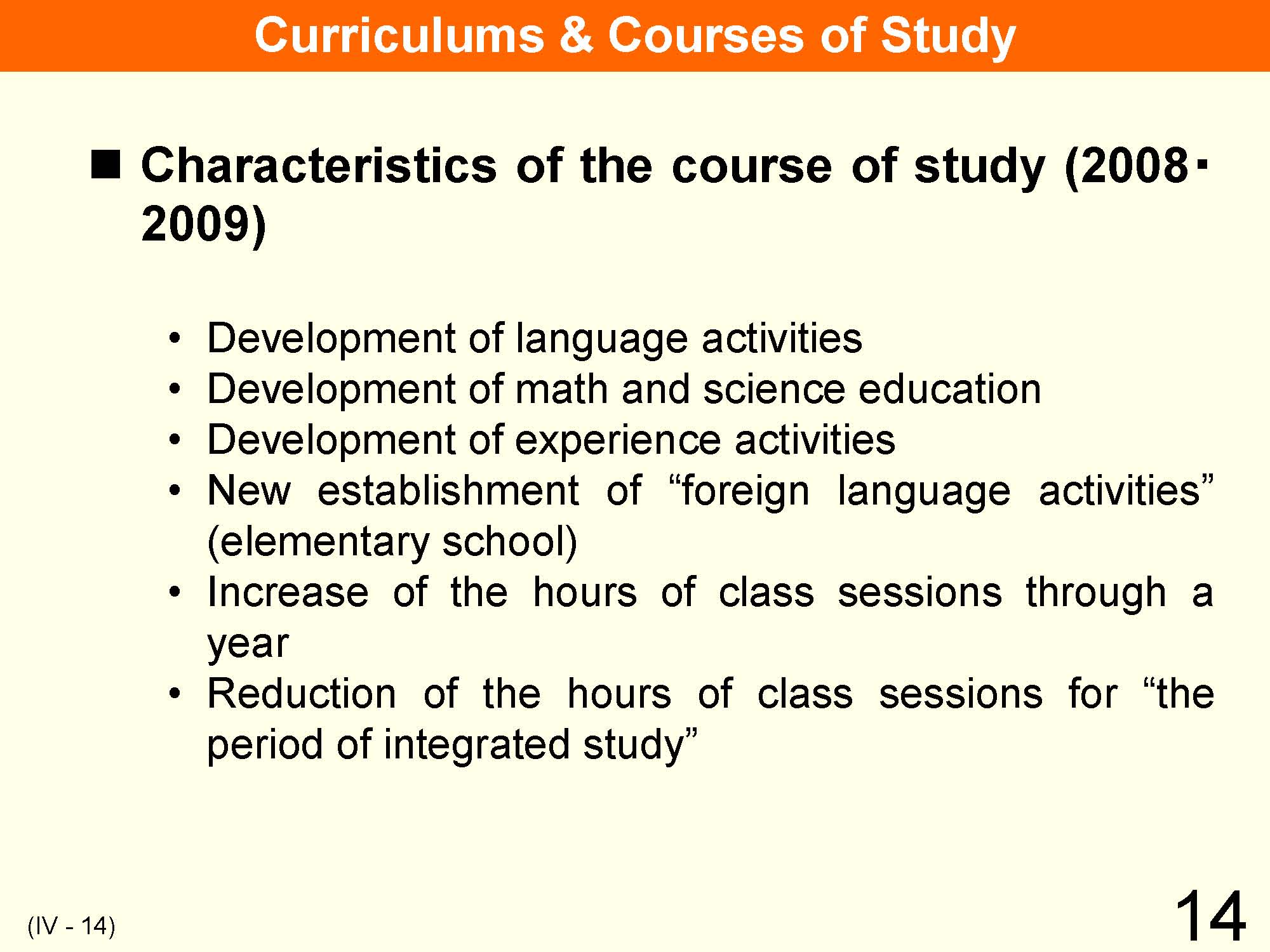 |
● Development of language activities: As language is the foundation of intellectual activities and communication, such learning activities as recording, explanation, statement, discussion, etc. should be developed in all subjects. ● Development of math and science education: Developing systematic teaching contents of math and science education, which is a foundation for technology ● Development of experience activities: Enhance group lodging events or nature experiences (elementary school), job experiences (lower secondary school) to nurture social skills and a rich humanity ● New establishment of “foreign language activities” (elementary school): “foreign language activities” are introduced to 5th and 6th graders of elementary school to foster behavior to communicate actively and to deepen understanding of language and culture. ● Increase of the hours of class sessions through a year: To enhance the above learning activities, the hours of the national language, social science, arithmetic and math, science and foreign languages were increased. |
| 15 | 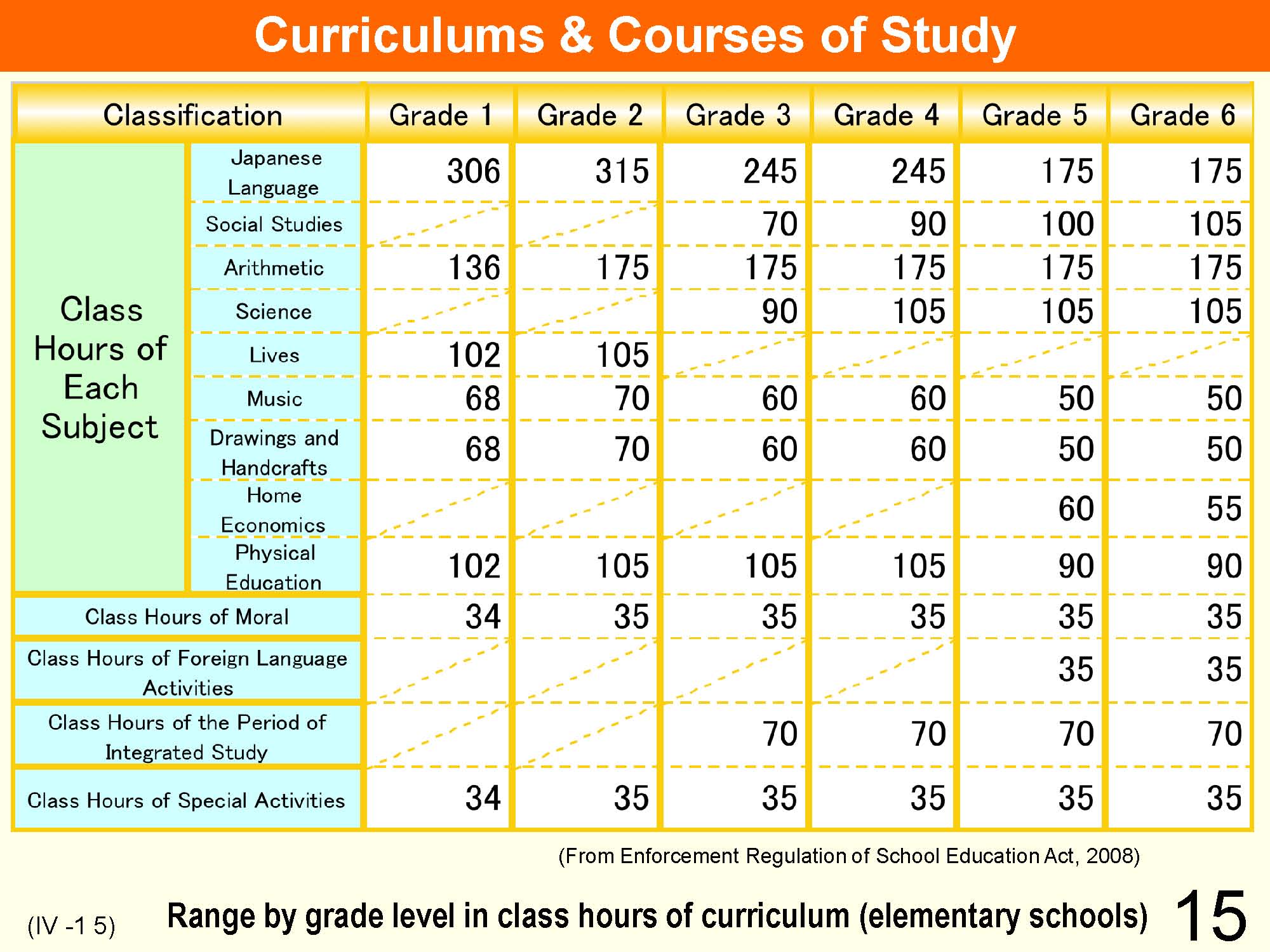 |
At elementary schools, each class is 45 minutes long. The total of class hours for special activities are counted as hours for class activities (excluding school lunch periods), which is provided in the Course of Study for elementary school. (The day of a student --> Ⅸ 29) |
| 16 | 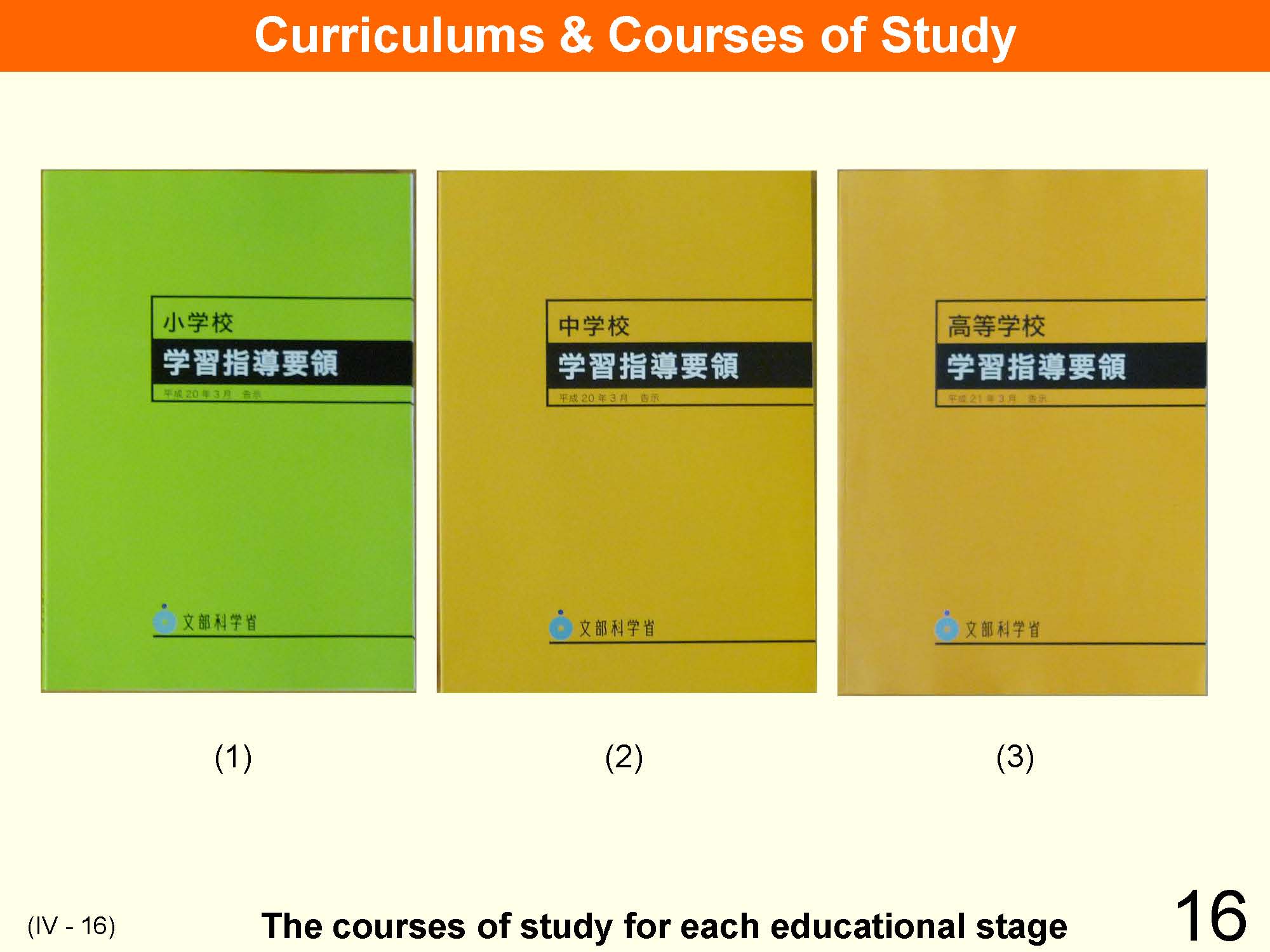 |
(From the left), (1)The Course of Study (for elementary schools), (2) the Course of Study (for lower secondary schools), (3)the Course of Study (for upper secondary schools) |
| 17 | 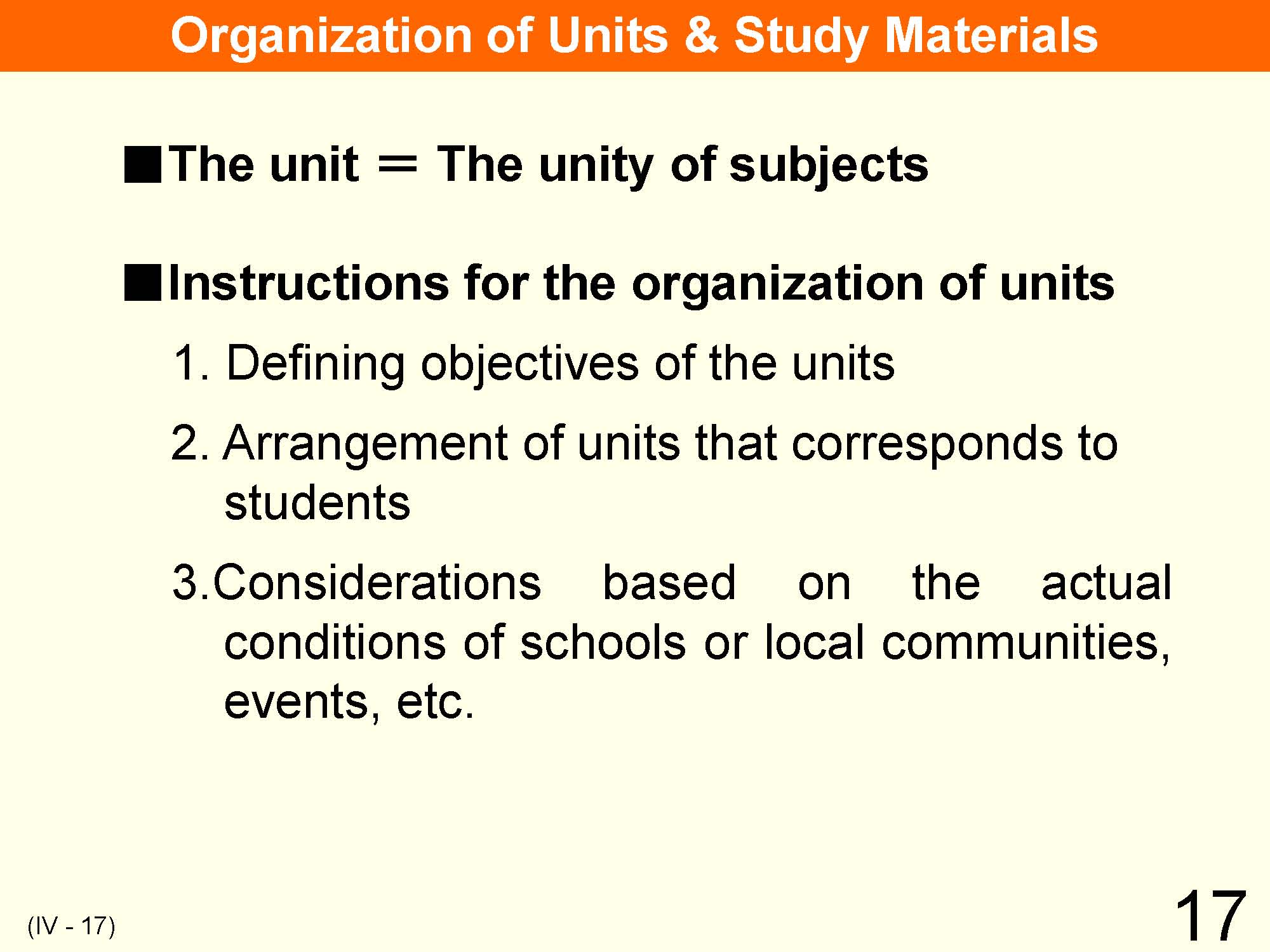 |
Teaching contents are organized in some units according to the actual conditions of students’ achievements based on each grade’s and subject’s objectives. The organization of teaching contents needs to: 1. Clarify each subject’s objectives and select proper teaching contents carefully to achieve objectives of units. 2. Arrange units to fit students, considering teaching contents’ quality of systems and development 3. Arrange school events based on the school’s and local community’s actual conditions and seasons. |
| 18 | 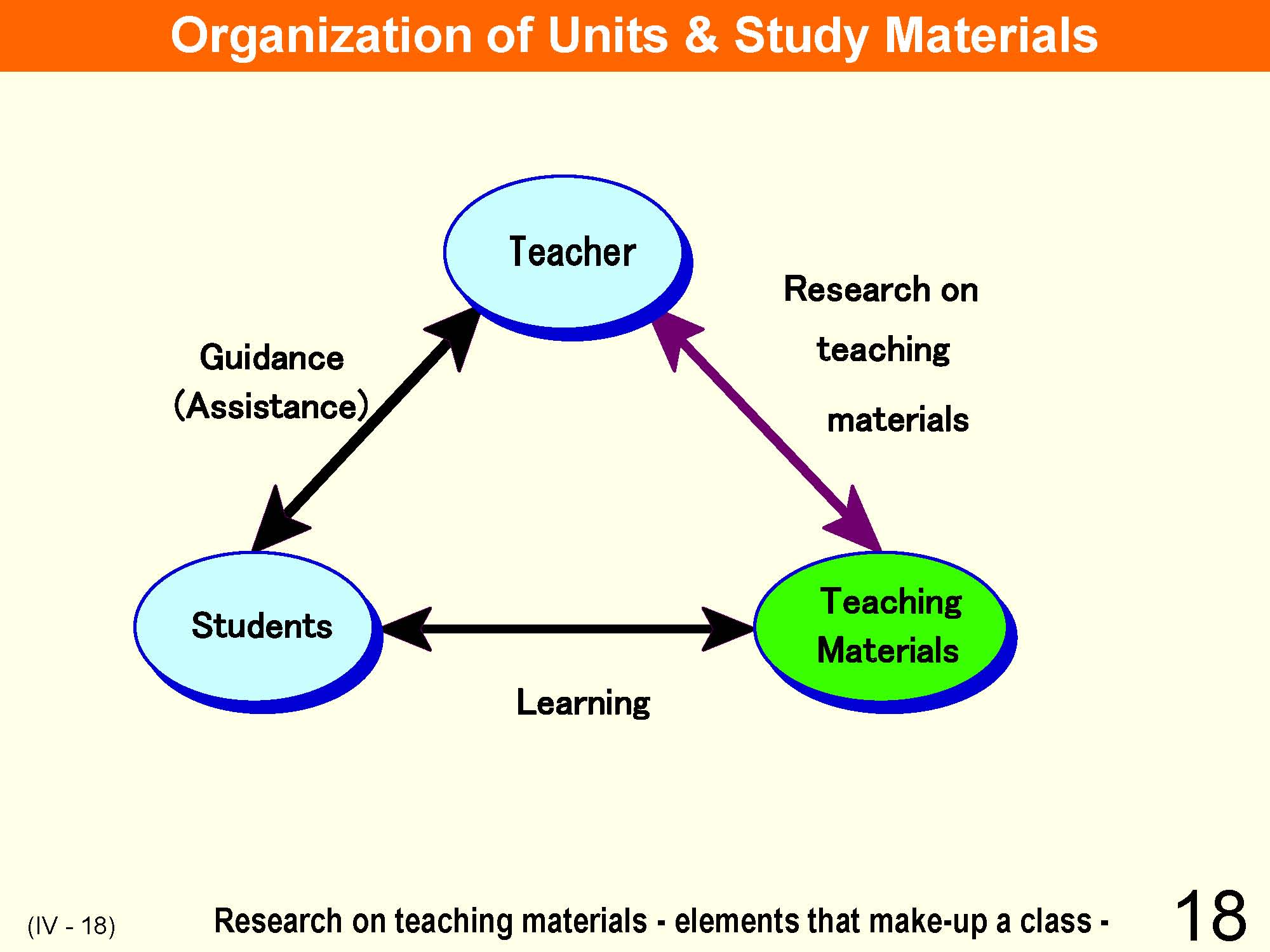 |
“Teaching materials” are the important elements that constitute a class with “students” and “teachers.” The elements that shape the contents to be taught and in a class are “teaching materials.” Textbooks are the main teaching materials while other items include documents, reference materials and objects which teachers select from the daily life of students. An activity under which a teacher selects, interprets, and organizes “teaching materials” in the context of class objectives is called “research on teaching materials.” A teacher spends a long time to conduct “research on teaching materials” for use in teaching classes. |
| 19 | 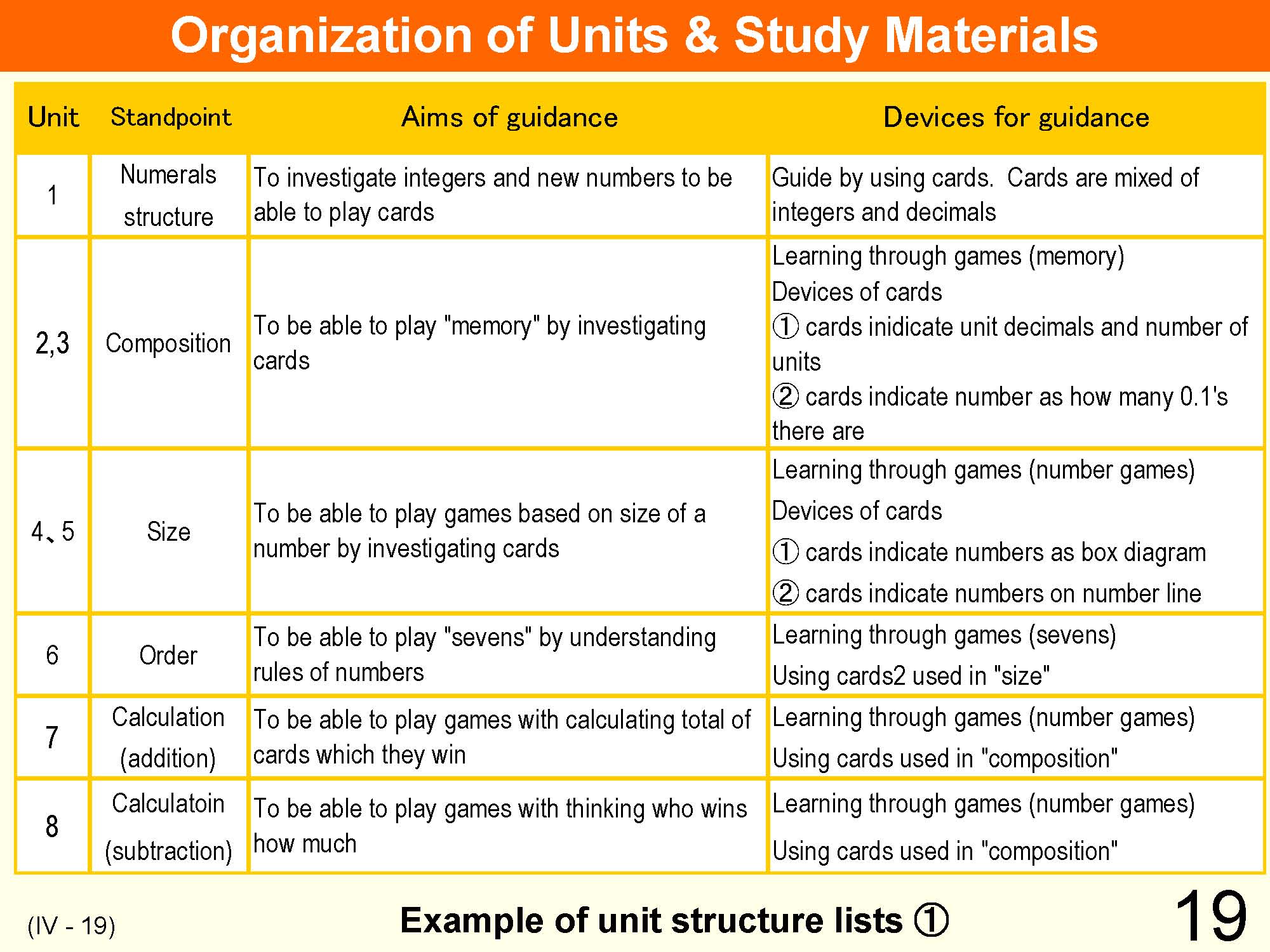 |
An example of a list of the unit structure for an arithmetic lesson at an elementary school. |
| 20 | 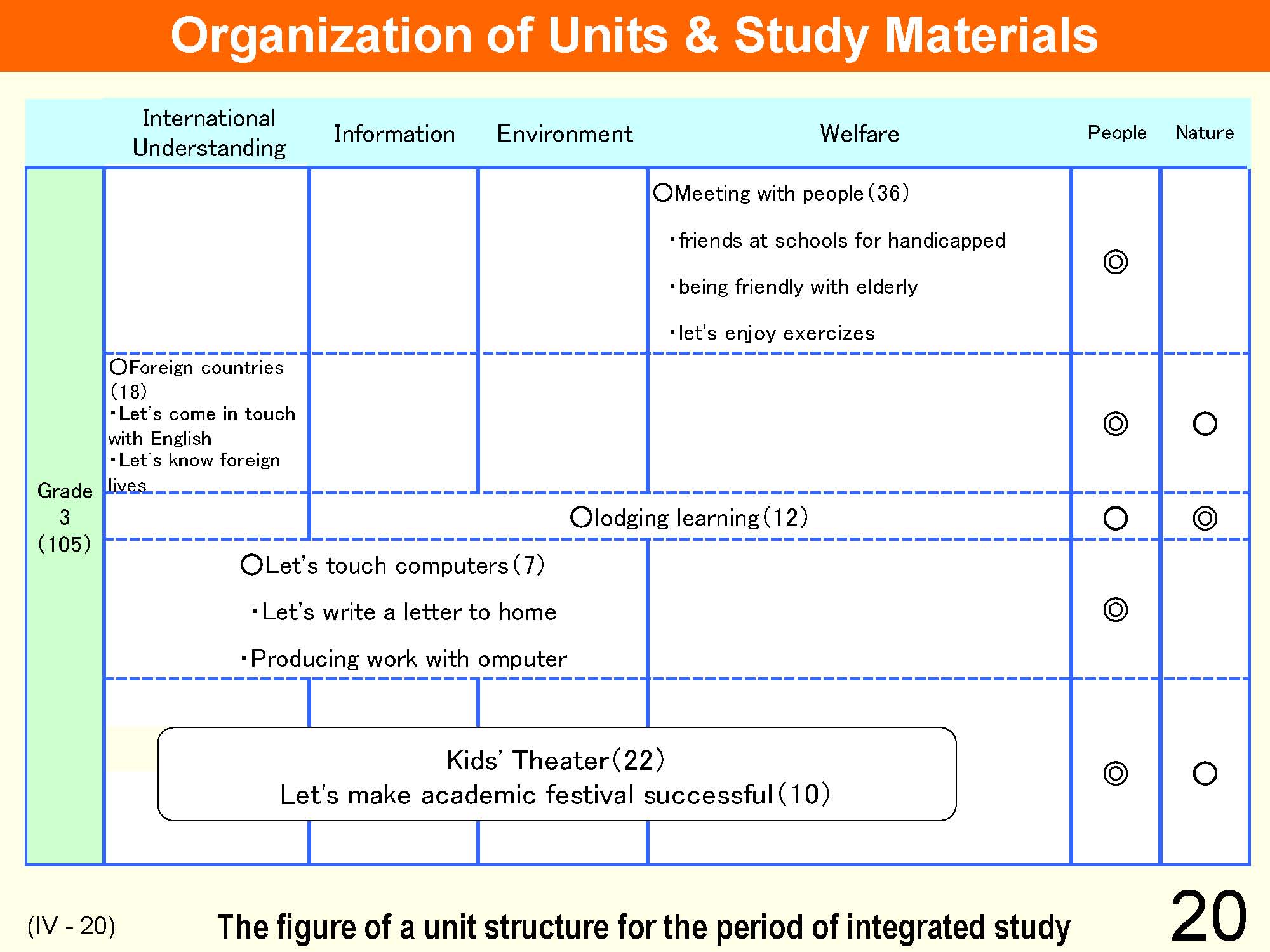 |
The above picture consists of a figure of a unit structure for a school’s period of integrated study. It enables one to conceptualize one year curricula by units. |
| 21 | 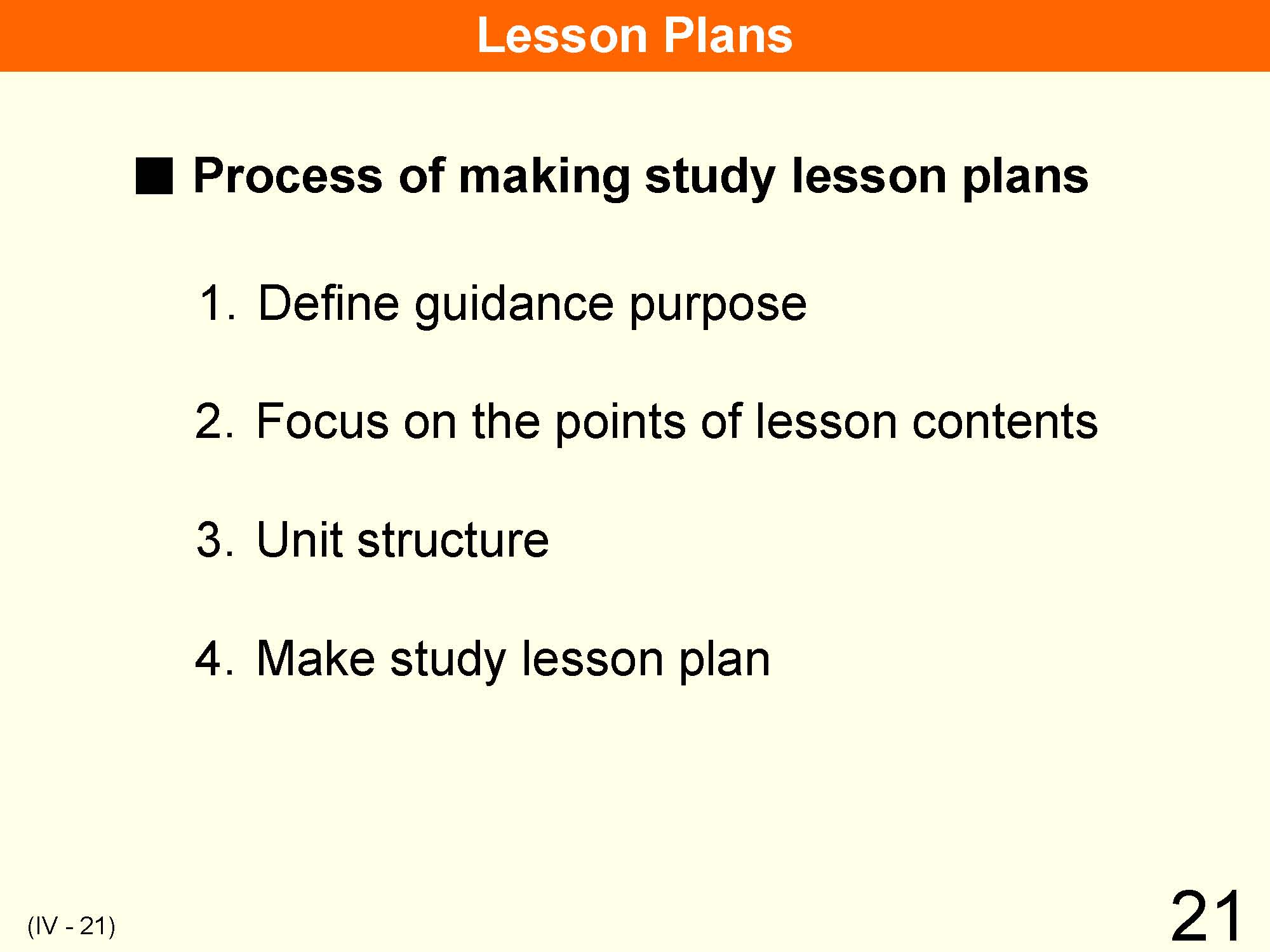 |
A “guidance plan” is a specific plan made on the basis of school curriculum. On the basis of the “Guidance plan” and “Unit structure” as a general perspective, individual class “study lesson plans” per period are made. By making a “study lesson plan,” teachers can plan the class developmental process for a period and prepare guidance suitable for children’s actual conditions. |
| 22 | 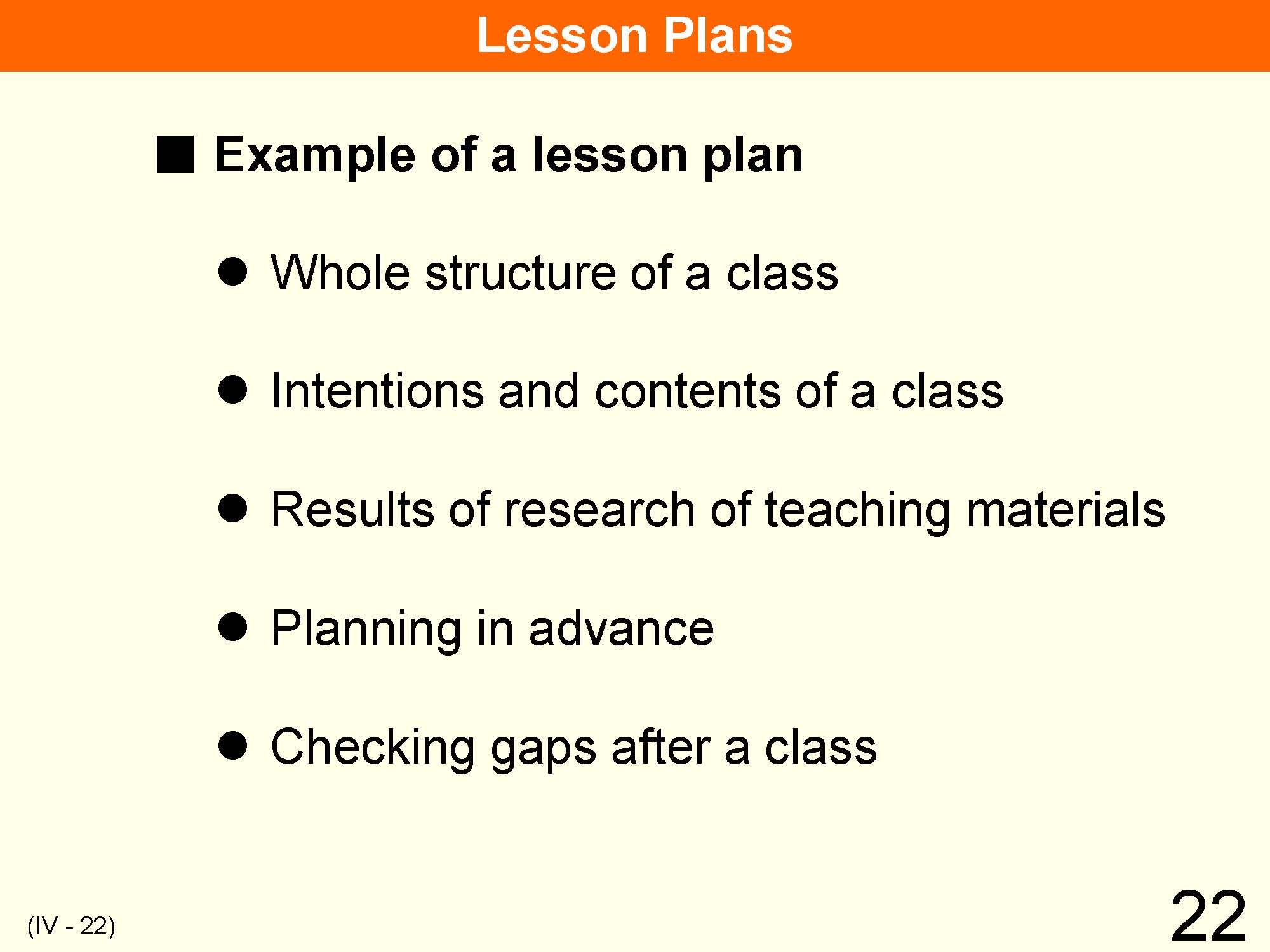 |
Subsumed within “Lesson plans” are all the outcomes based on class planning and research on teaching materials done by a teacher, including his / her ideas of education and educational instruction. The “Lesson plan” is a blueprint with intentions and structures of each class that is prepared to pre-plan the class. The “Lesson plan” is also useful to help improve the way teachers teach. By reviewing guidance plans, teachers can determine where there are instruction gaps. This allows them to adapt the structure of their future classes in a way to try to fill in those gaps. |
| 23 | 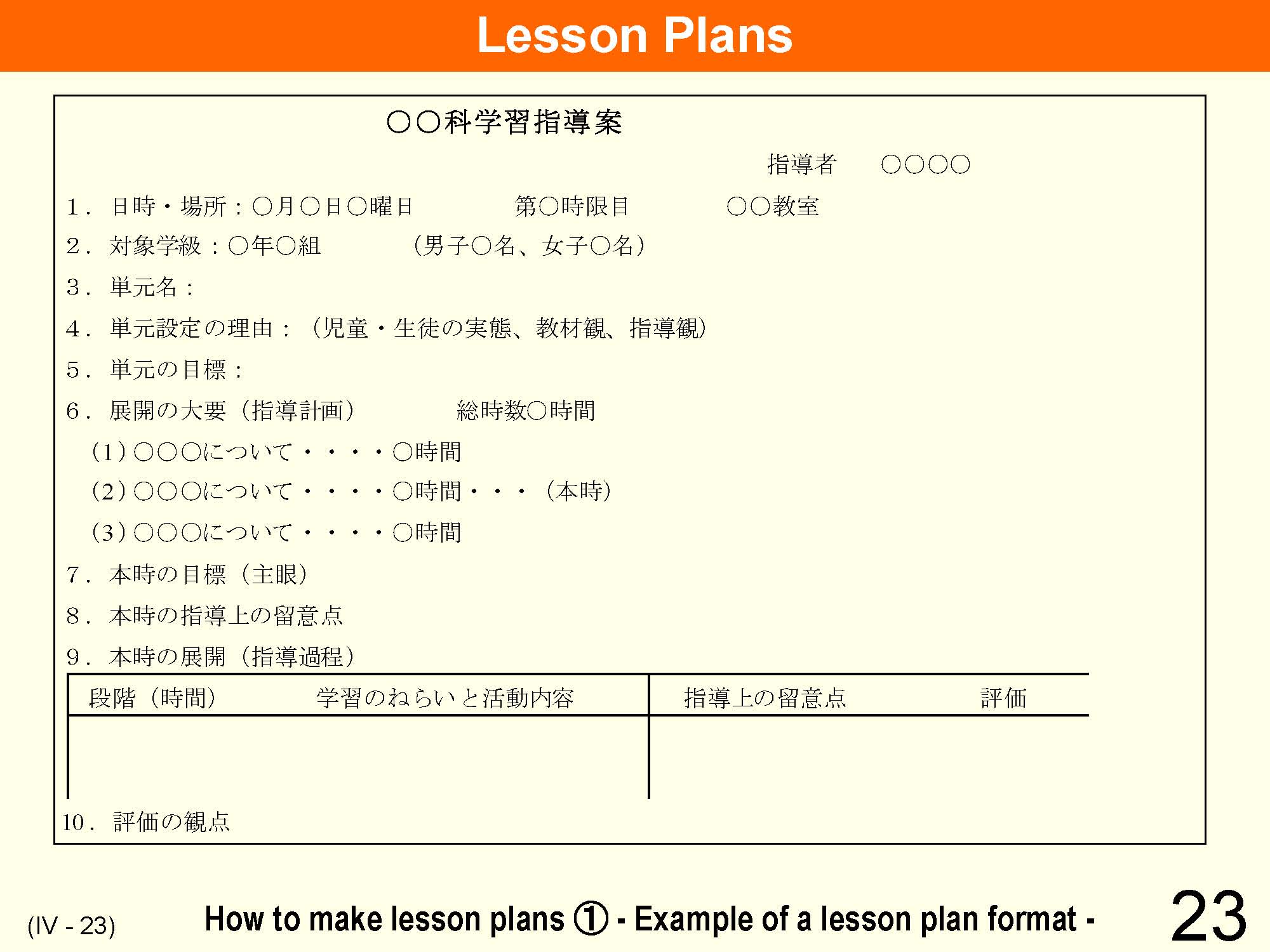 |
In the above lesson plan, in addition to the name of the instructor, date, and class, additional information includes (1) name of the unit (2) the reason for the unit setting (3) objective of the unit (4) plan for the unit (5) objective of this class (6) guidance process for this class. For (2), teachers write about how they should teach, what they should use, and their views of the students in their class. In this unit, and for (6), they outline the process of the class hour from the beginning through conclusion. |
| 24 | 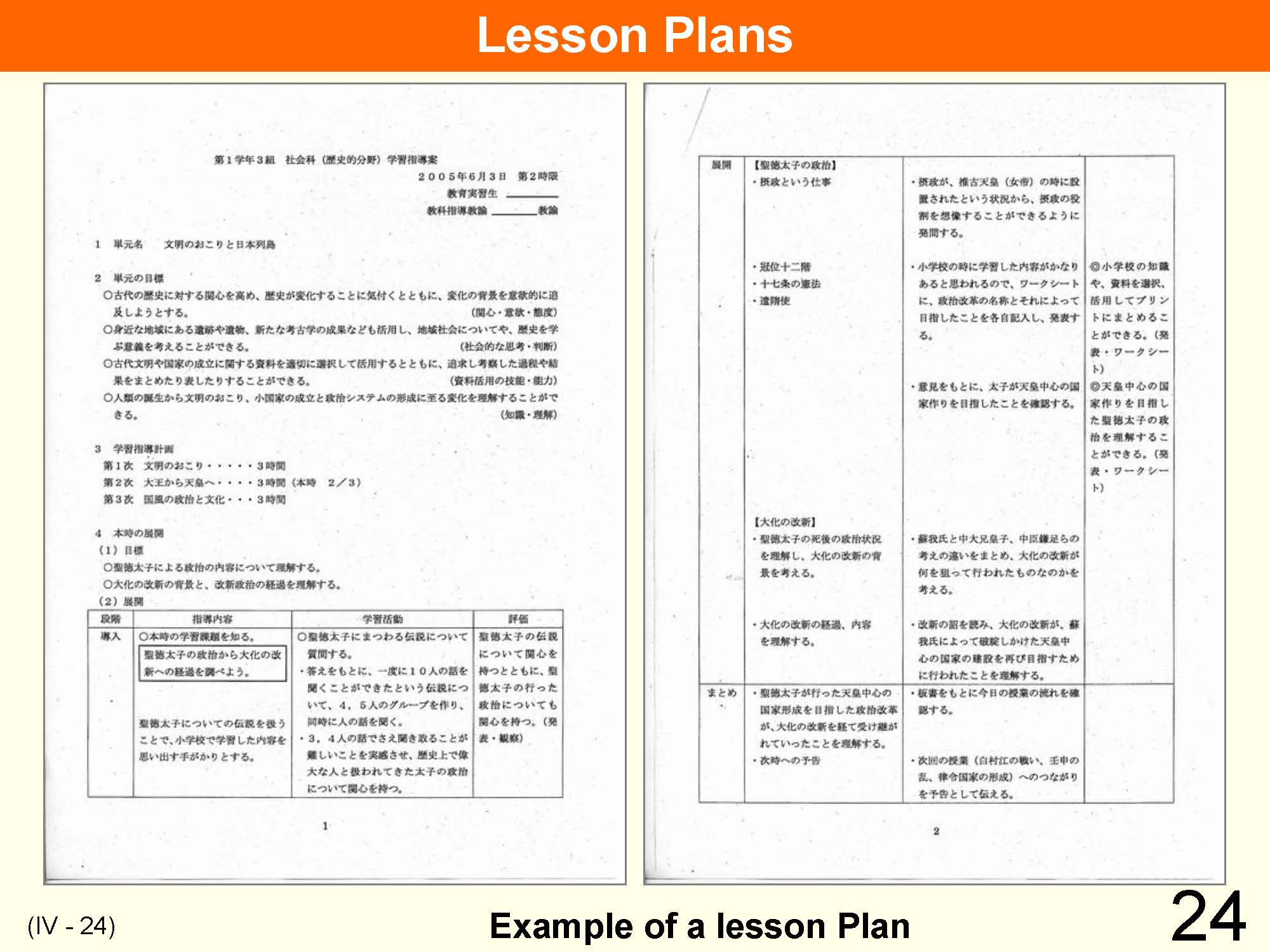 |
(Picture) The above picture provides an example of a lesson plan (1st grade of lower secondary school, Japanese History). |
| 25 | 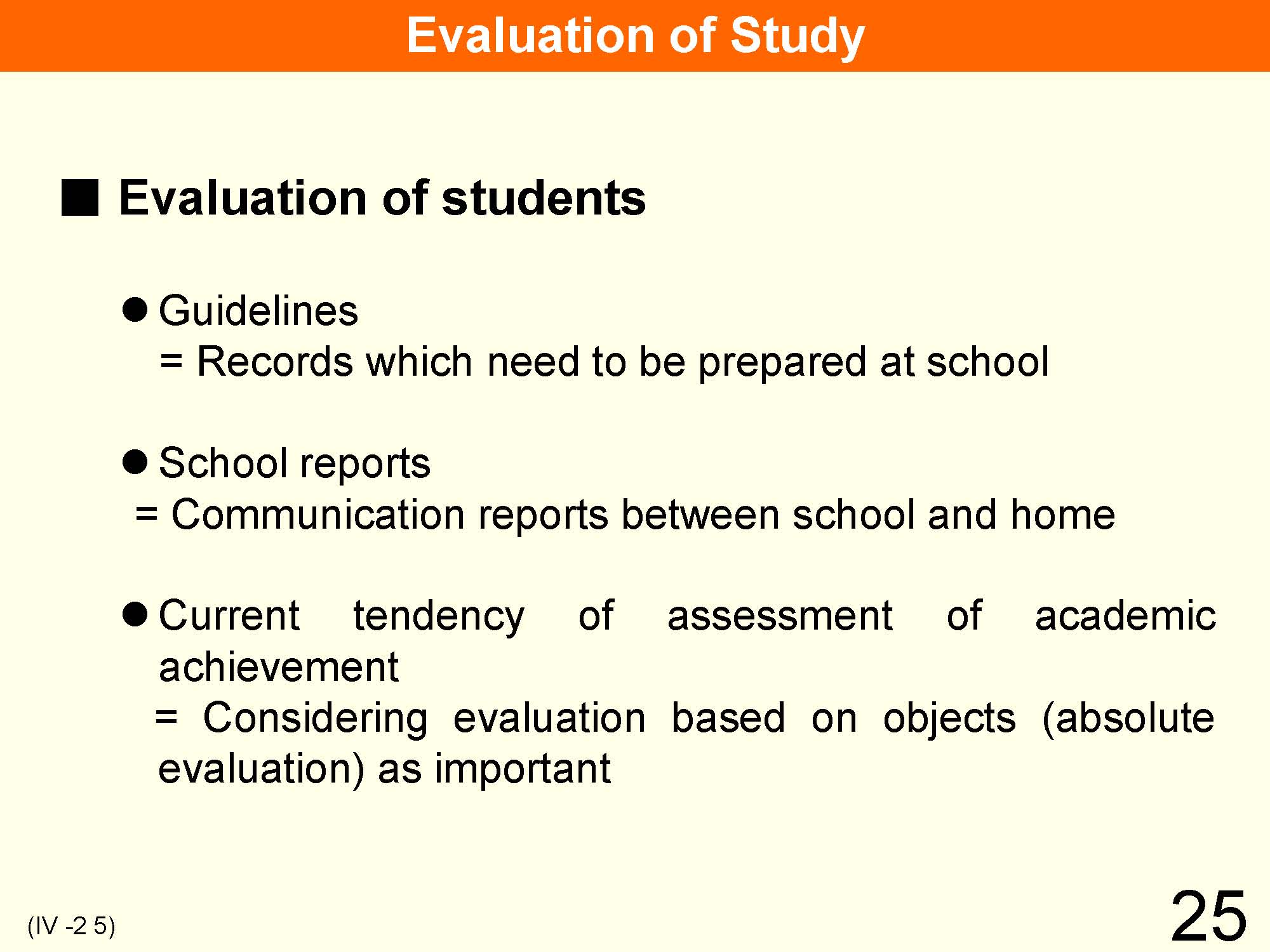 |
Written “guidelines” change every time the Course of Study is revised according to evolving principles. These written guidelines consist of “records of the school register” and “records of instructions,” and plays two roles as: 1) the original certification for external use, and 2) instruction materials. A “report card” (--> Ⅶ 19) contains information about a student’s performance and attendance record. Report cards are provided to students’ parents at the end of each quarter, thereby allowing them to track the progress of their children in order to provide feedback and reflect on future instruction. In Japan today, absolute evaluation are being considered seriously as a means to assess students’ academic performance since they provide a clearer assessment of students’ performance and progress. |
| 26 | 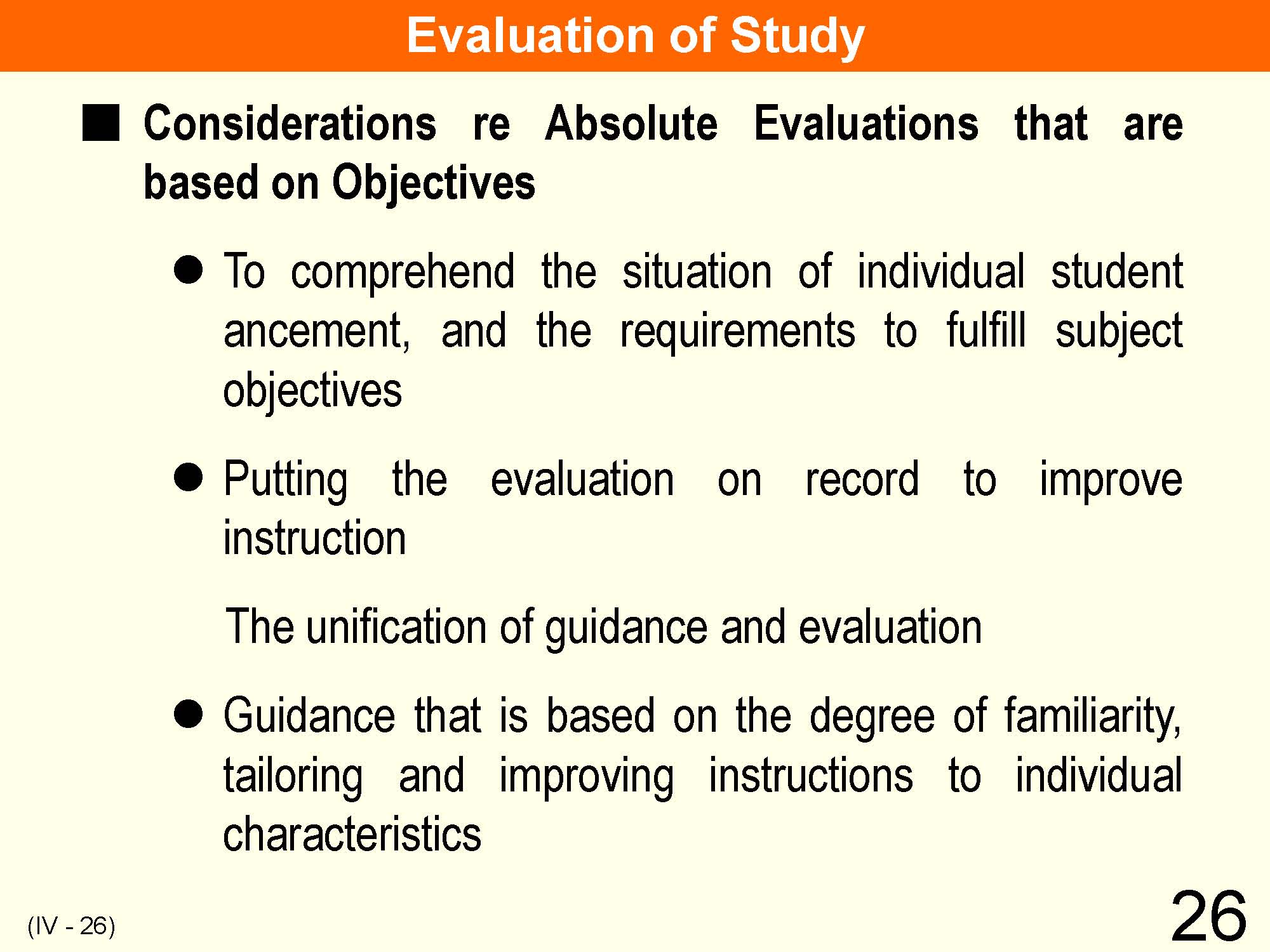 |
Today in Japan, setting concrete educational objectives and making precise evaluations of the extent to which objectives have been achieved have been prioritized in order to clarify individual improvements. This approach reflects previous knowledge regarding the utility of evaluations. Excerpts from the Curriculum Council, Report on Evaluation of Learning and Educational Process of Students, December 4th, 2000. |
| 27 | 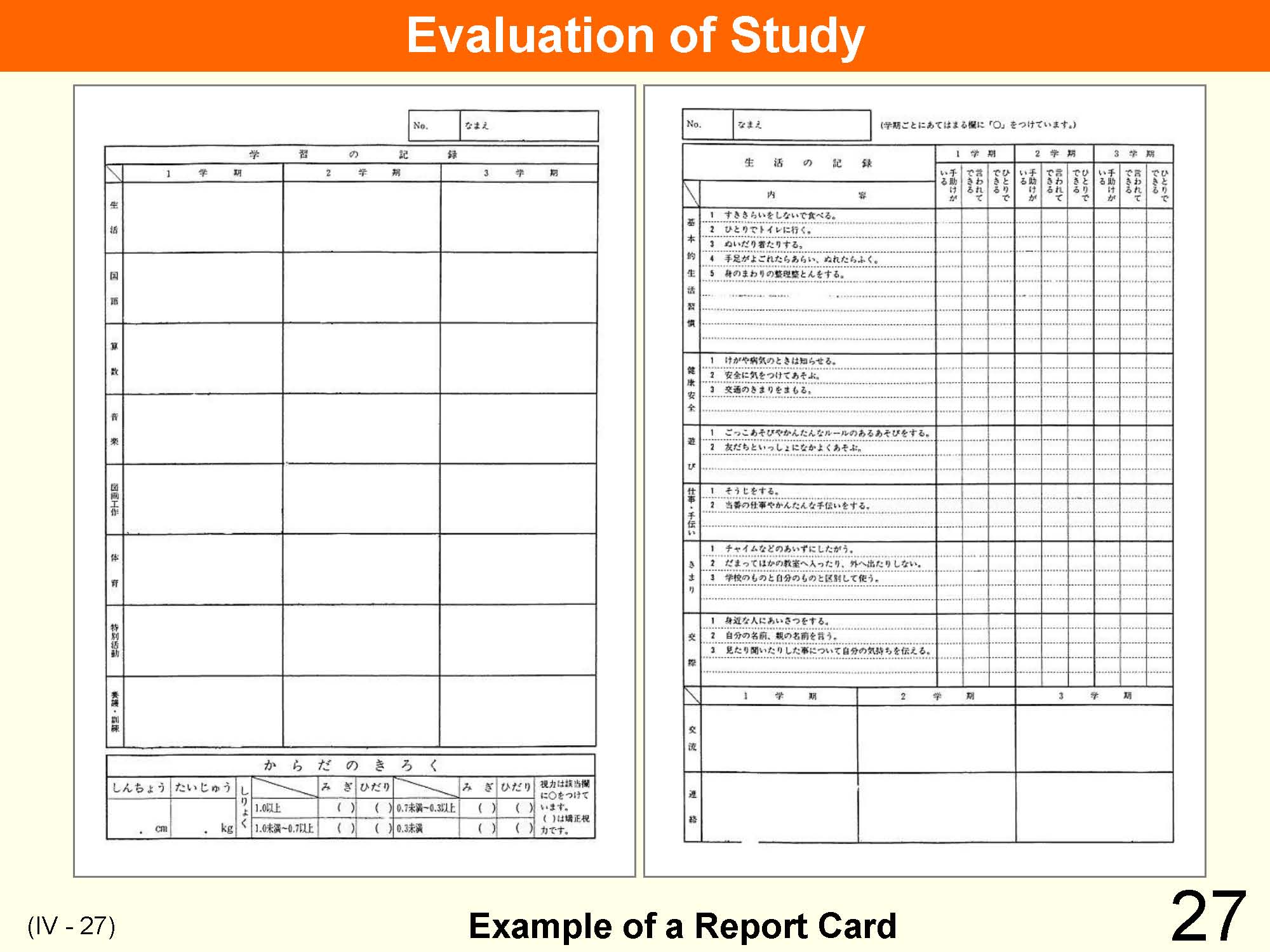 |
This is a picture of a school report card. A homeroom teacher carefully writes down evaluations of the progress and strengths of individual students in order to let them know their achievements, to set goals and to inform parents regarding their children’s academic development. |
| 28 | 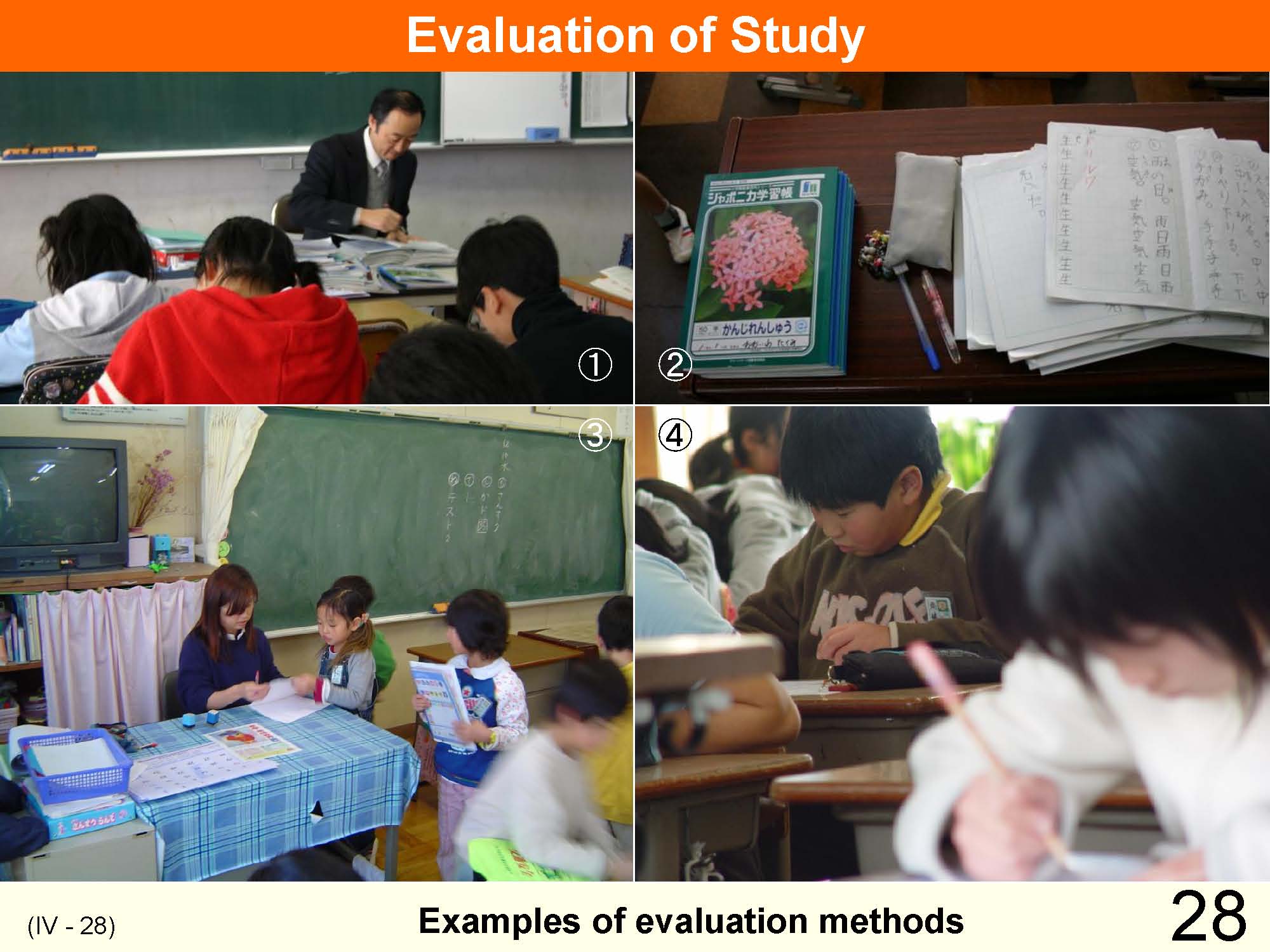 |
In order to assess students’ academic achievements, teachers evaluate tests which are done before, after and during the school term. Teachers also check notebooks, worksheets and work done by each student in order to be aware of their level of understanding and to teach appropriately. Teachers file these documents and make use of them in their evaluations. (1) 6th grade, November 2005 (2) 1st grade, January 2005 (3) 1st grade, December 2003 (4) Test, 6th grade, December 2003 |
| 29 | 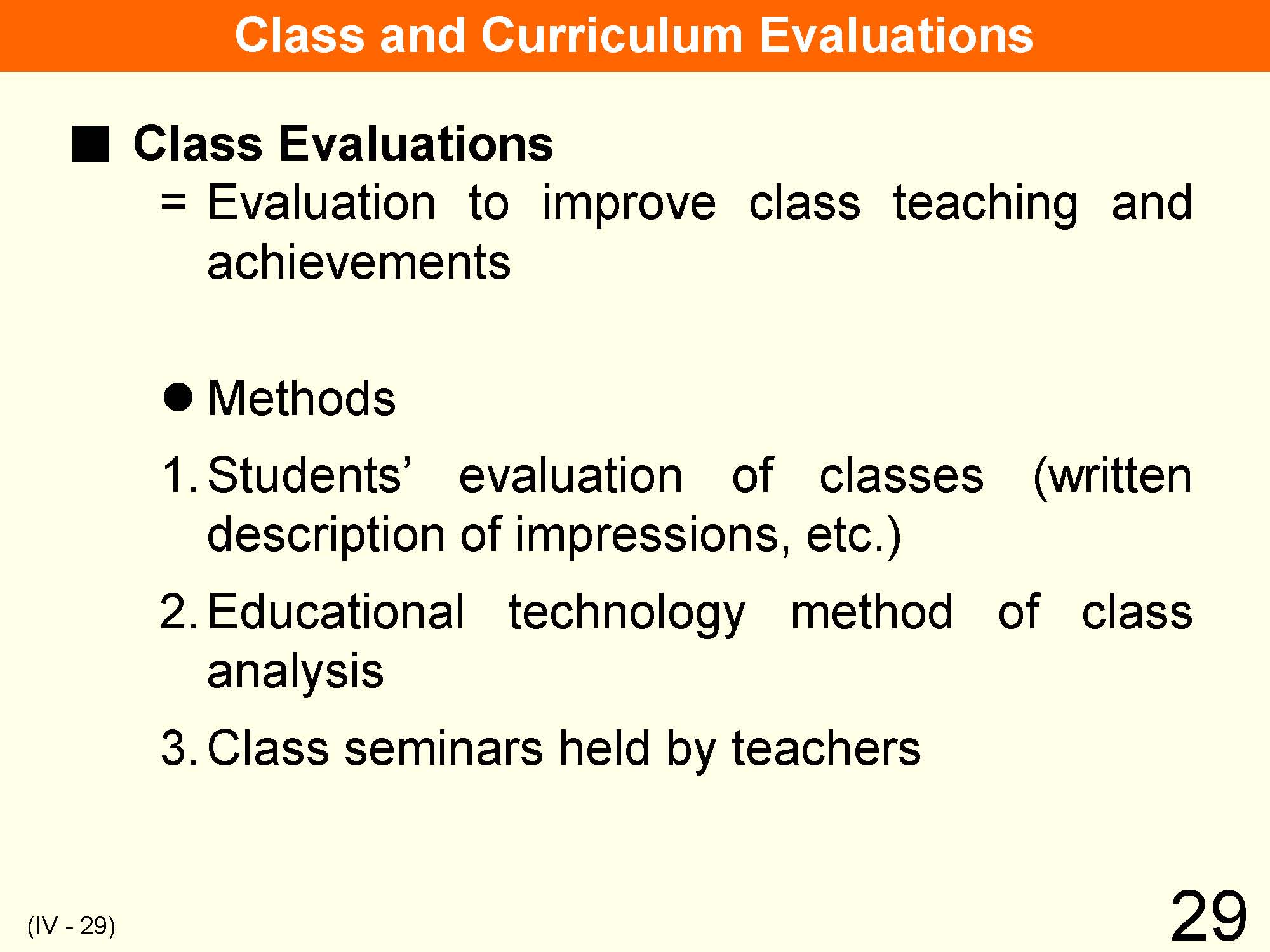 |
An evaluation of class improvements is called ‘class evaluation’ and an evaluation of curriculum improvement is called ‘curriculum evaluation.’ Through these evaluations overall class and curriculum palns are reassessed. |
| 30 | 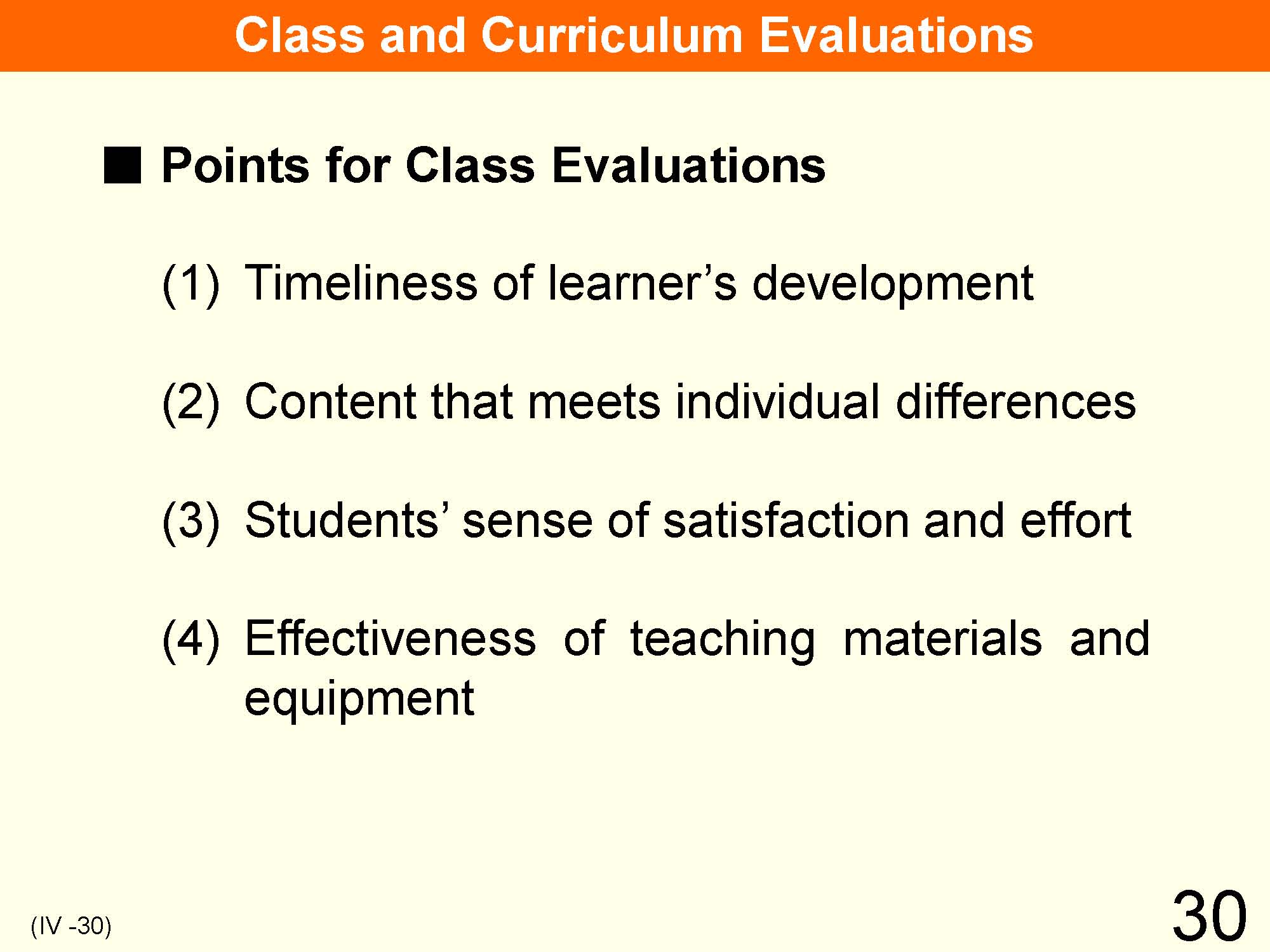 |
‘Curriculum evaluations’ are made to check if curriculum are designed and implemented appropriately and to improve curriculums. Evaluations are conducted at multiple levels, such as schools, communities, and the state. ‘Curriculum evaluations’ of schools are conducted in terms of (1) students’ assessment of academic achievement, (2) organization of school curriculum development, (3) relationships between communities and curriculums, (4) results of evaluations of curriculums and the entire school and (5) school characteristics. |
| 31 | 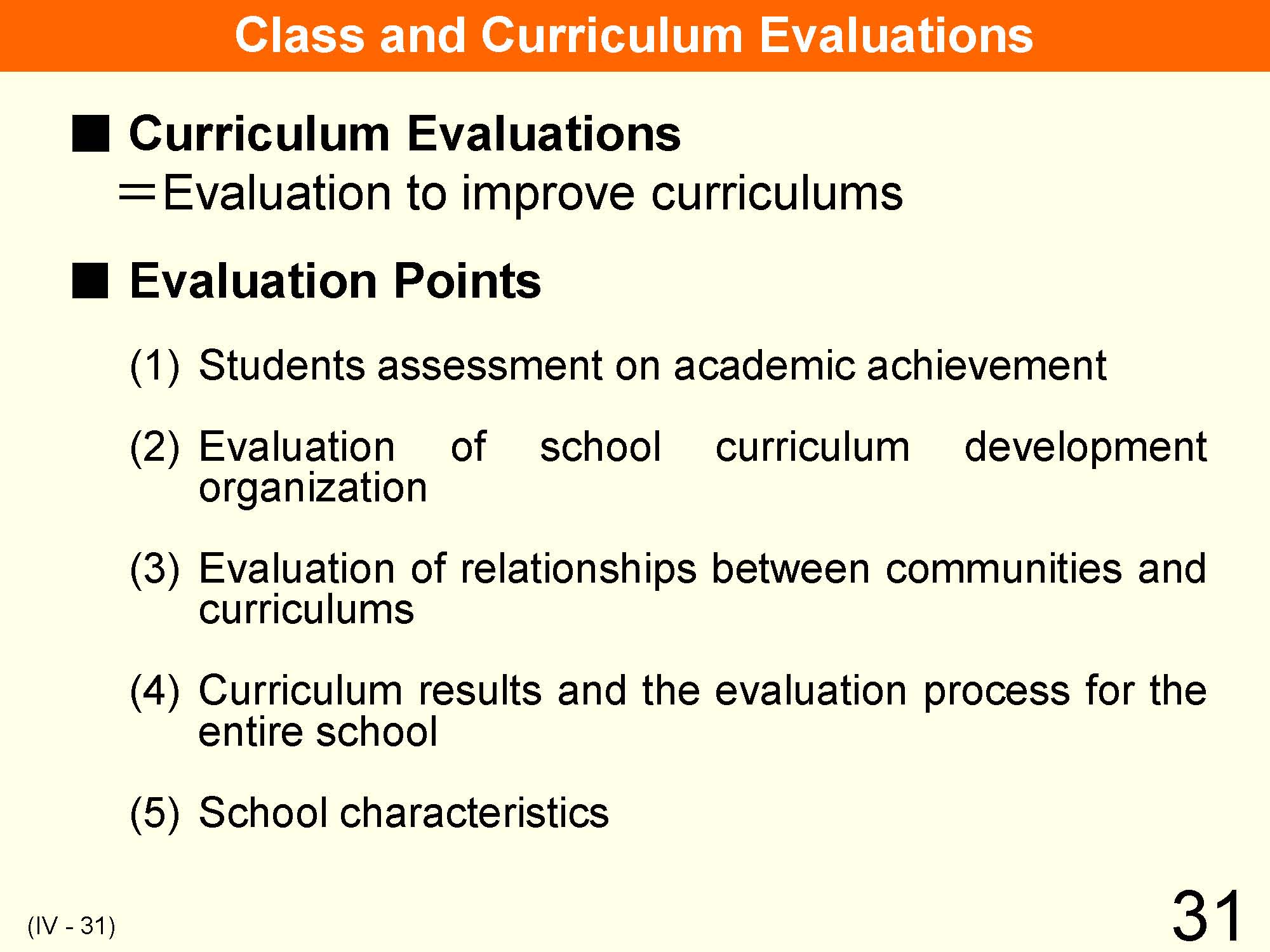 |
‘Class evaluations” are made to improve classes. While valuation points differ according to class objectives, important points to be considered are (1) the appropriateness of class content in terms of child development, (2) whether the class content has adequate range to accommodated individual differences, (3) whether children are able to work effectively and whether they are satisfied with the content, (4) whether children had opportunities to express their thoughts about things that they don’t understand and (5) whether the teaching materials and equipment were effectively used. |
| 32 | 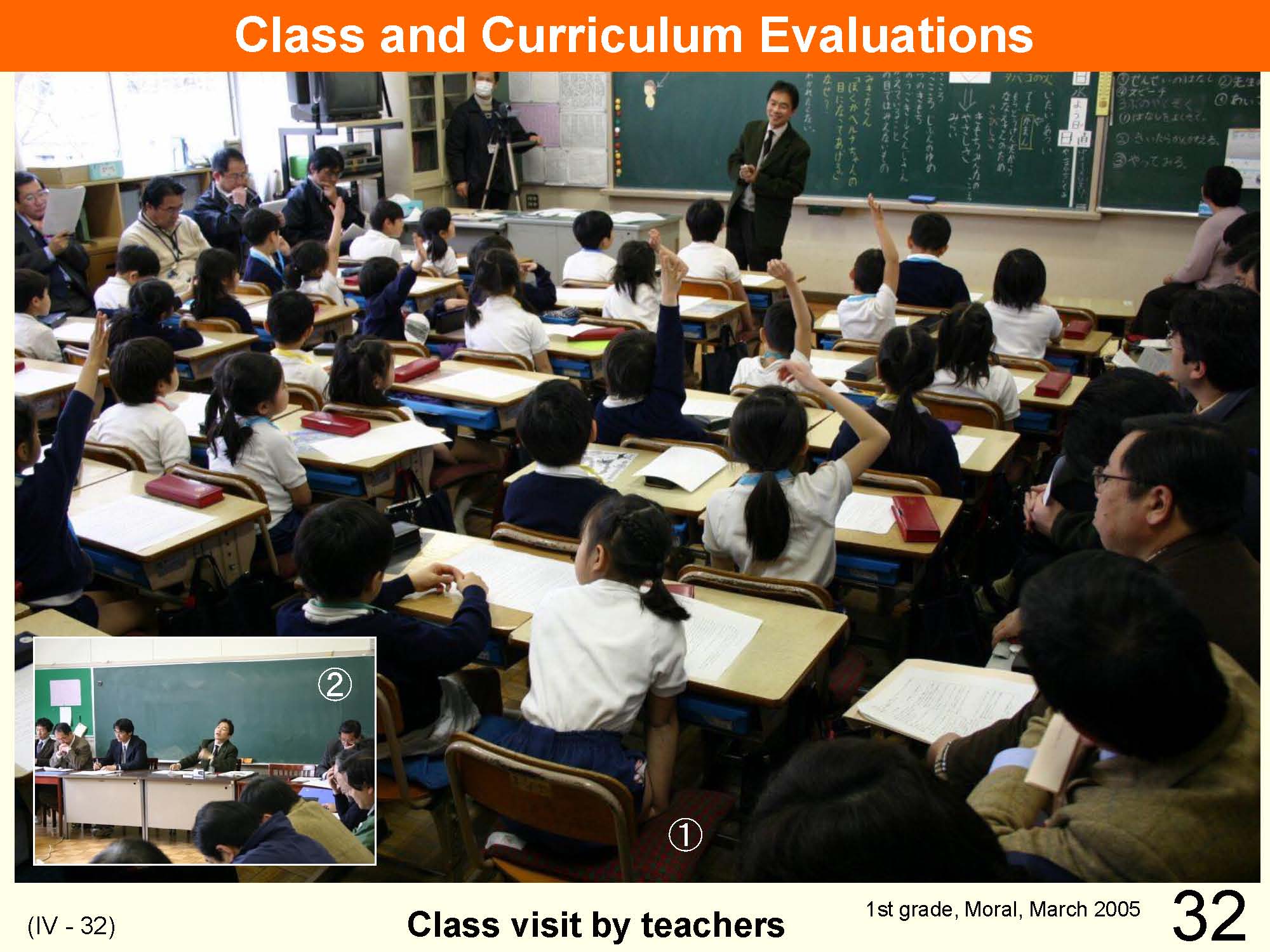 |
In this picture, teachers observe a class. After the class visit, they hold a seminar, and discuss the objectives, content and methods of the class. There are both ‘in-school seminars’ held in the same school and ‘open seminars’ which are open to outsiders. By learning from these seminars, teachers reassess their classroom instruction methods and attempt through mutual feedback to improve individual quality and abilities. (1) Class visit, moral education, 1st grade, March 2005 (2) Discussion after the class |
| 33 | 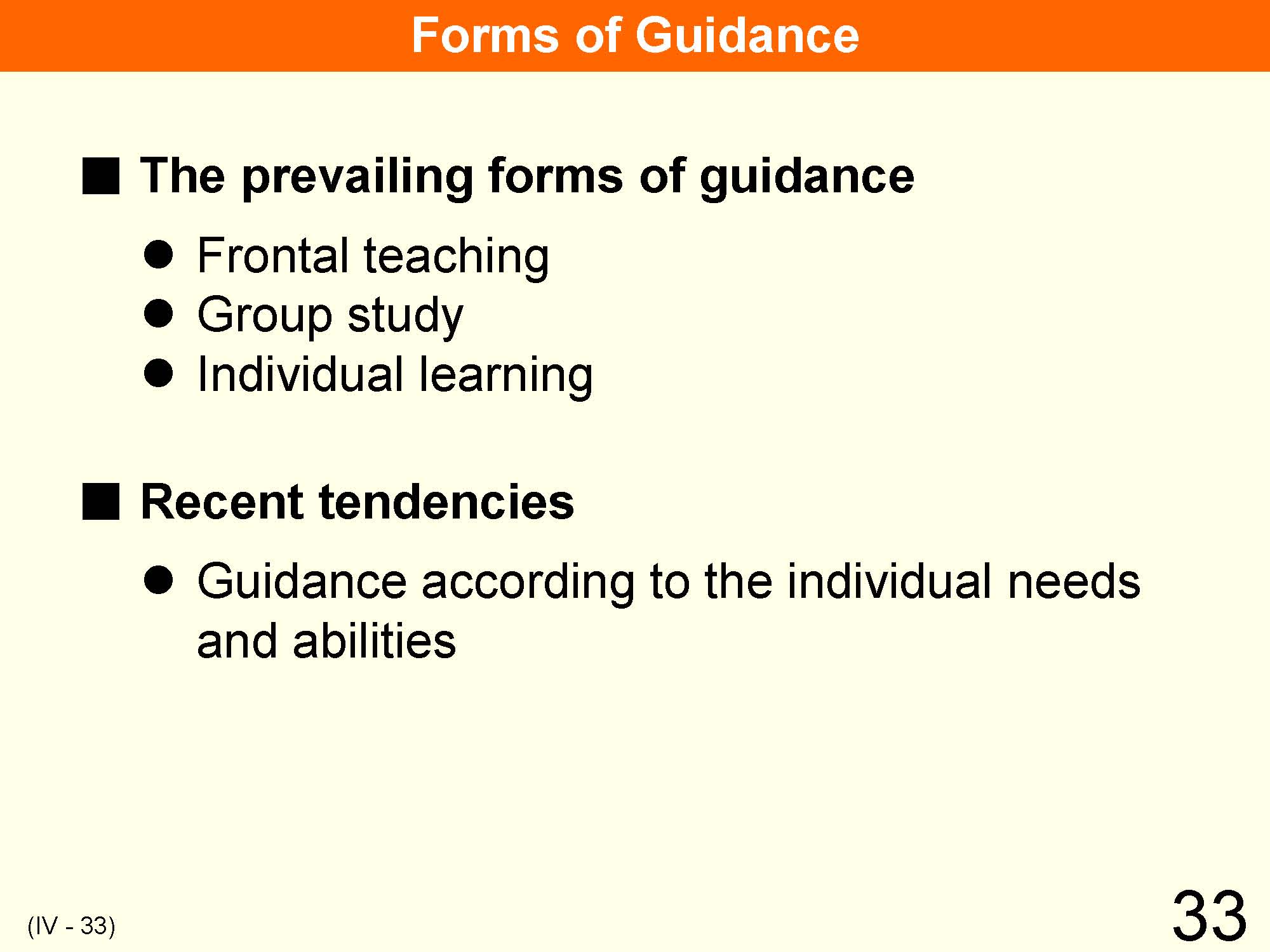 |
There are three forms of general guidance: (1) frontal teaching, (2) group study, and (3) provision of individual learning. In addition, recently, providing guidance according to students’ individual needs and abilities becomes important at Japan’s elementary schools and lower secondary schools. |
| 34 | 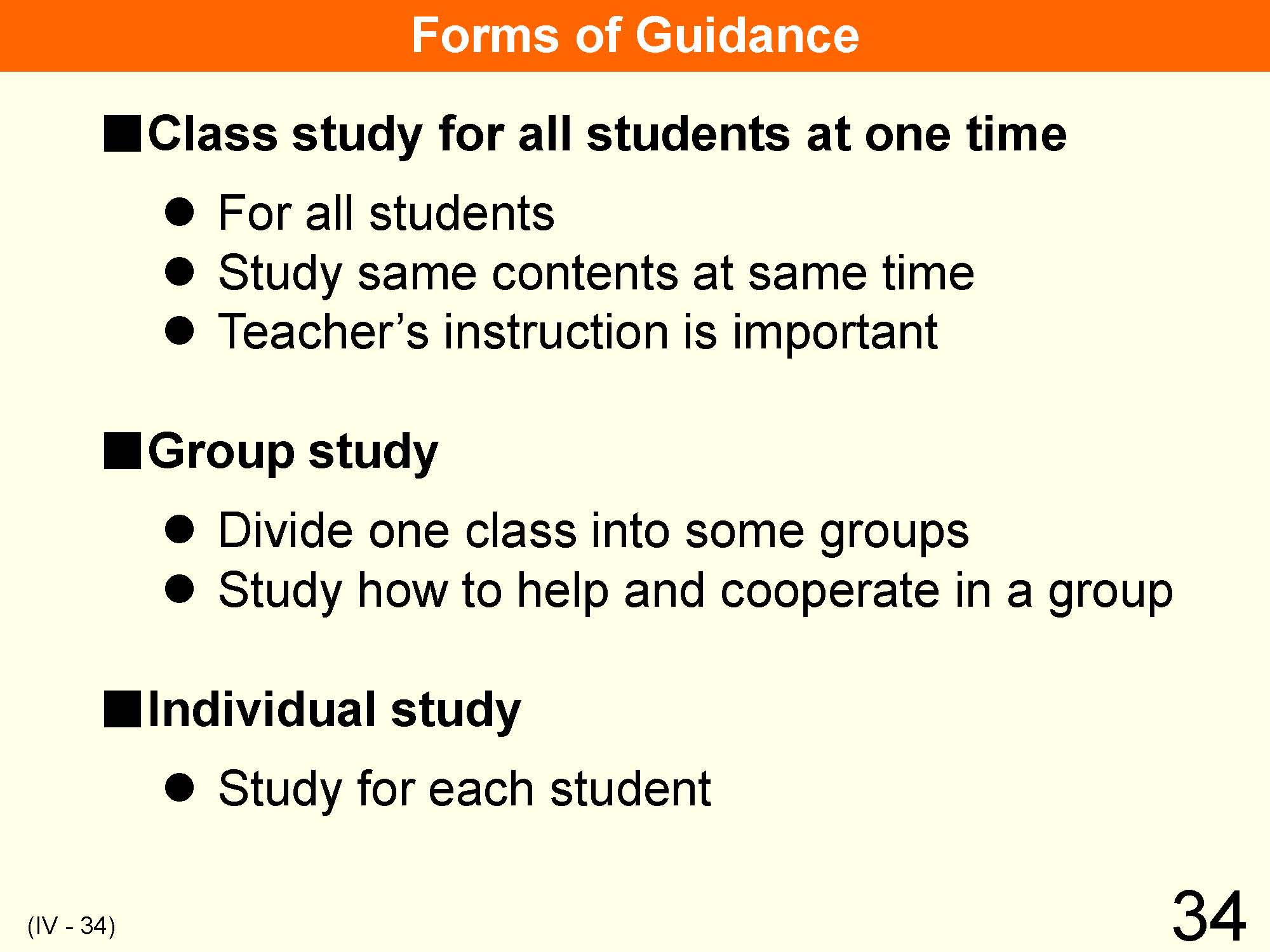 |
The above caption illustrates general types of instruction and the characteristics of each type. Currently in Japan, schools utilize not only classroom study but also other types of instruction, such as group and individual study. Which type of teaching methods are practiced depends on the contents of a class. To instruct students individually and to ascertain their level of comprehension, instruction is given by the teacher by walking around children’s desks. (The number of students per class -->Ⅱ 41) |
| 35 | 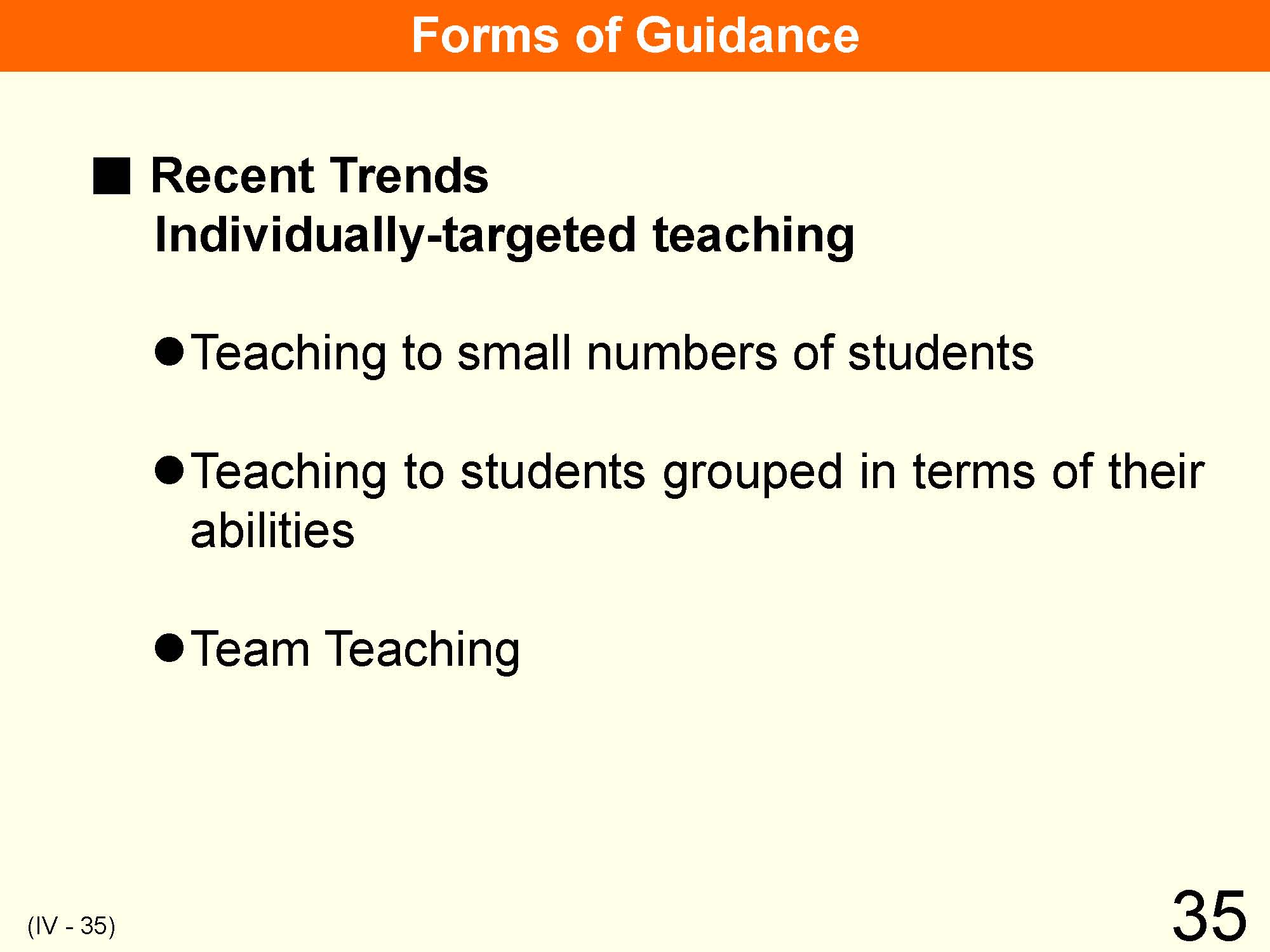 |
To strengthen the teaching of basic and fundamental contents and to develop education considering individual students’ needs and abilities, instruction for small numbers of students through individual and group teaching, instruction based on student’s abilities and team teaching, etc. are carried out. |
| 36 | 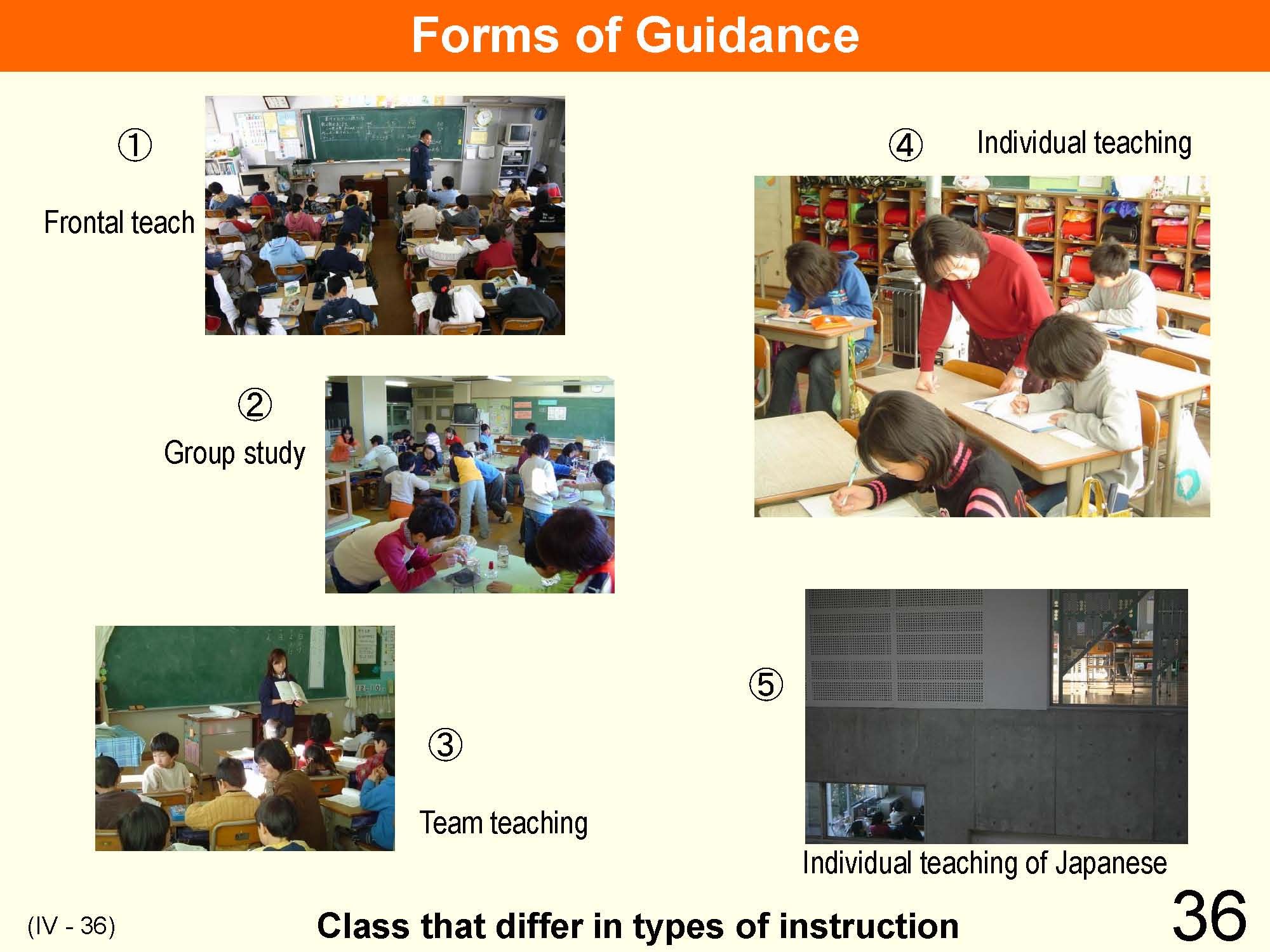 |
The Course of Study adopted in 1998 aims to strengthen the teaching of basic and fundamental contents and to develop education considering individual students’ needs and abilities. To achieve this goal, instruction for small numbers of students is carried out, such as through individual and group teaching, instruction based on students’ abilities and team teaching. (1) Frontal teaching, arithmetic, 5th grade, January 2005 (2) Group study, science, 4th grade, December 2003 (3) Team teaching, Japanese language, 1st grade, December 2003 (4) Individualized teaching, arithmetic, 1st grade, December 2003 (5) Individualized teaching of Japanese, Japanese language, January 2005 |
| 37 | 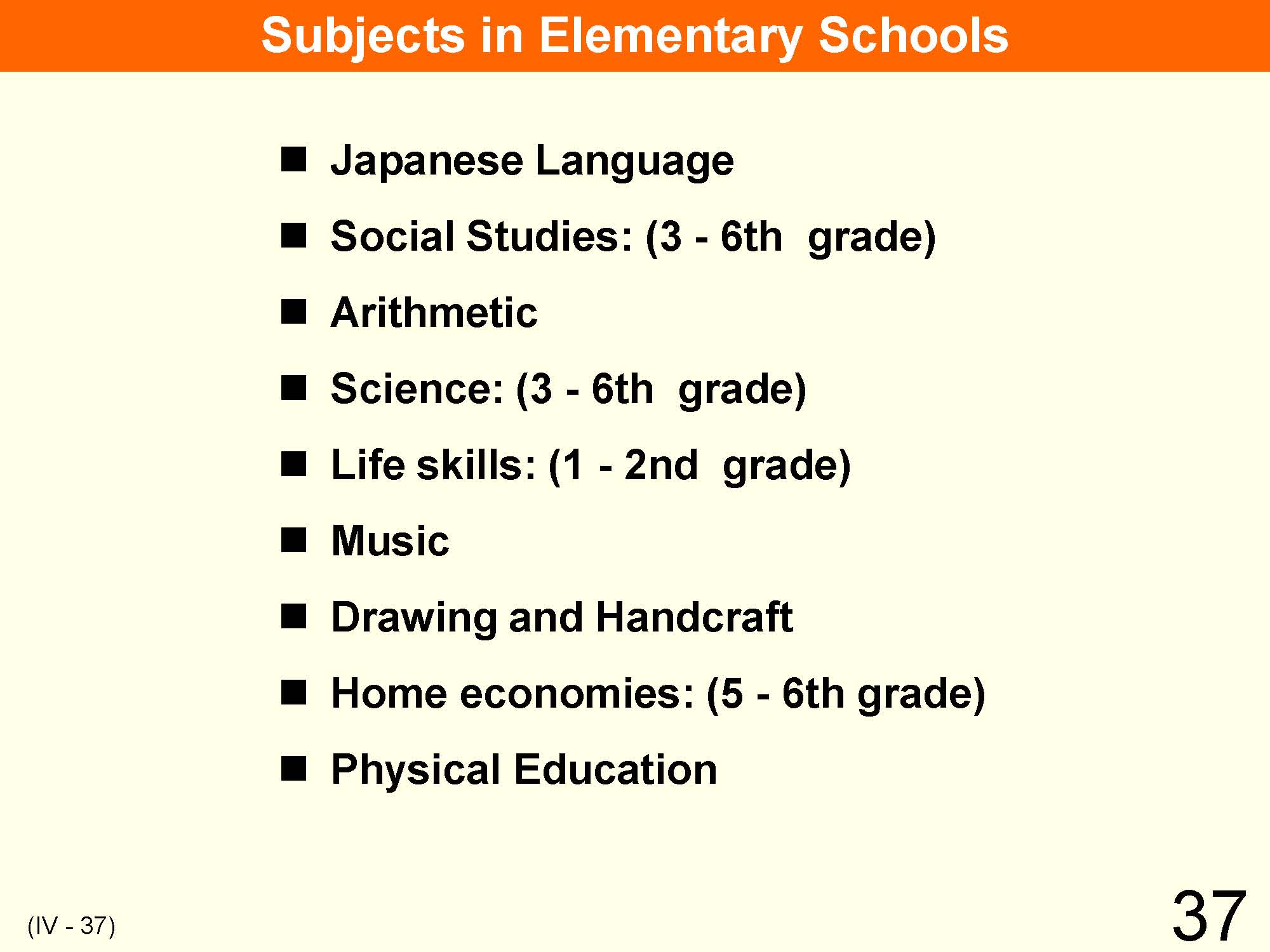 |
There are nine subjects in elementary school; ‘Japanese language,’ ‘social studies,’ ‘arithmetic,’ ‘science,’ ‘life skills,’ ‘music,’ ‘drawing and handcrafts,’ ‘home economies’ and ‘physical education.’ ‘Life skills’ is taught only in the first and second grades, while ‘science’ and ‘social studies’ are taught from the third grade. Fifth and sixth graders study home economics together. |
| 38 | 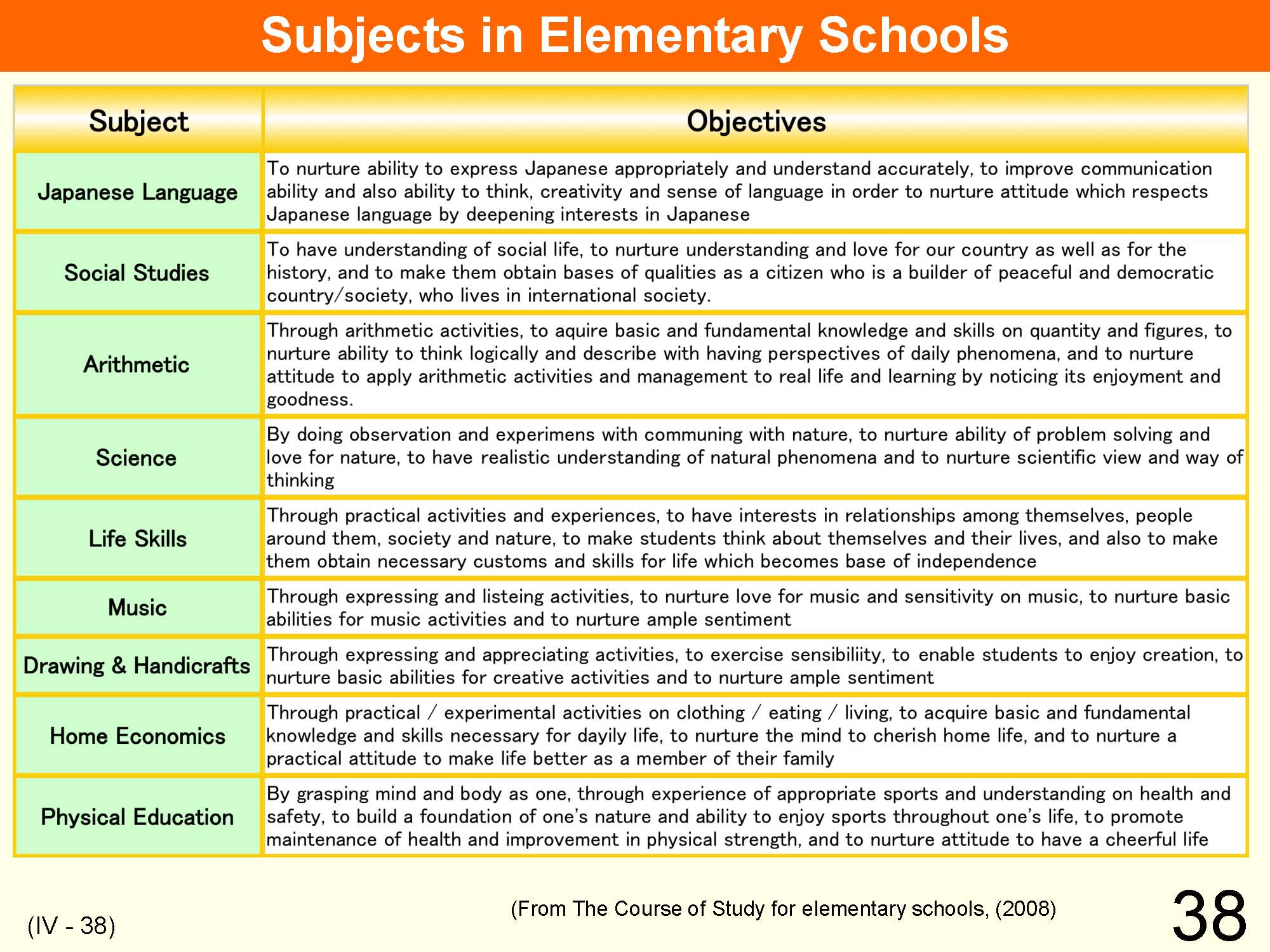 |
Posting objectives from “the Course of Study for elementary schools ” (2008). In the new curriculum, some wordings are changed or added such as “basic knowledge and skills” to “basic and fundamental knowledge and skills” (Arithmetic and Home Economics), to “realistic understanding” (Science), to “enjoy sports throughout one’s life” (Physical Education), and to “one’s own way of living” (Moral). |
| 39 | 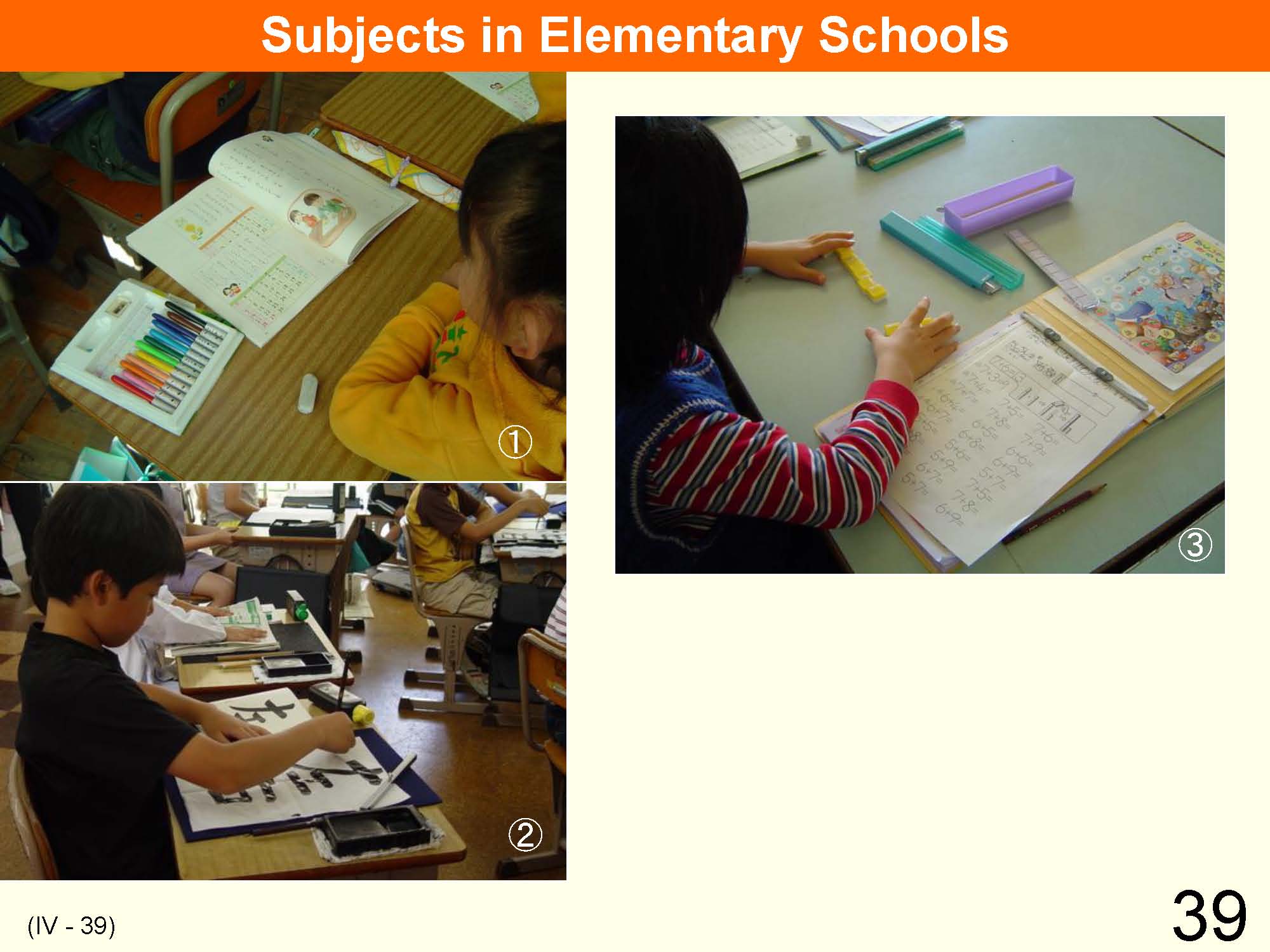 |
The above shows scenes from science and music classes in elementary school. (1) Japanese, 1st grade, December 2003 (2) Calligraphy, 4th grade, July 2004 (3) Arithmetic, 1st grade, December 2003 |
| 40 | 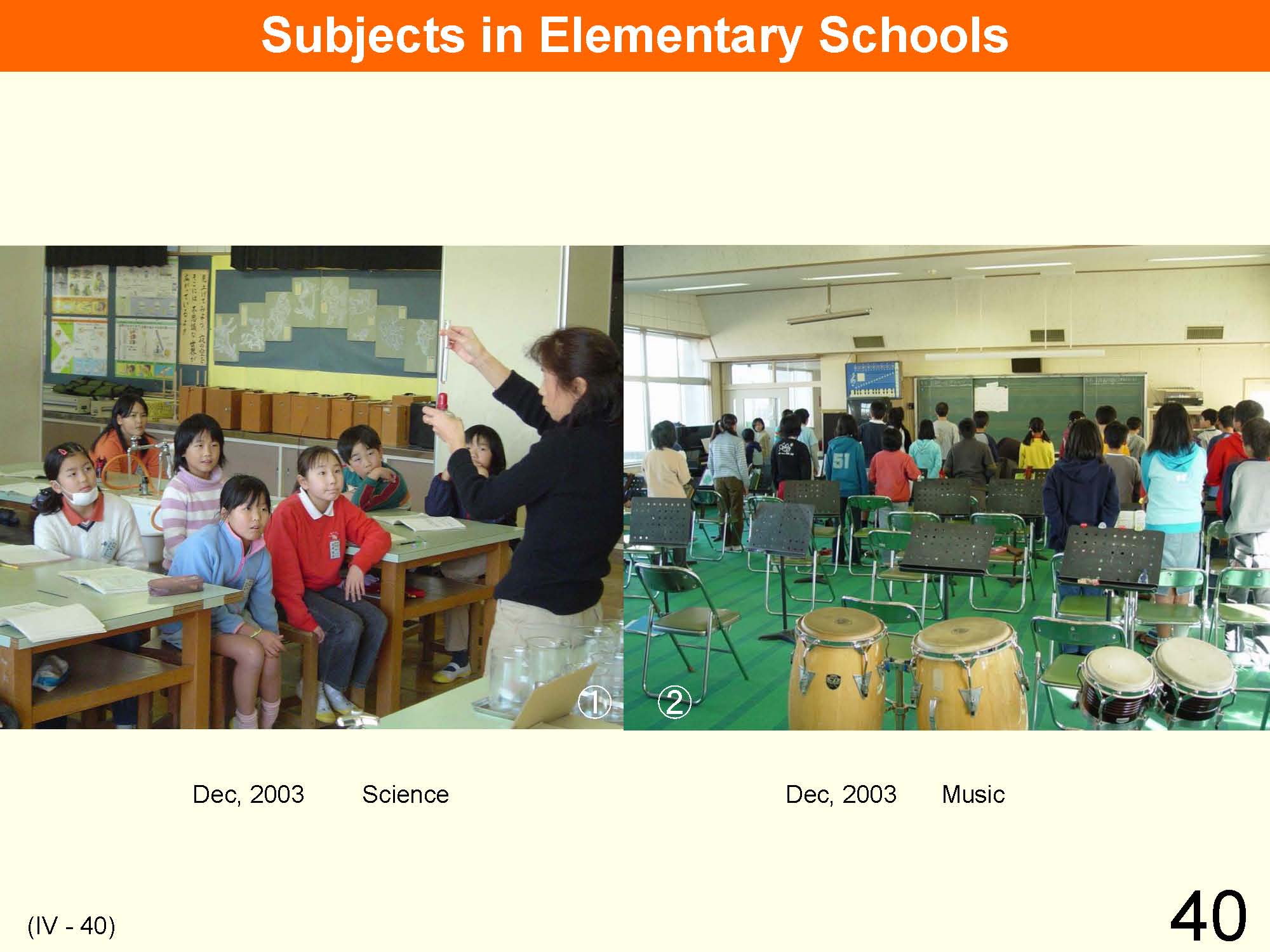 |
The above shows scenes from science and music classes in elementary school. (1) Science 4th grade, December 2003 (2) Music 6th grade, December 2003 |
| 41 | 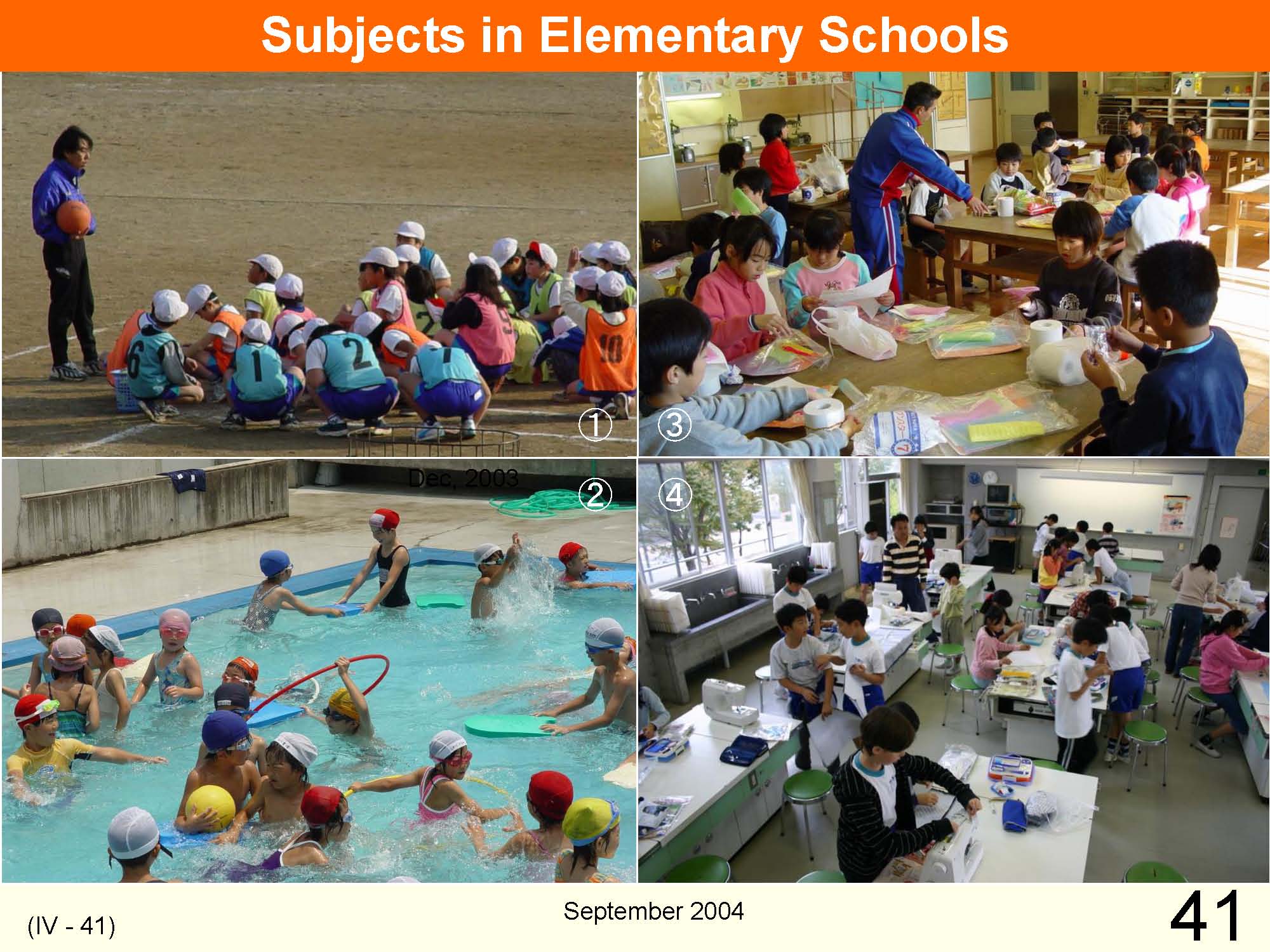 |
The above shows scenes from physical education, handicrafts and home economics classes in elementary school. (1) Physical education, December 2003 (2) Physical education (swimming) 2nd grade, July 2004 (3) Drawing and Handcrafts 3rd grade, December 2003 (4) Home economics 5th grade, November 2005 |
| 42 | 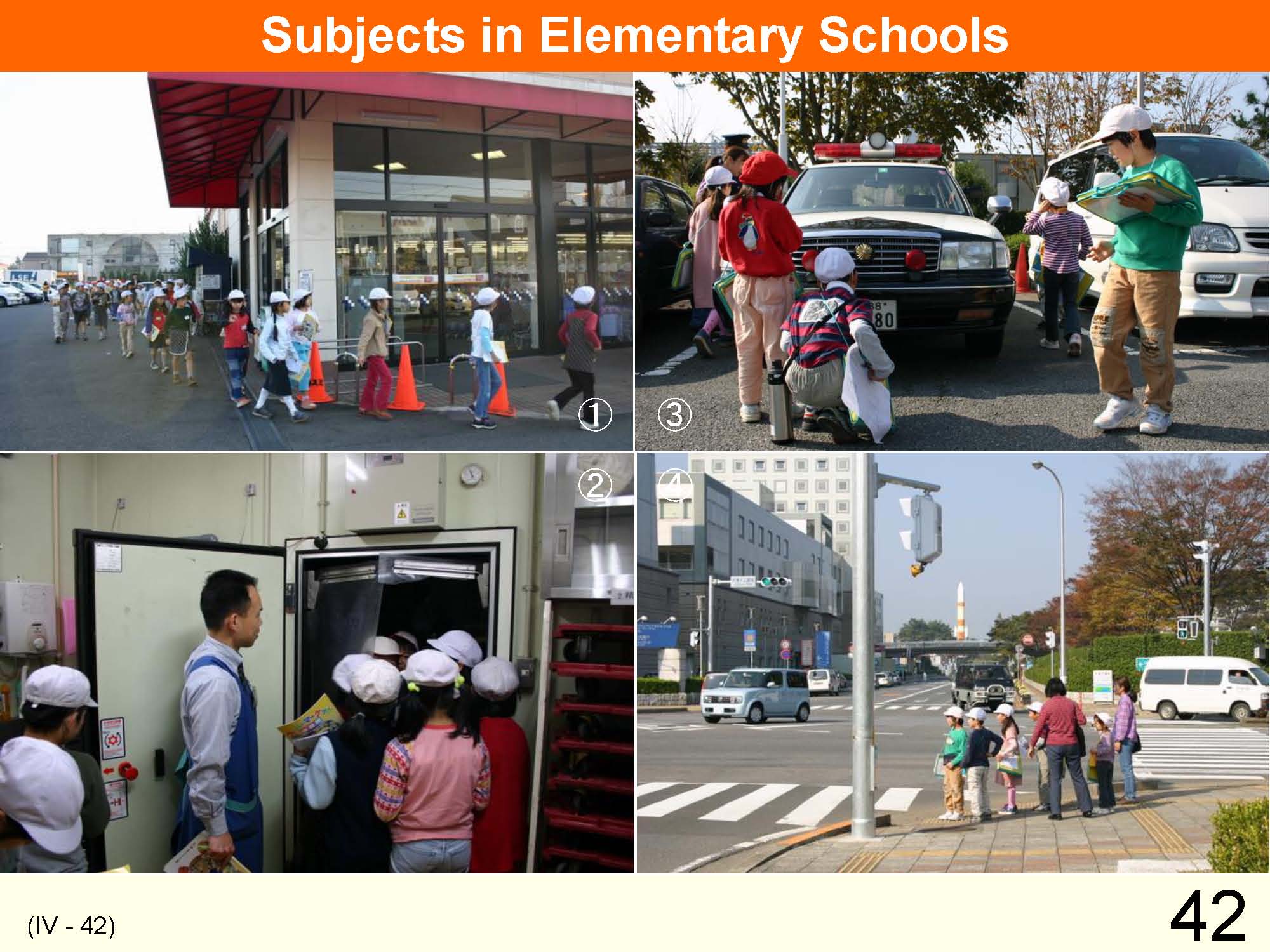 |
They shows scenes from social studies and life skill activities in elementary school. (1)(2) Social Studies (study outside the school), 3rd grade, November 2004 (3)(4) Life skills (study outside the school), 2nd grade, November 2004 |
| 43 | 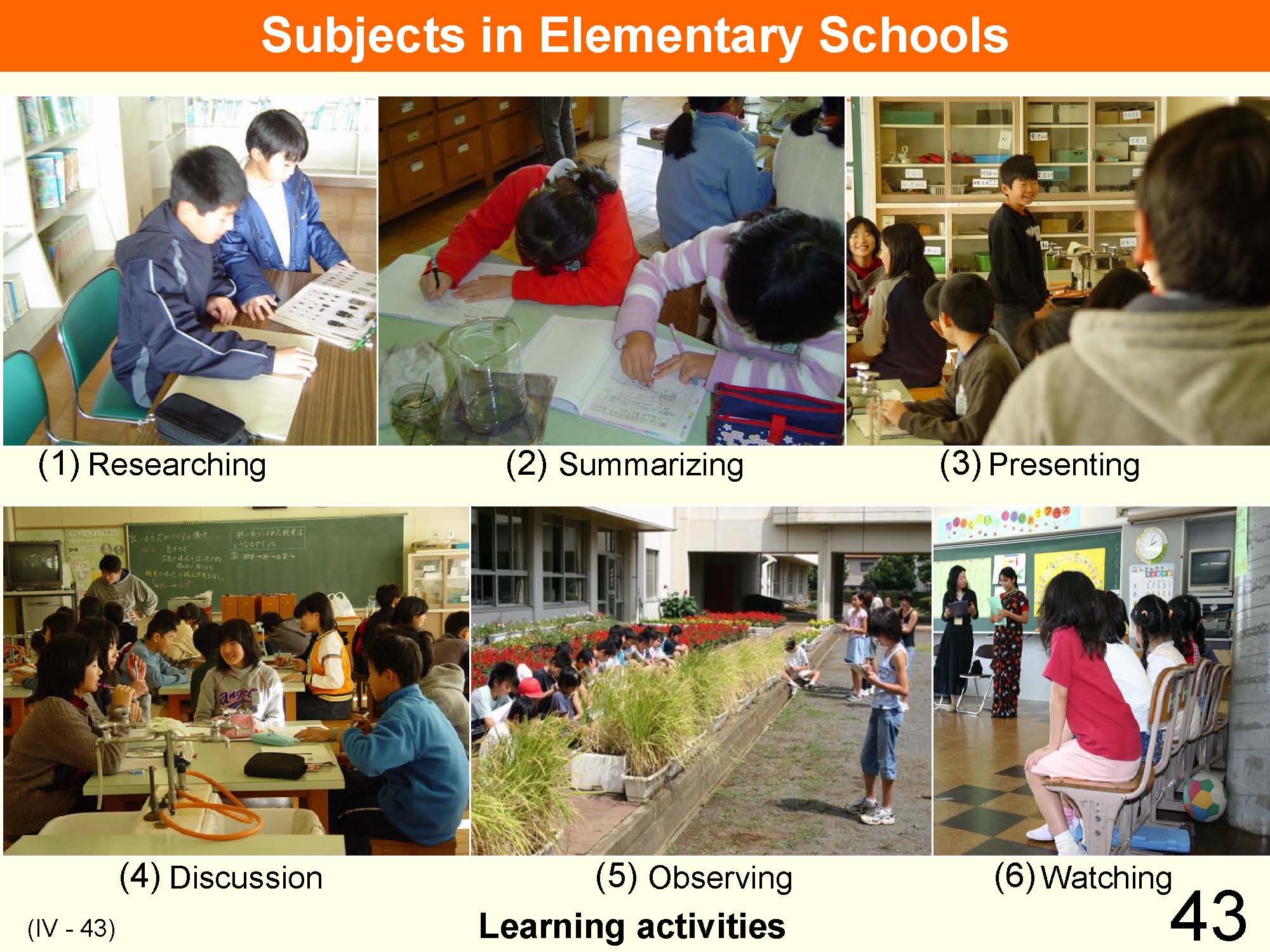 |
These are examples of children’s learning activities in an elementary school: research, summary, presentation, discussion, observation and watching. (1) In a school library room (the period of integrated study), 6th grade, December 2003 (2) In a science room, 4th grade, December 2003 (3) In a science room, 6th grade, December 2003 (4) In a science room, 6th grade, December 2003 (5) In a science class, 6th grade, September 2004 (6) In a period of integrated study (international education), 2nd grade, June 2004 |
| 44 | 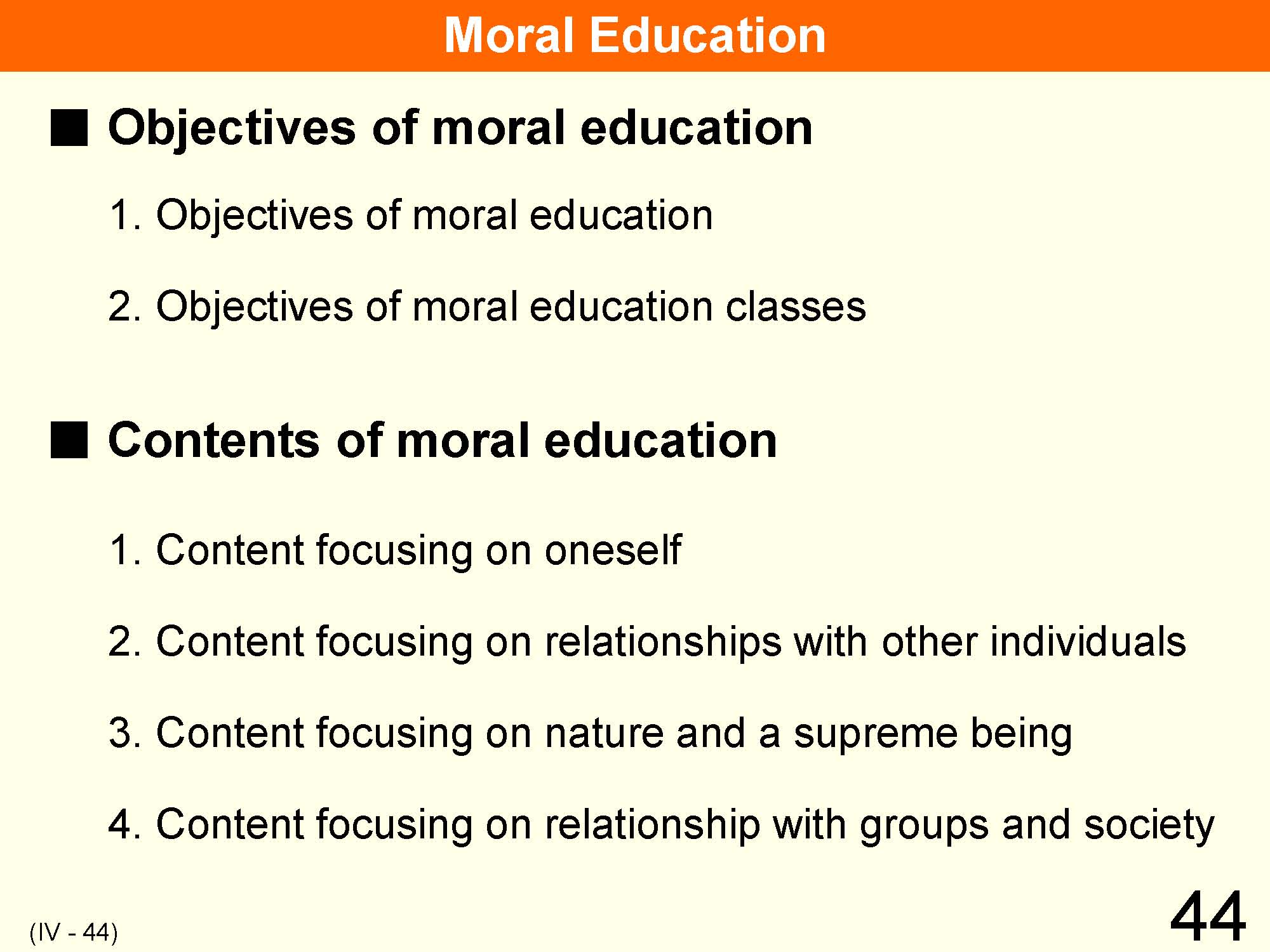 |
Elementary and lower secondary schools in Japan conduct ‘moral education’ classes once a week. With the ‘moral education’ class as a cornerstone, moral education is provided throughout the entire educational activities of the school. 1. Objectives of moral education (elementary school) To teach and instill morality covering moral sentiments, moral judgment, moral attitudes and the capability and willingness to put these in practice through all educational activities at school. 2. Objectives of moral education classes Based on the objectives of moral education in the above item 1, to intensify moral values of self-awareness and thoughts on one’s way of life and to develop students’ ability to practice morality. This is done by maintaining close relations with moral education in each subject, foreign language activities, the period of integrated study, and special activities through systematic developmental instruction. |
| 45 | 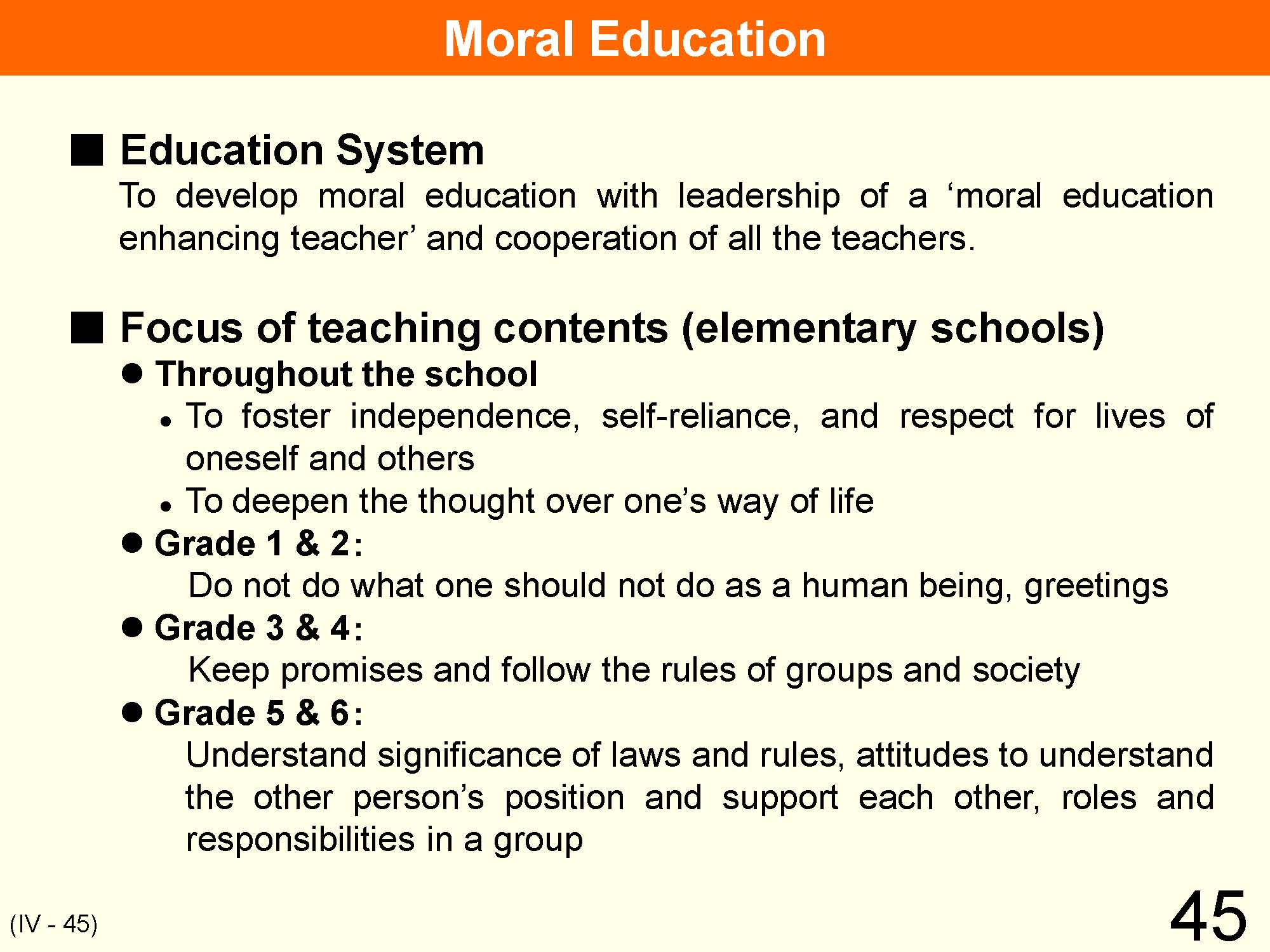 |
* Moral education enhancing teacher: a teacher in charge of mainly enhancing moral education ●Grade 1 & 2: ・Basic daily habits such as greetings ・Learn rules of social life, make a judgment of what is good and bad, and do not do what one should not do as a human being ●Grade 3 & 4: ・Keep promises and follow rules of groups and society ・Acquire attitudes to cooperate and help each other with people around ●Grade 5 & 6: ・Understand significance of laws and rules ・Acquire attitudes to understand the other person’s position and support each other ・Play a role and carry out responsibilities in a group ・Have a consciousness as a member of the nation and society ・Cover such topics as emotional disturbances (distress, conflict, etc.) and understanding of human relationships, so that students can deepen their understanding of their way of life |
| 46 | 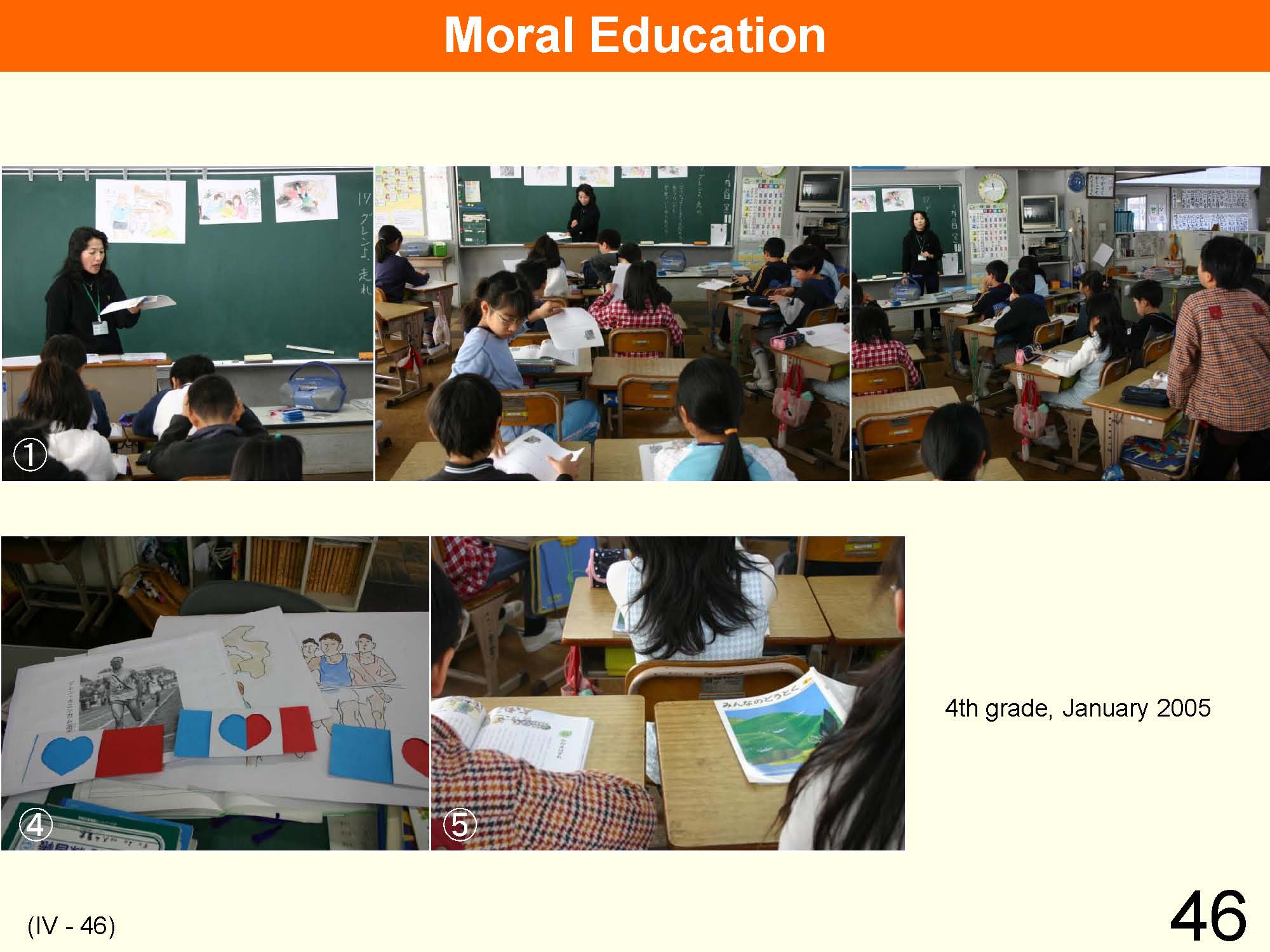 |
These are the pictures of a Moral Education textbook and supplementary reading. In Japan, many schools use not only textbooks, but also supplementary readings. (1) Use of paintings for introduction. (2) Distributing handouts to students. (3) Asking students’ opinions. (4) Handmade teaching materials (5) Supplementary readings |
| 47 | 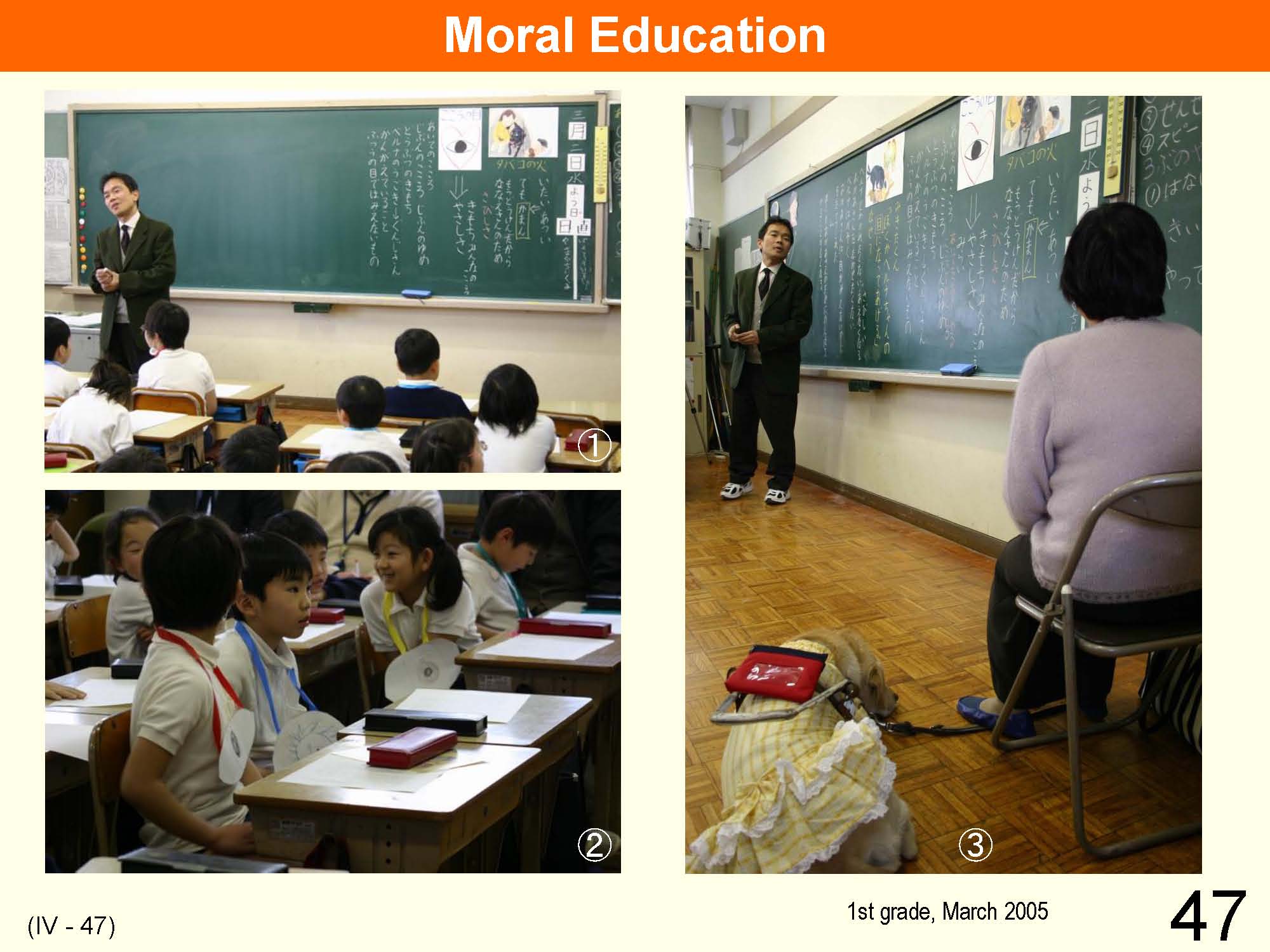 |
(1) An introduction to a class using paintings (2) “Watch with an eye of heart” (3) A challenged person relates her experience |
| 48 | 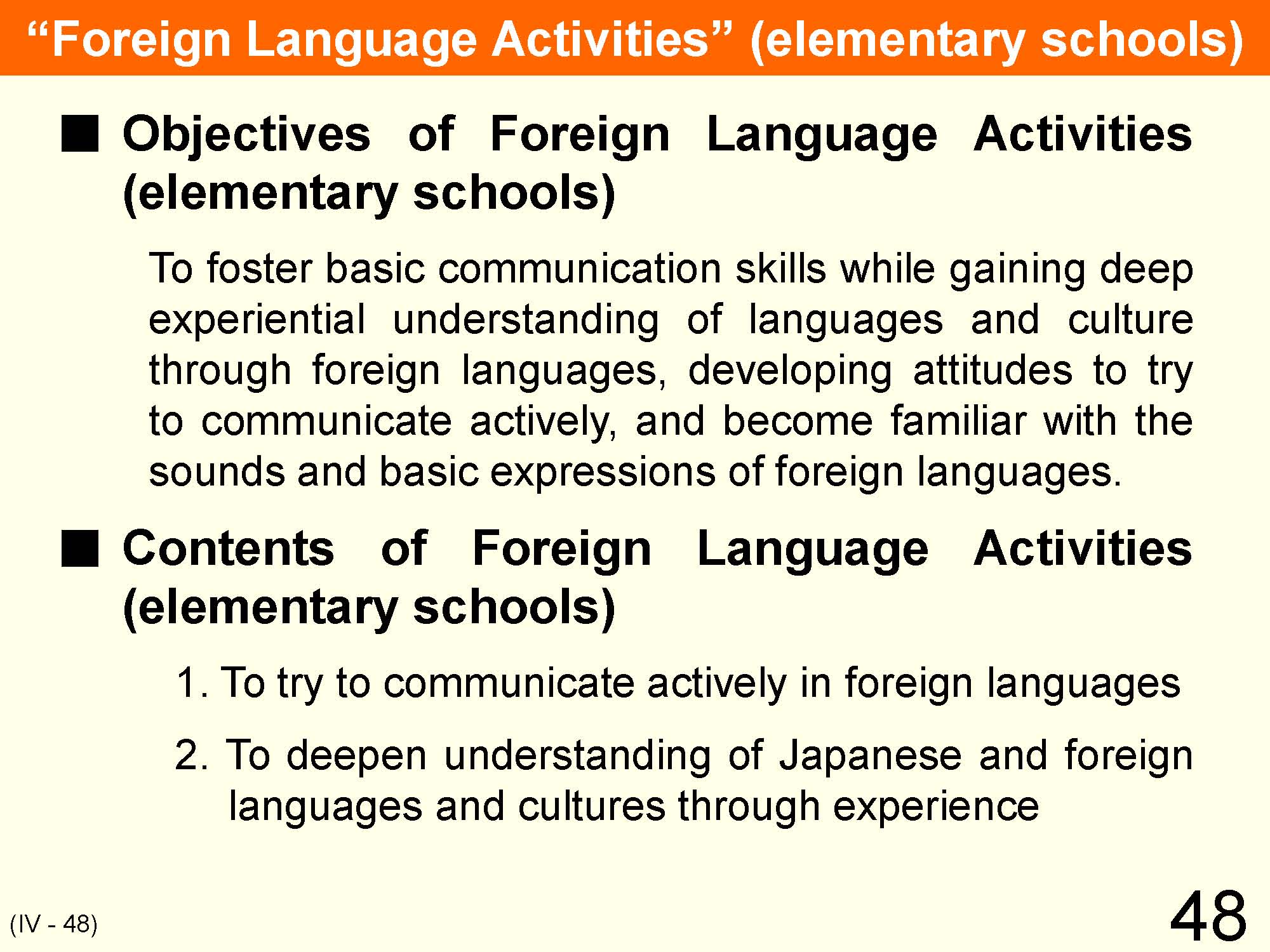 |
‘Foreign language activities’ started for grade 5 & 6 pupils in elementary schools under “the Course of Study for elementary schools” (2008) with objectives to foster attitudes to try to communicate actively and to deepen understanding of languages and cultures ■Contents of Foreign Language Activities (elementary schools) 1 To try to communicate actively in foreign languages (1) To experience the joy of communicating in foreign languages (2) To listen to and speak foreign languages actively (3) To know importance of verbal communication 2 To deepen understanding of Japanese and foreign languages and cultures through experience (1) To get familiar with sounds and rhythms of foreign languages, while understanding their differences from those of Japanese and realizing the excitement and richness of languages (2) To become aware of a variety of viewpoints and visions by understanding differences of ways of life, customs and events between Japan and foreign countries. (3) To deepen cultural and other understanding while communicating with people of different cultures. |
| 49 | 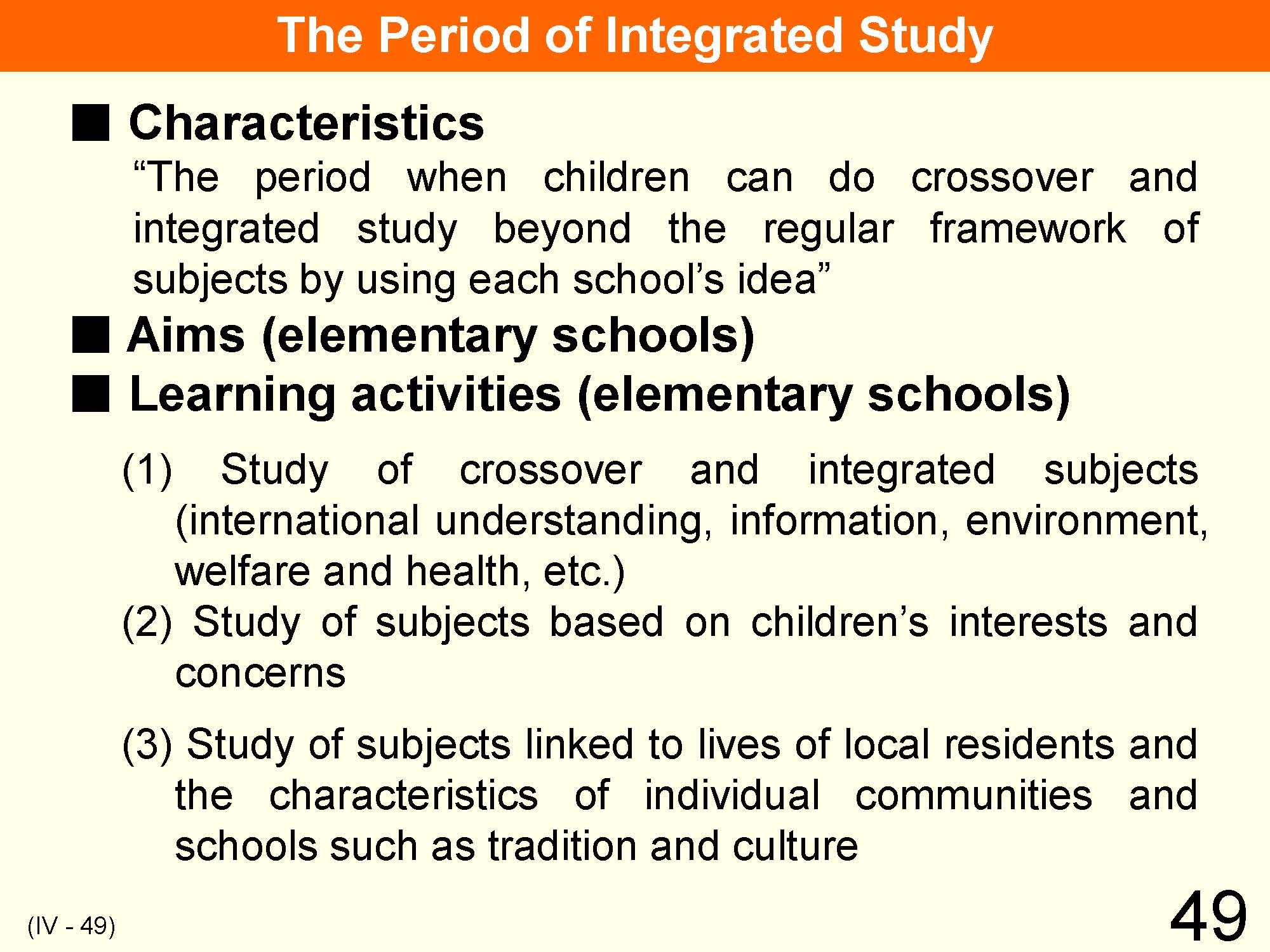 |
The “period of integrated study” was newly established under the revised Course of Study adopted in 1998. This is a period when children can study beyond the normal framework of subjects by pursuing original ideas identified within individual schools: elementary schools, lower secondary schools and upper secondary schools. The aims of the period are mentioned below. ■ Aims (elementary schools) To develop and improve abilities and stature to solve problems by identifying issues, learning, exercising critical thinking, interpreting and acting independently through crossover and integrated study and explorative study, and to learn how to study and think, and to learn how to act independently and creatively to solve problems and to carry out investigative activities, and finally to be able to undertake self-introspection. |
| 50 | 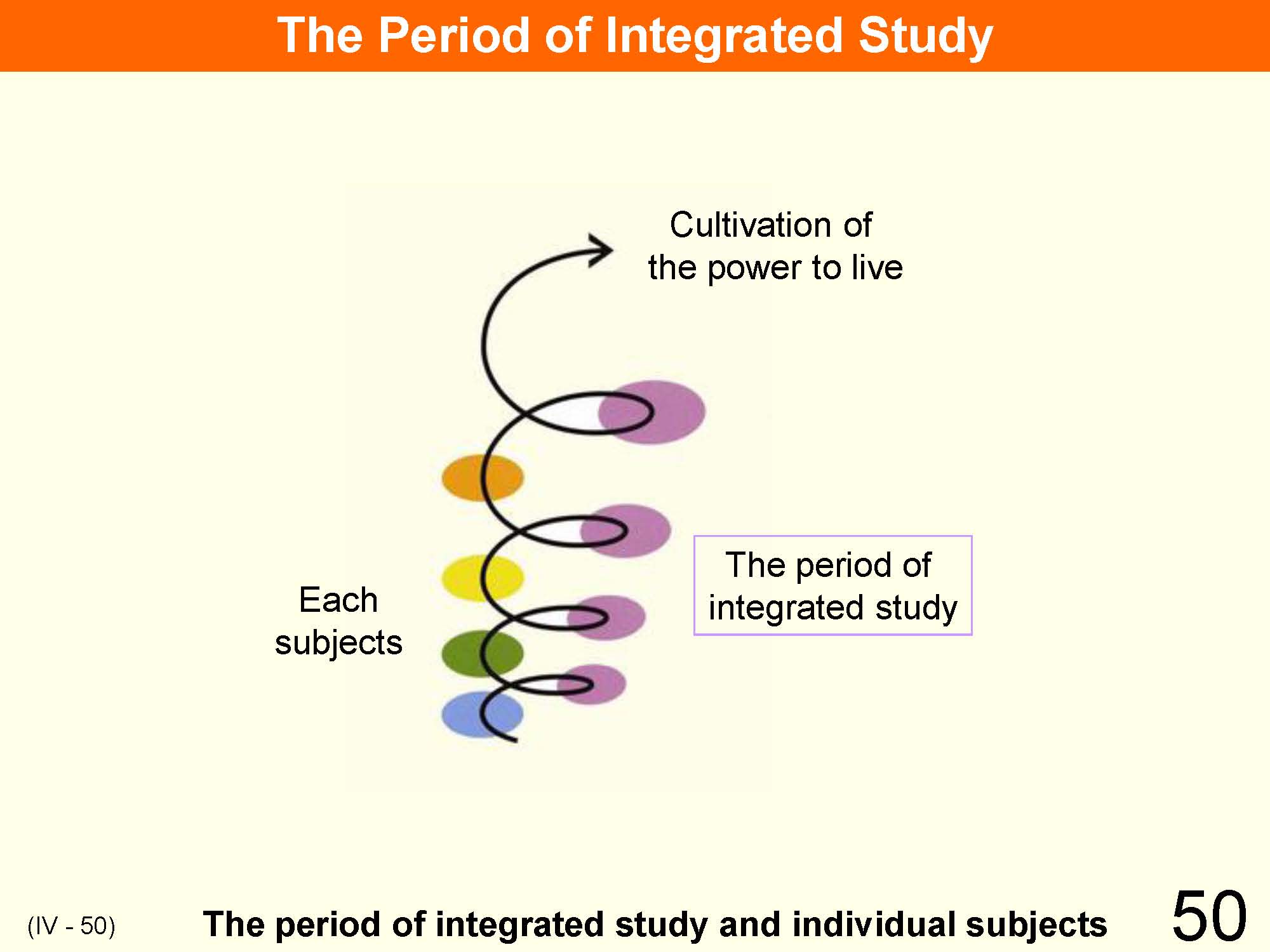 |
The “period of integrated study“ and the subjects encountered have an inter-linked structure, as shown in the chart above. This means that the knowledge and skills learned in each subject inter-relate in a comprehensive fashion to “the period of integrated study.” The power gained during the “period of integrated study” is utilized in learning individual subjects. |
| 51 | 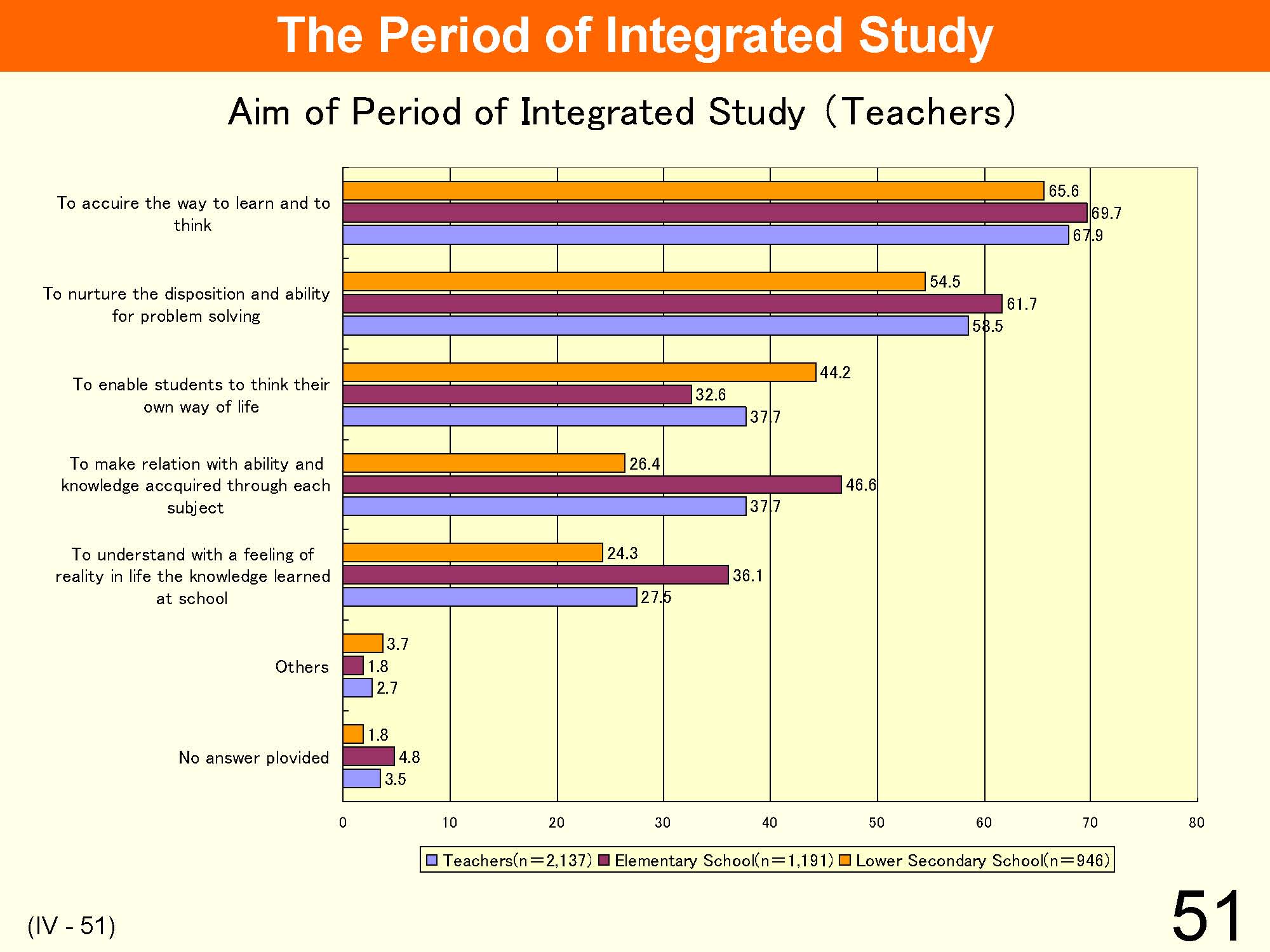 |
Source: ”Survey on School Education” in September 2003, by the Ministry of Education, Culture, Sports, Science and Technology (MEXT) From the above survey data, we can see students’ progress in developing perspectives that they don’t always encounter in classroom settings when learning subjects. For example, when children encounter new experiences they become absorbed in studying by themselves. They can also engage in activities with children from other class levels. |
| 52 | 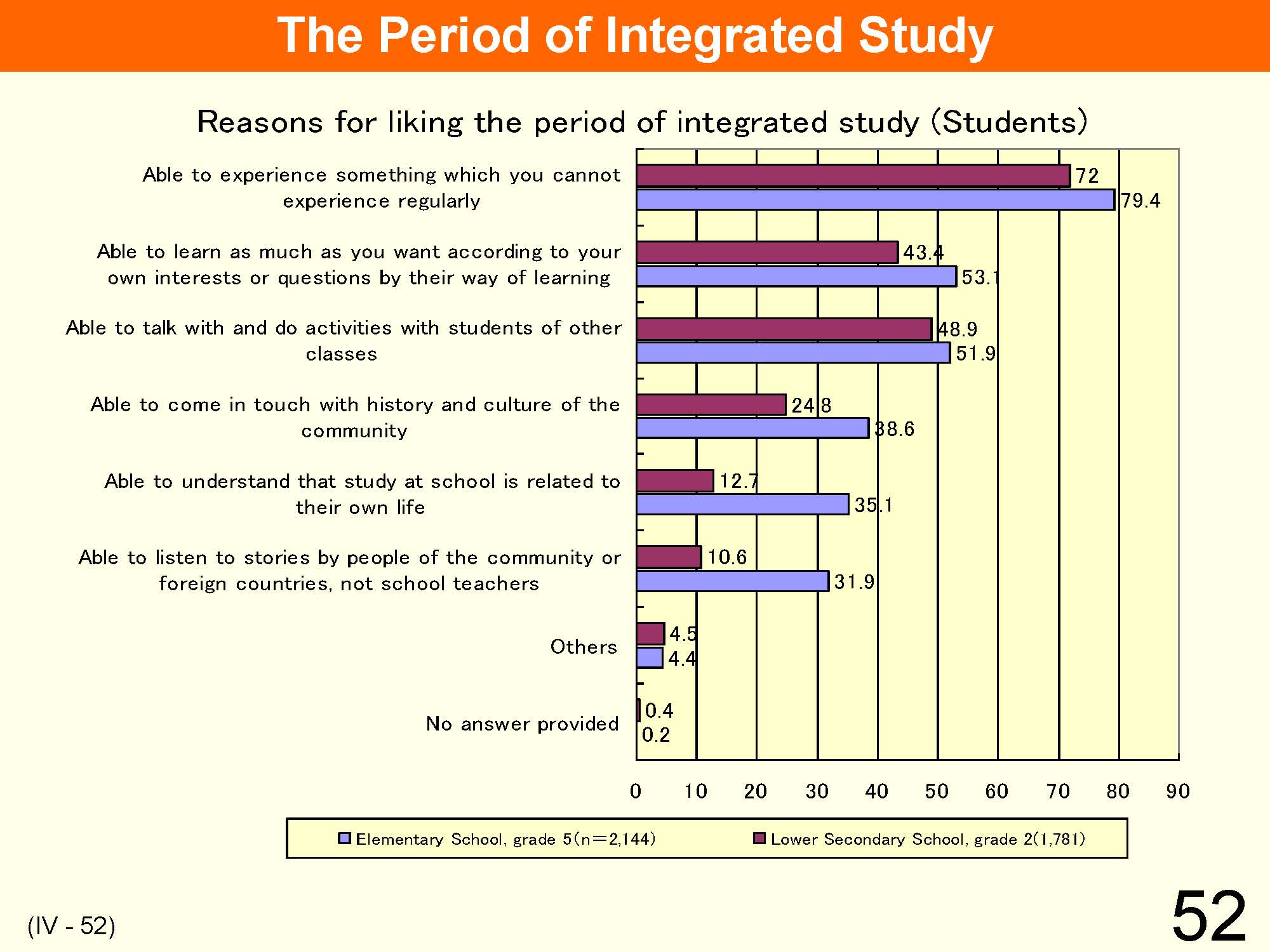 |
Source: ”Survey on School Education” in September 2003, by the Ministry of Education, Culture, Sports, Science and Technology (MEXT) From the above survey data, we can see students’ progress in developing perspectives that they don’t always encounter in classroom settings when learning subjects. For example, when children encounter new experiences they become absorbed in studying by themselves. They can also engage in activities with children from other class levels. |
| 53 | 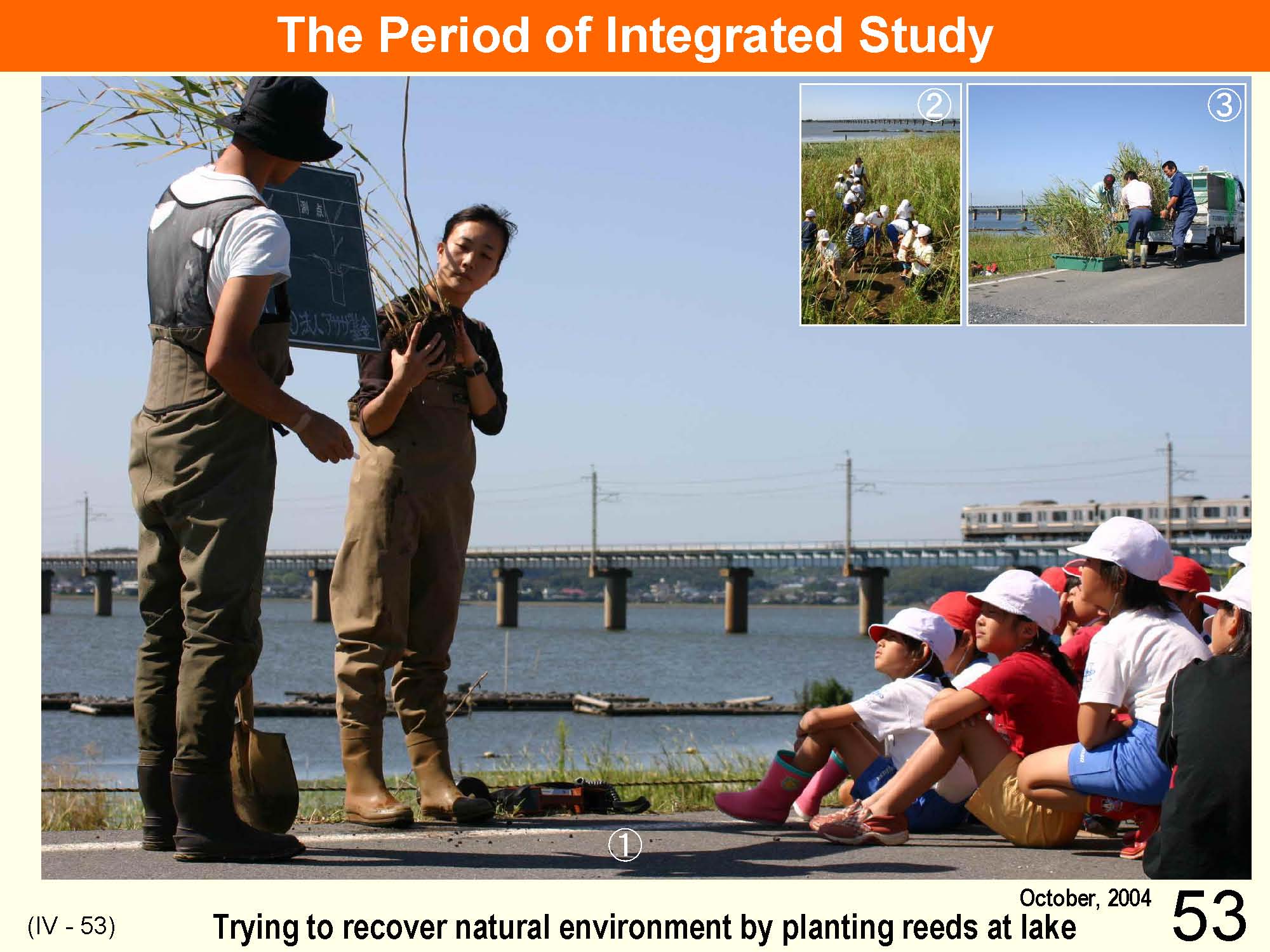 |
The pictures show an activity during the “period of integrated study.” Various activities are done during the period of integrated study, depending on the creativity of teachers and students and the features of each school. (1) Voluntary teachers from a NPO for environment protection are explaining advantages to plant reeds for restoring nature. Students grew these reeds in their school. (2) Students are planting reeds. (3) City officials cooperate in carrying reeds from the school to the lakeside. |
| 54 | 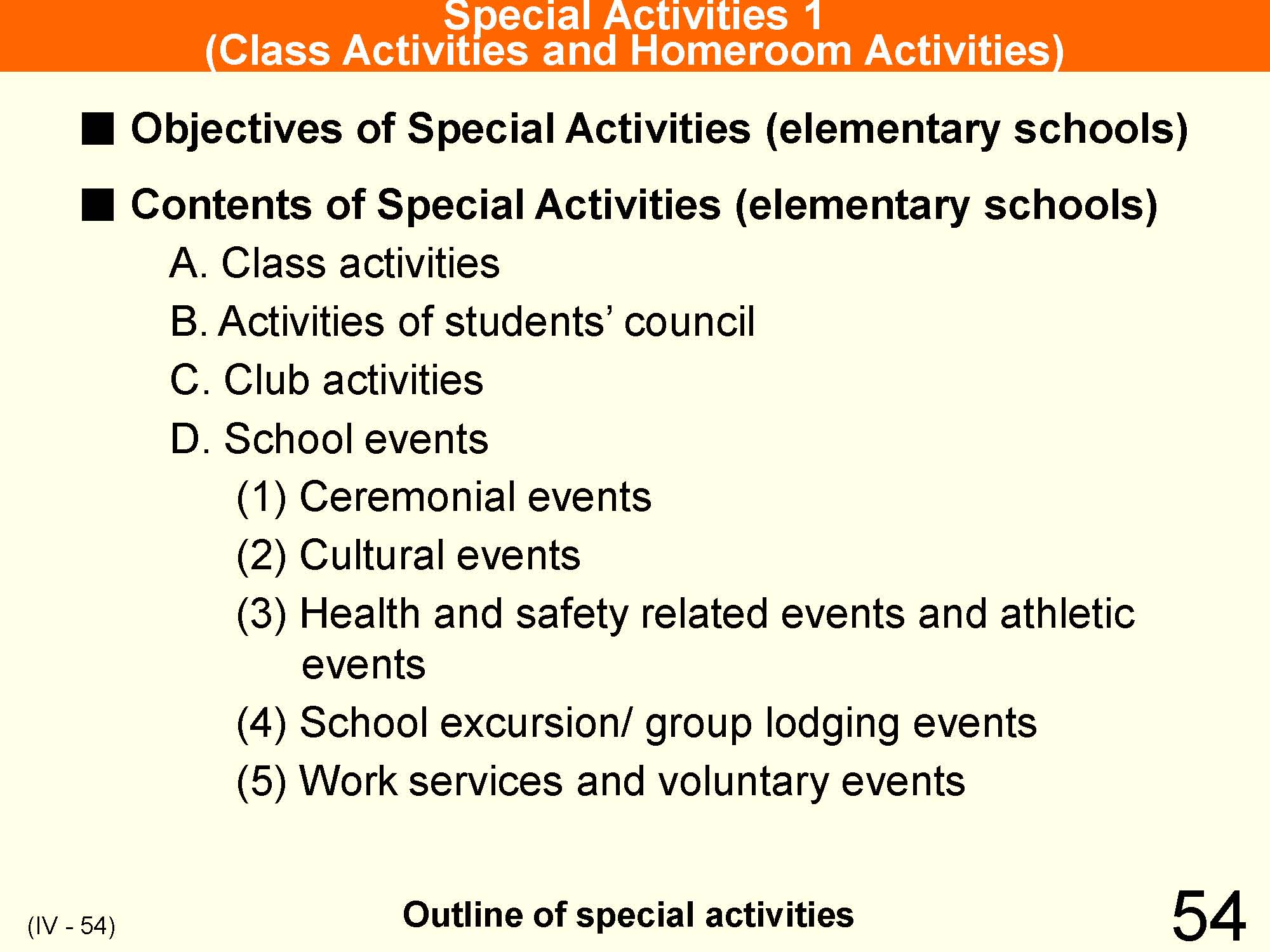 |
“Special activities” are the activities outside subjects that are done usually through group activities of a whole class, grade, or school. To be more specific, they consist of four types of activities: A) class activities, B) activities of student councils, C) club activities, and D) school events. ■ Objectives of special activities Through appropriate group activity, special activities aim to develop students’ minds and bodies in harmony, foster independent and practical attitudes in order to seek to build better life and human relations as a member of a group, deepen their awareness of way of life, and nurture abilities to make the most of oneself. |
| 55 | 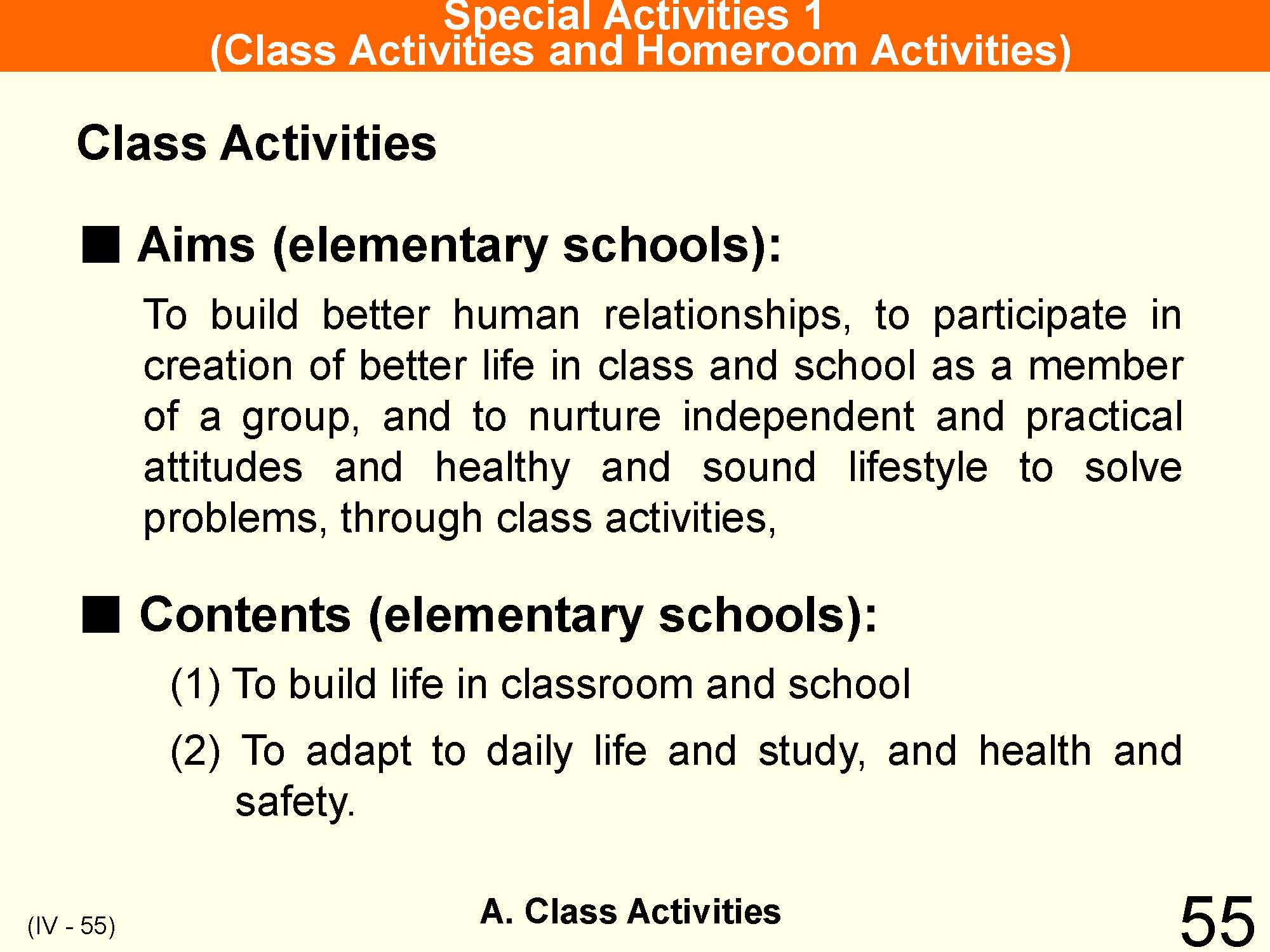 |
“Class activities” are defined as activities to improve progress in class and school life and to cultivate sound life styles for children. ■Examples of content are: (1) Solve various problems in class and school life, organize a class to assign work to individual students, and to improve various group lives in school by making class rules. (2) To develop attitudes to live with hope and purpose, to acquire basic living habits, to develop good human relationships, to understand the importance of roles and jobs of assigned work such as cleaning, to make use of school library, to build healthy and safe lifestyles in mind and body, and to develop school lunch in view of food education and desirable eating habits. |
| 56 | 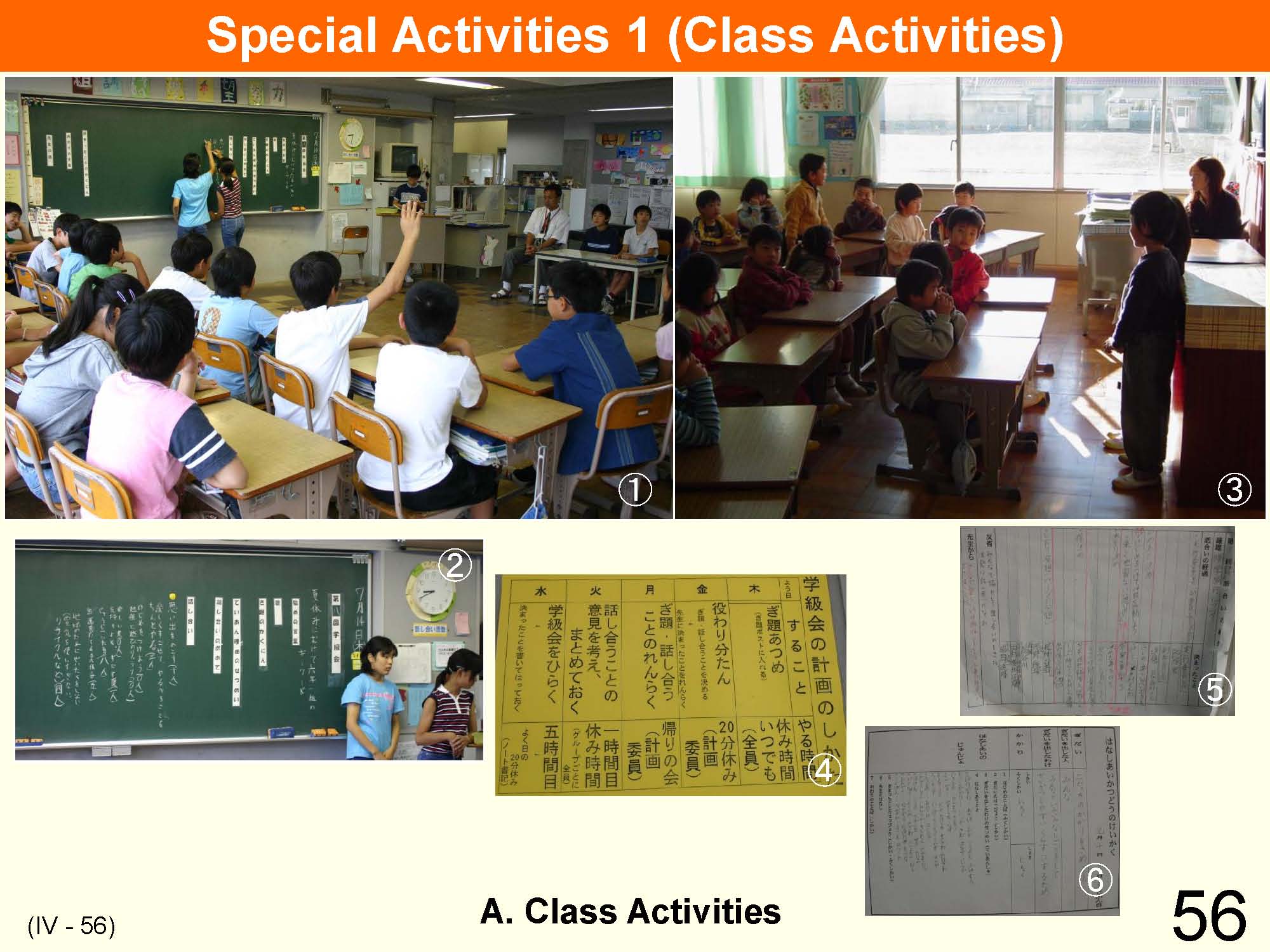 |
(1)(2) Class meeting; Under the guidance of a teacher and selected class representatives, students bring up topics such as problems in their class. The students then discuss these issues find solutions to the problems. (topic; what to do while summer vacation, 6th grade, July 2005) (3) Morning meeting (1st grade December 2003) (4) Procedure of class meeting (5) Record of class meeting (6th grade) (6) Record of class meeting (1st grade, December 2003) |
| 57 | 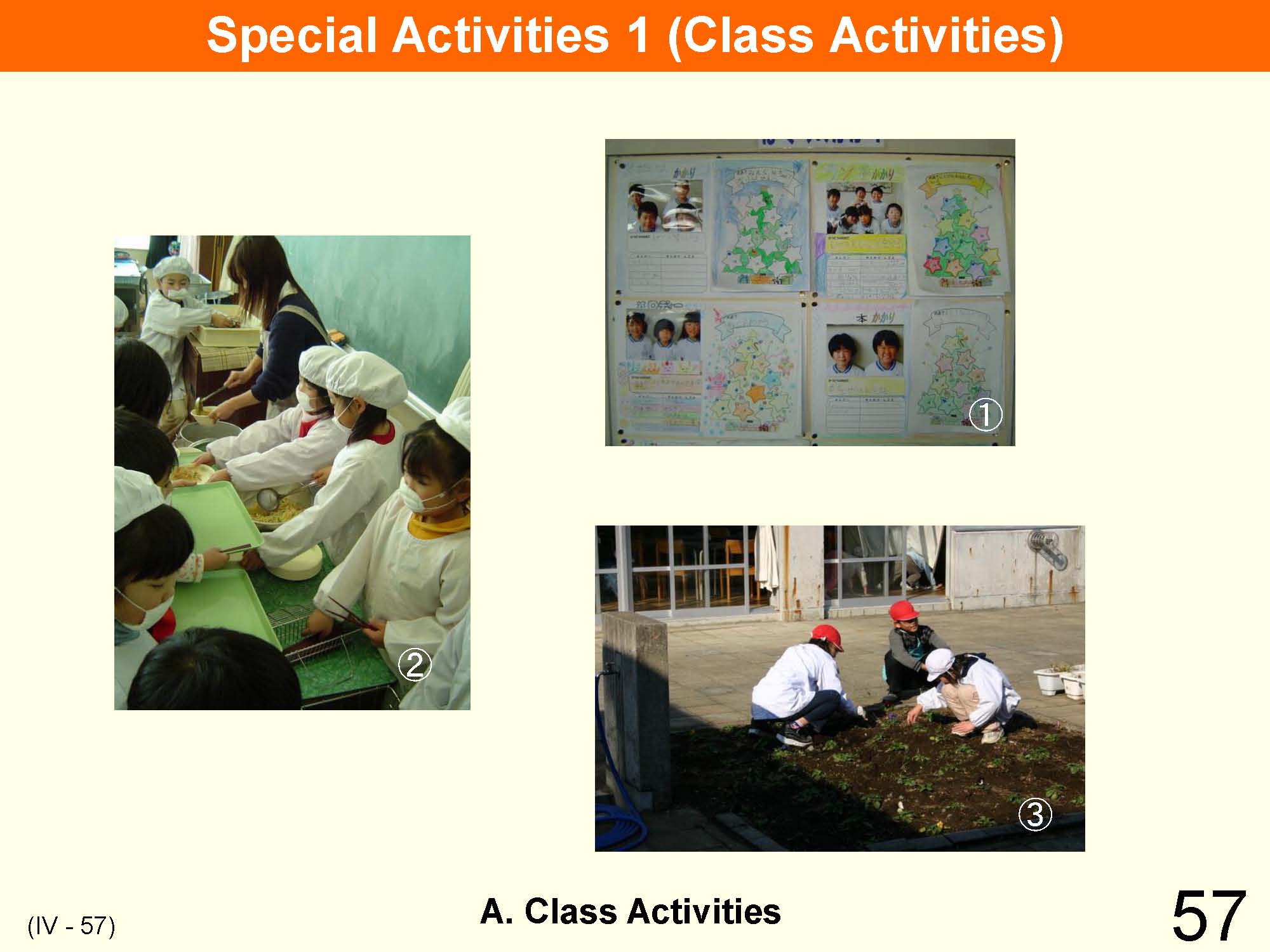 |
These are pictures of students at a school library and students during lunch time. (1) Students responsible for various tasks, 2nd grade, December 2003 (2) School lunch time, 1st grade, December 2003 (3) Students responsible for growing plants, January 2005 |
| 58 | 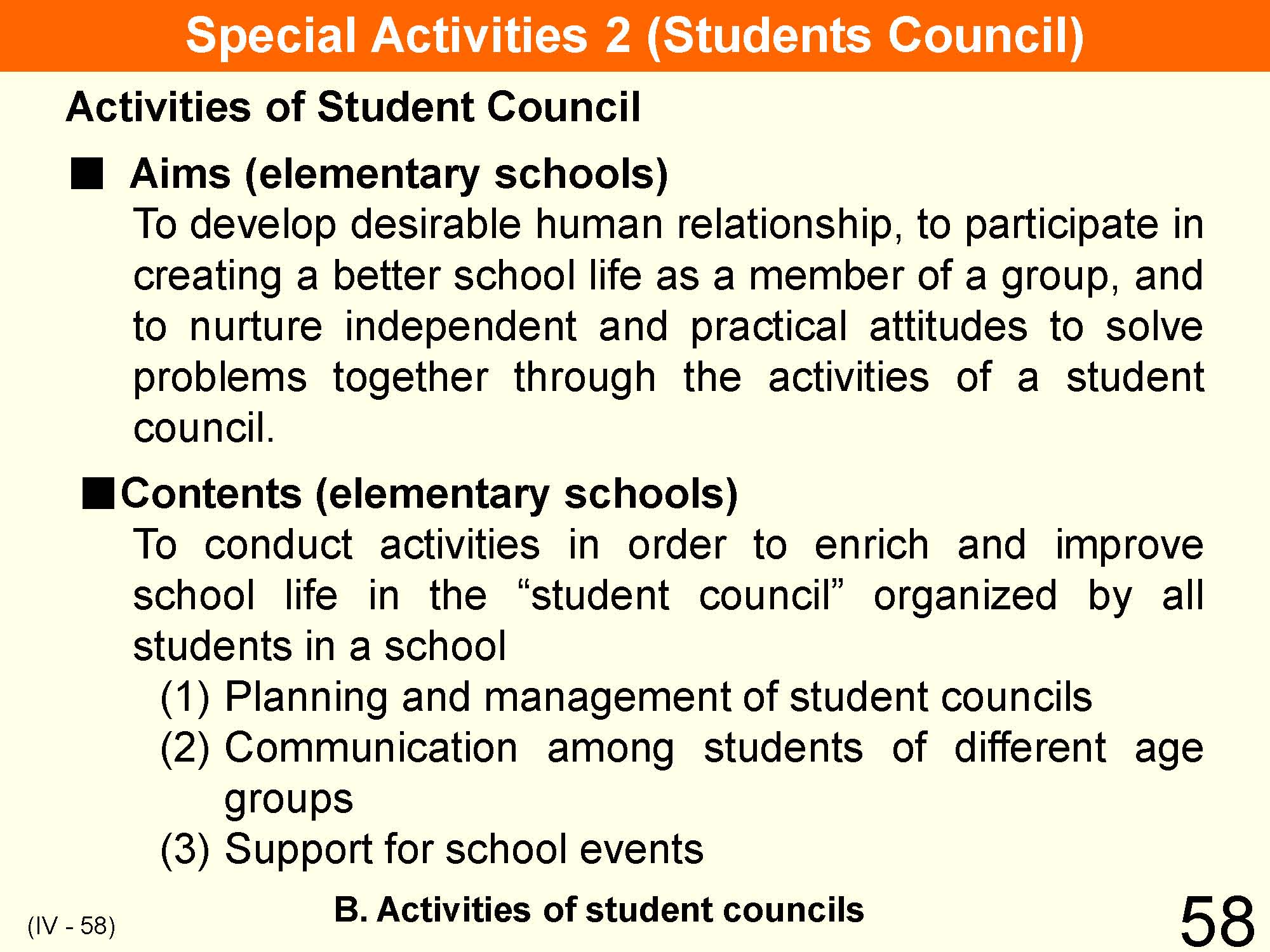 |
Another special activity is the “student council,” which is a students’ meeting organized by all students in a school. Management of the student council is carried out primarily by students in the 5th and 6th grades. The types of committees that the student council engages in are: “representative committee,” “committee” and “students’ assembly.” |
| 59 | 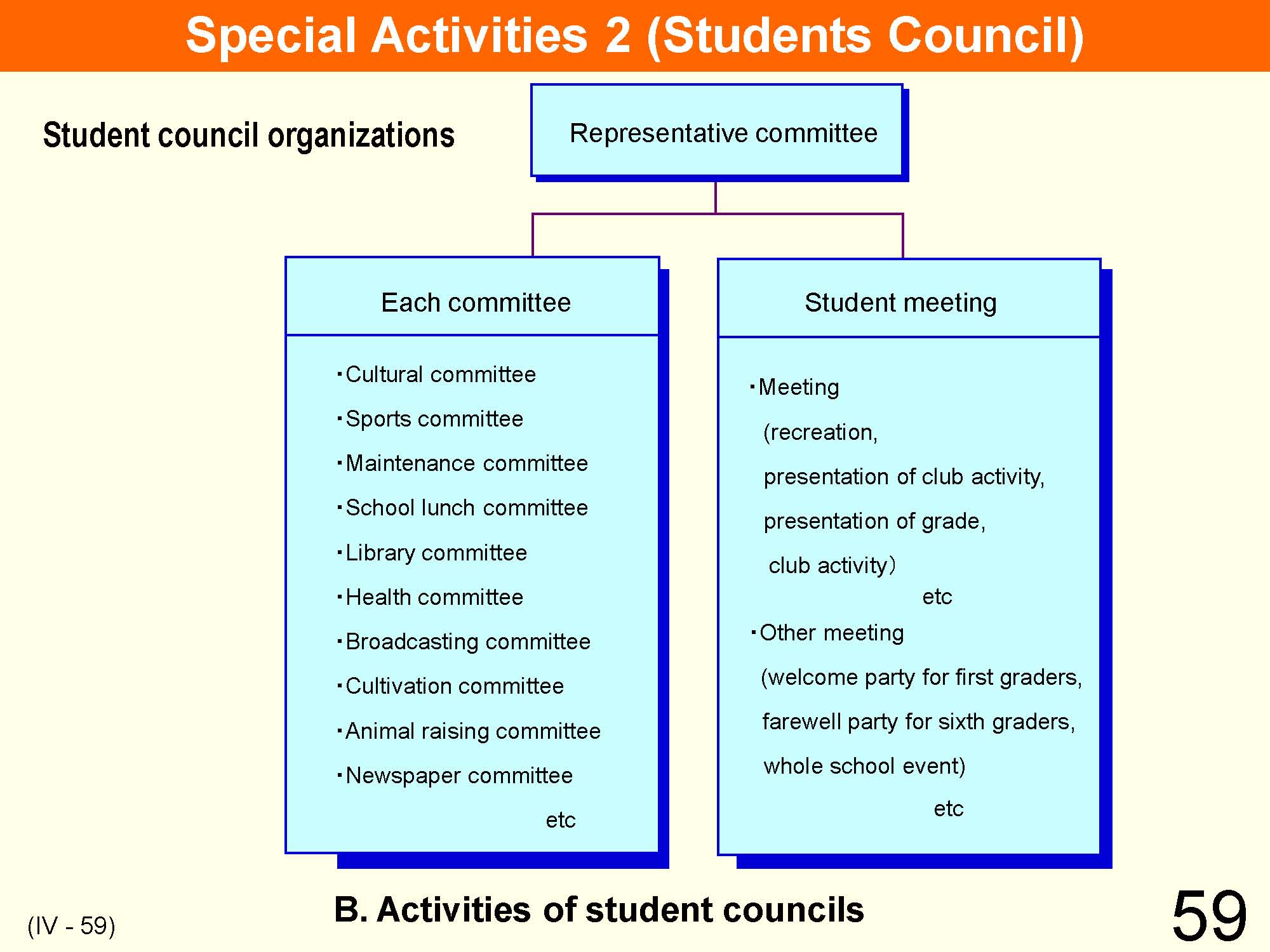 |
“Representative committees” consist of “class representatives” “committee representatives” and “steering committees.” Representative committees discuss organization and government of student councils, plans of meetings and general school life. For example, they hold such meetings as to make annual activity plans, to conduct reviews of activities over the year, to plan sports activities (marathon races, rope skipping day), to plan cultural activities (welcome party for first graders, farewell party for sixth graders), to discuss school life problems (making and enforcing school rules, how to deal with rainy days, reading of books) and finally other topics (plan UNICEF day, make an annual cleaning plan). |
| 60 | 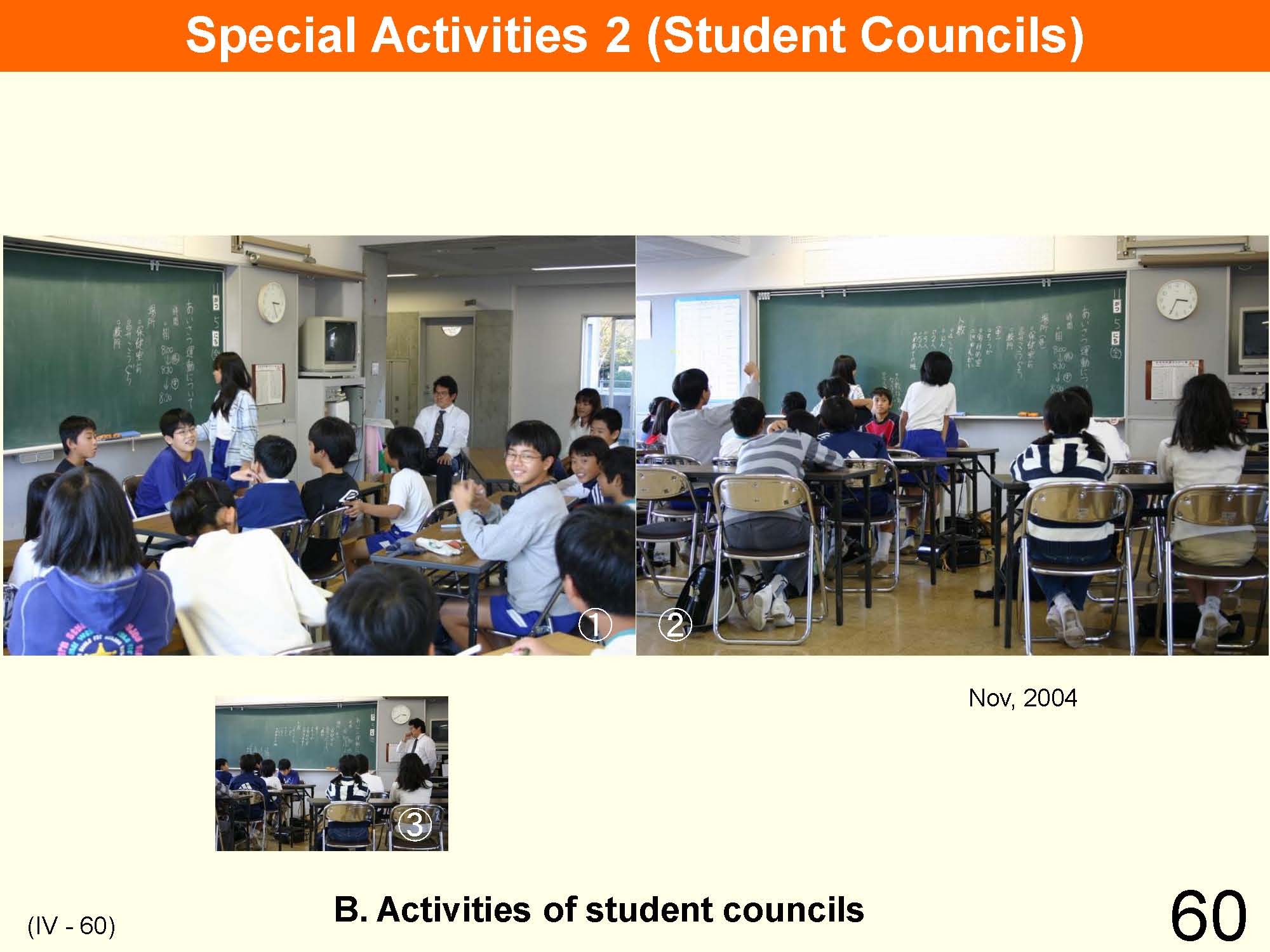 |
(1)(2) Student council “About greetings movement” (3) Feedback from a teacher |
| 61 | 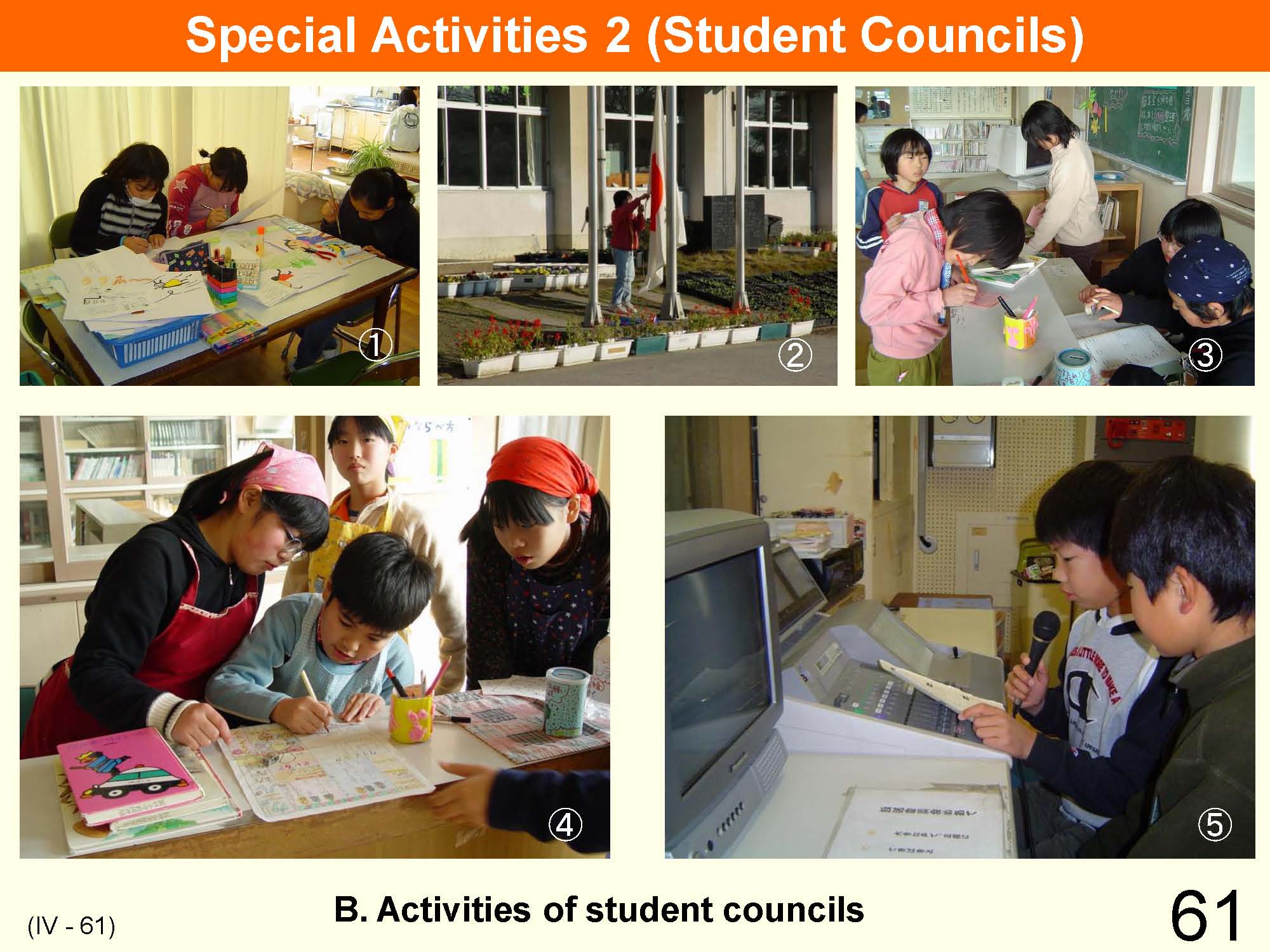 |
(1) At a health committee, students are making posters calling attention for all students to wash hands in order to prevent colds. December 2003 (2) A student of national flag committee is raising the national flag before morning meeting. December 2003 (3) Library committee. December 2003 (4) At a newspaper committee, students are making a school newspaper concerning school news and school events. December 2003 (5) At a radio broadcasting committee, students are broadcasting school news to all classes during an afternoon break. December 2003 |
| 62 | 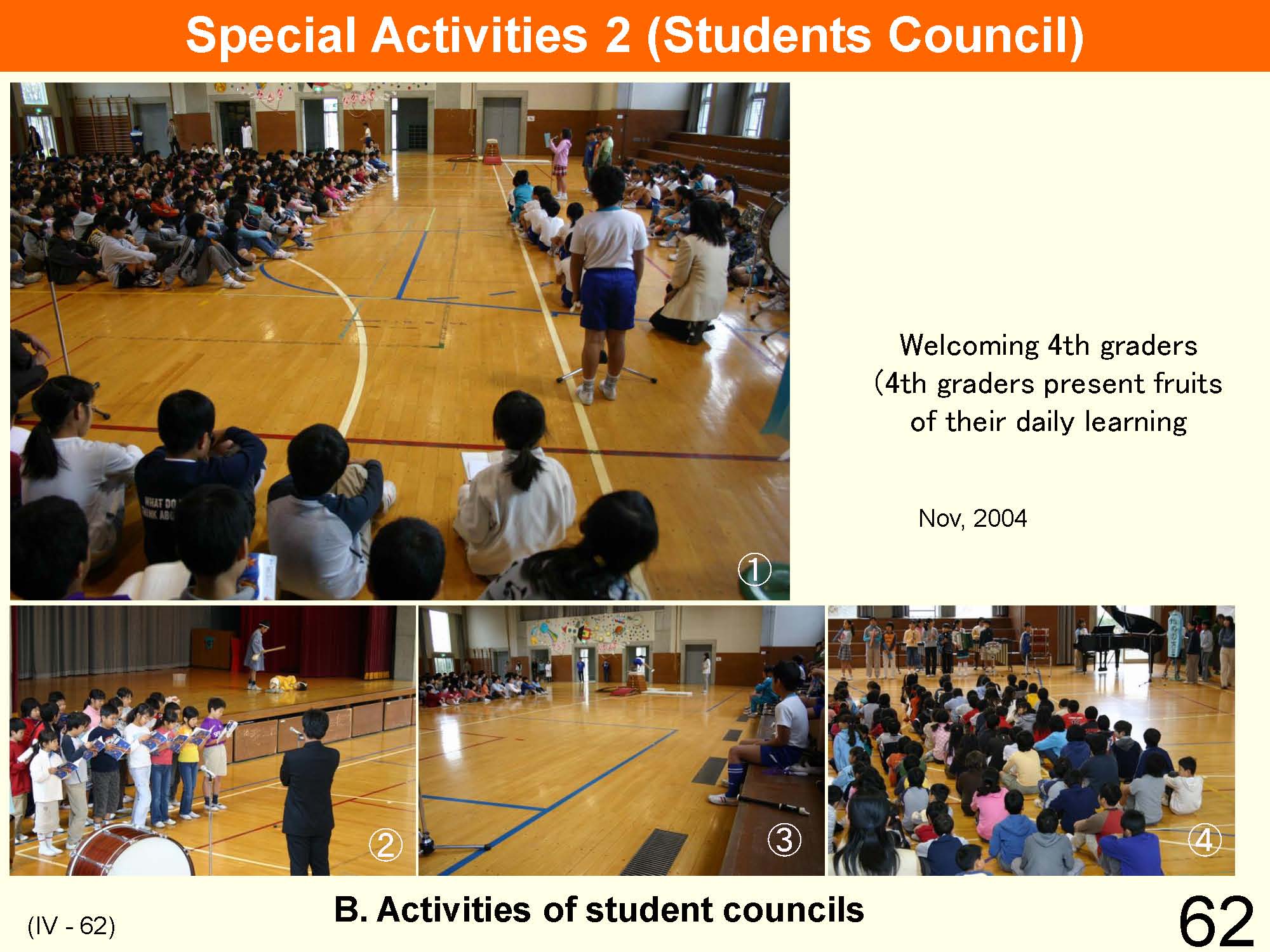 |
These pictures show student assemblies titled “Welcome 4th year students.” All the students gather and the 4th grade students are demonstrating what they have recently learned. (1) Reading compositions (2) Drama (3) Physical Education (4) Music |
| 63 | 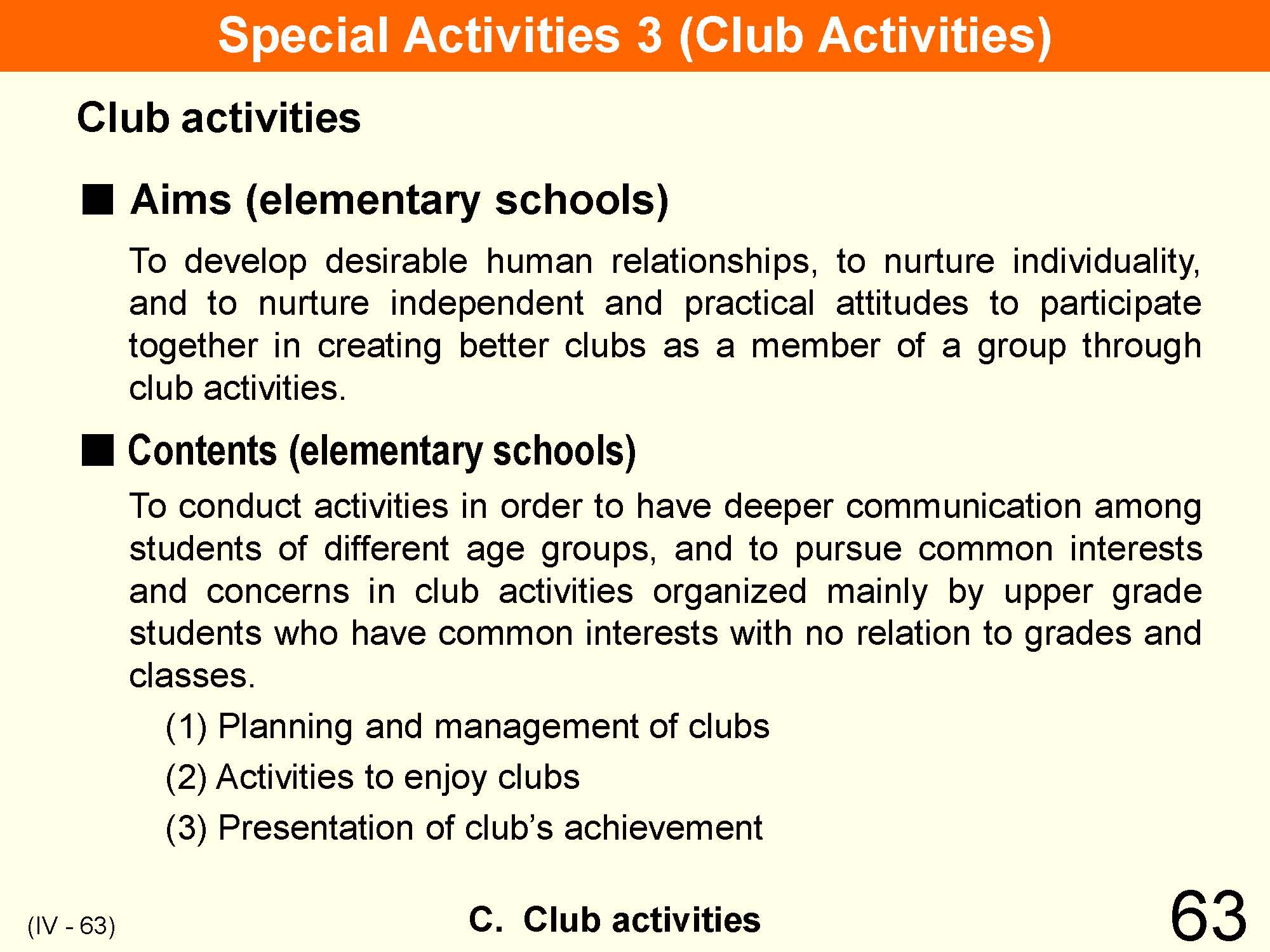 |
“Club activities” are organized mainly by the upper grade students who have common interests. They are practiced in elementary school. Teachers encourage students to work and study by themselves with leaders from the 5th or 6th grades. |
| 64 | 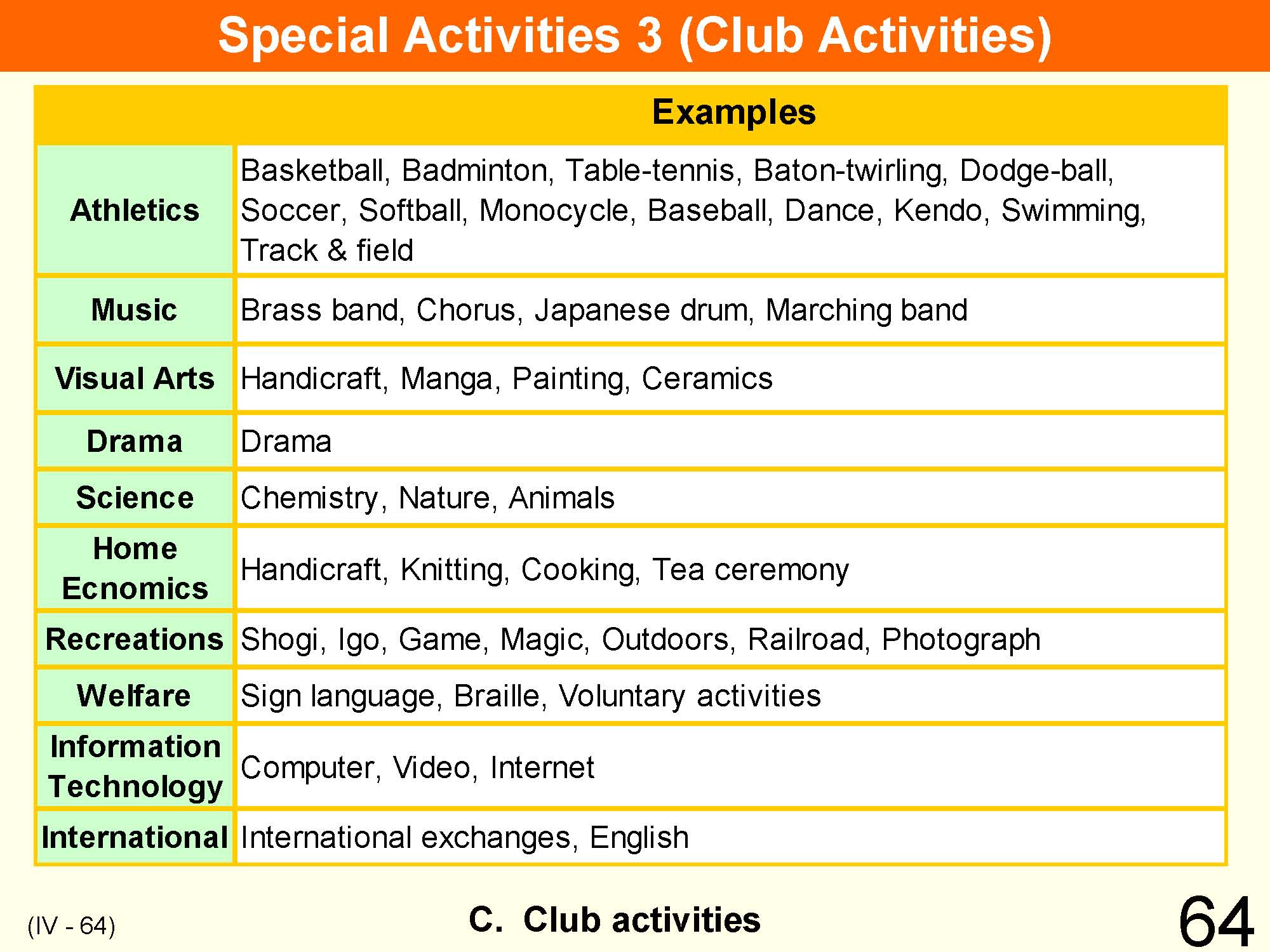 |
The figure provides an example of typical club activities at a school such as athletics, arts, and recreational activities, which meet students’ needs. The school organizes various types of club activities. |
| 65 | 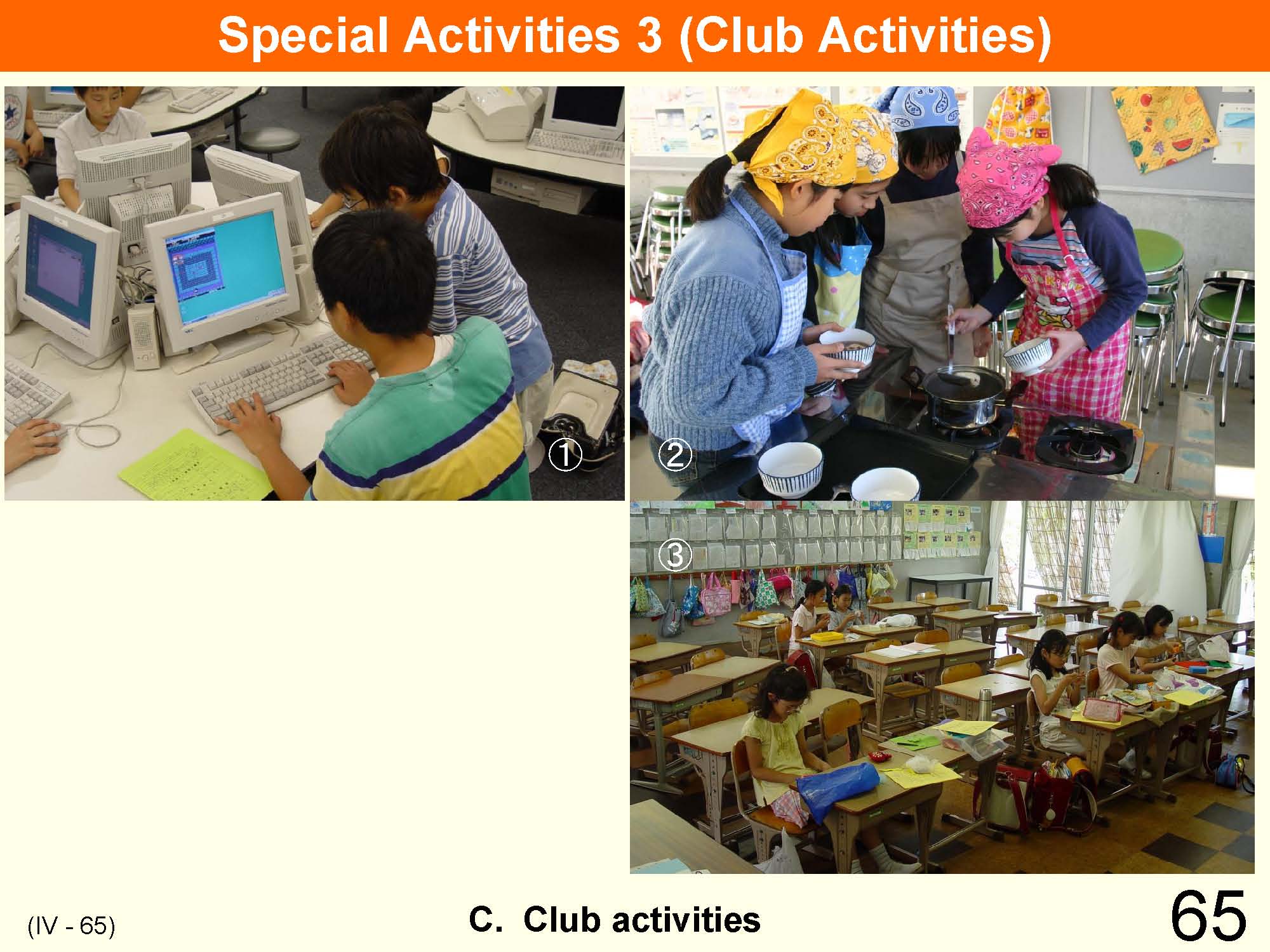 |
(1) Computer club, July 2004 (2) Cooking club: Students are making “Zenzai,” January 2005 (3) Handicraft club, July 2004 |
| 66 | 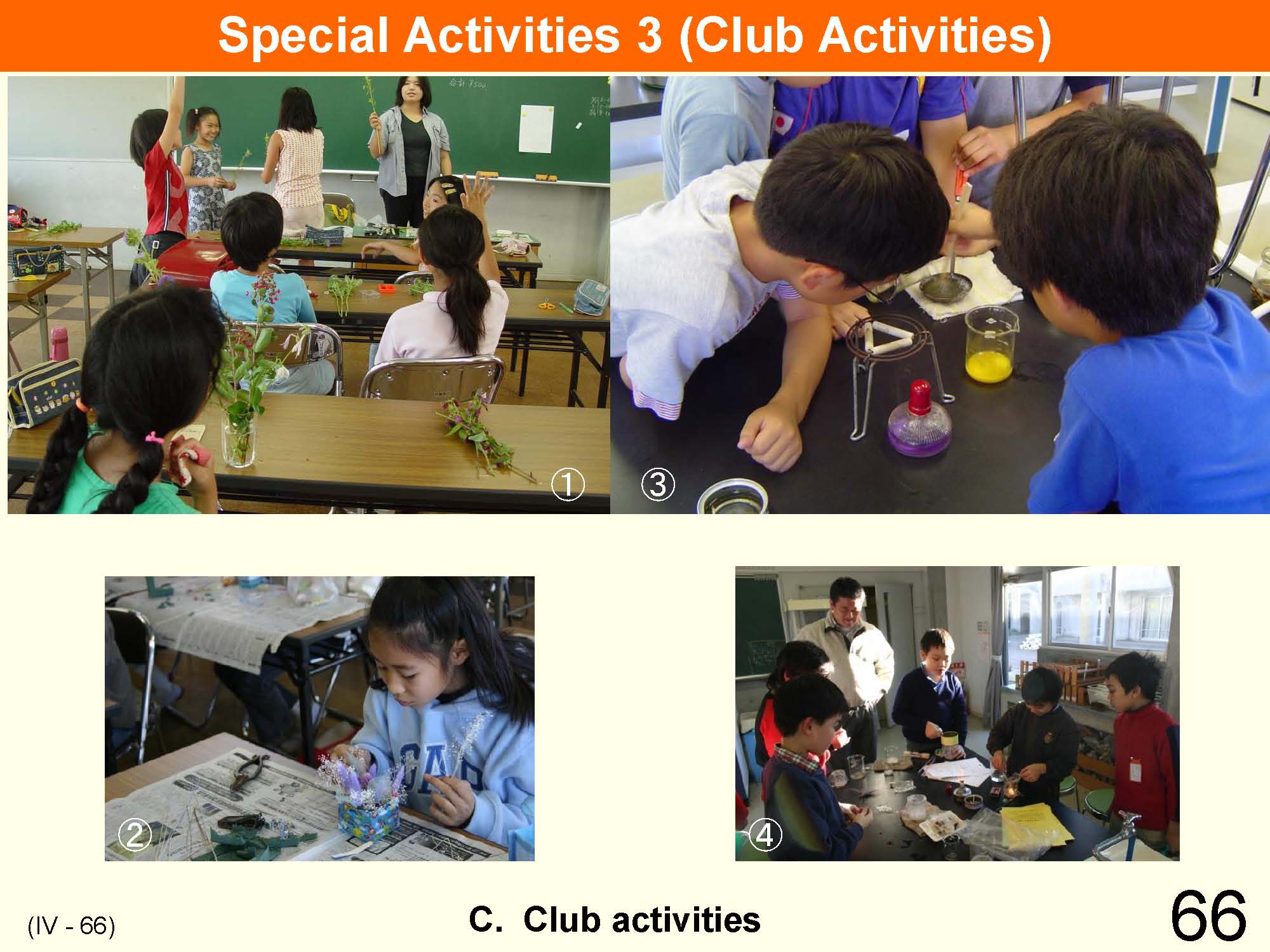 |
The pictures show cultural activities involving computer clubs and handicraft clubs. At the end of each term, students do self-assessments (1) Flower arrangement club, July 2004 (2) Flower arrangement club, July 2004 (3) Science club, July 2004 (4) Science club, July 2004 |
| 67 | 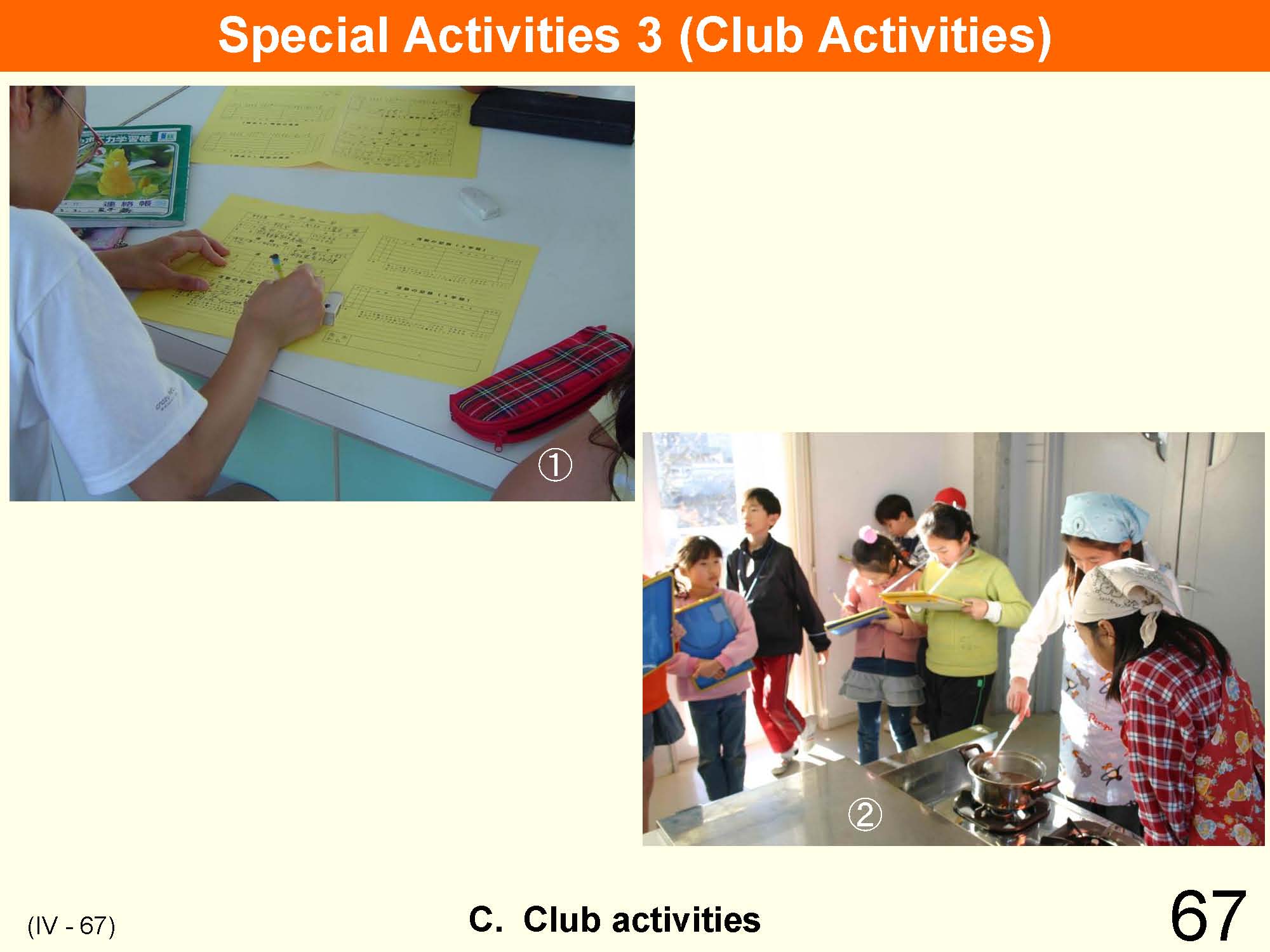 |
(1) Writing self-assessments (2) Club activities start from 4th grade. The visiting 3rd grade students are observing club activities to know what they are like. |
| 68 | 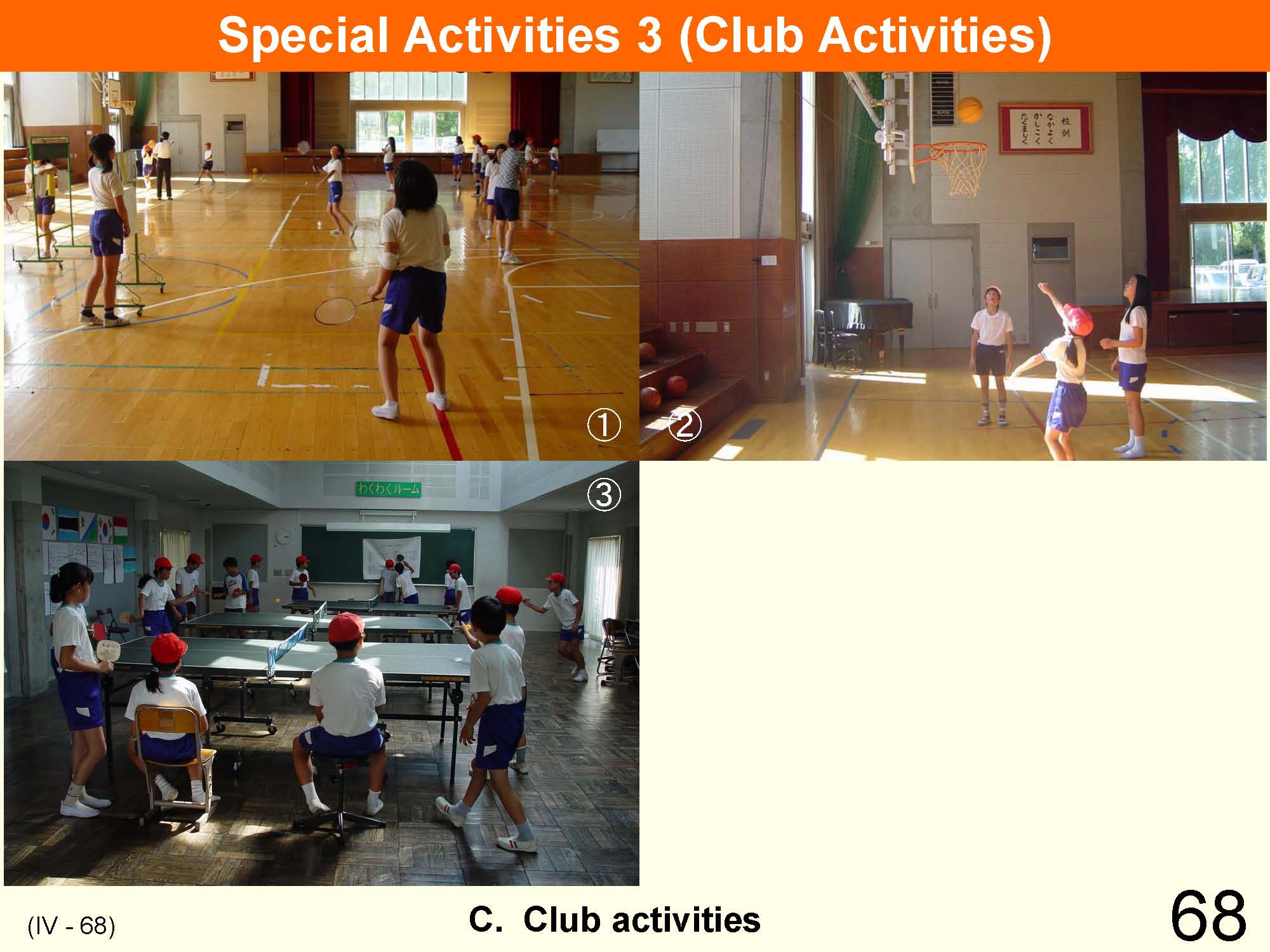 |
The pictures show athletic club activities; (1) badminton, July 2004 (2) basketball, July 2004 (3) table tennis, July 2004 |
| 69 | 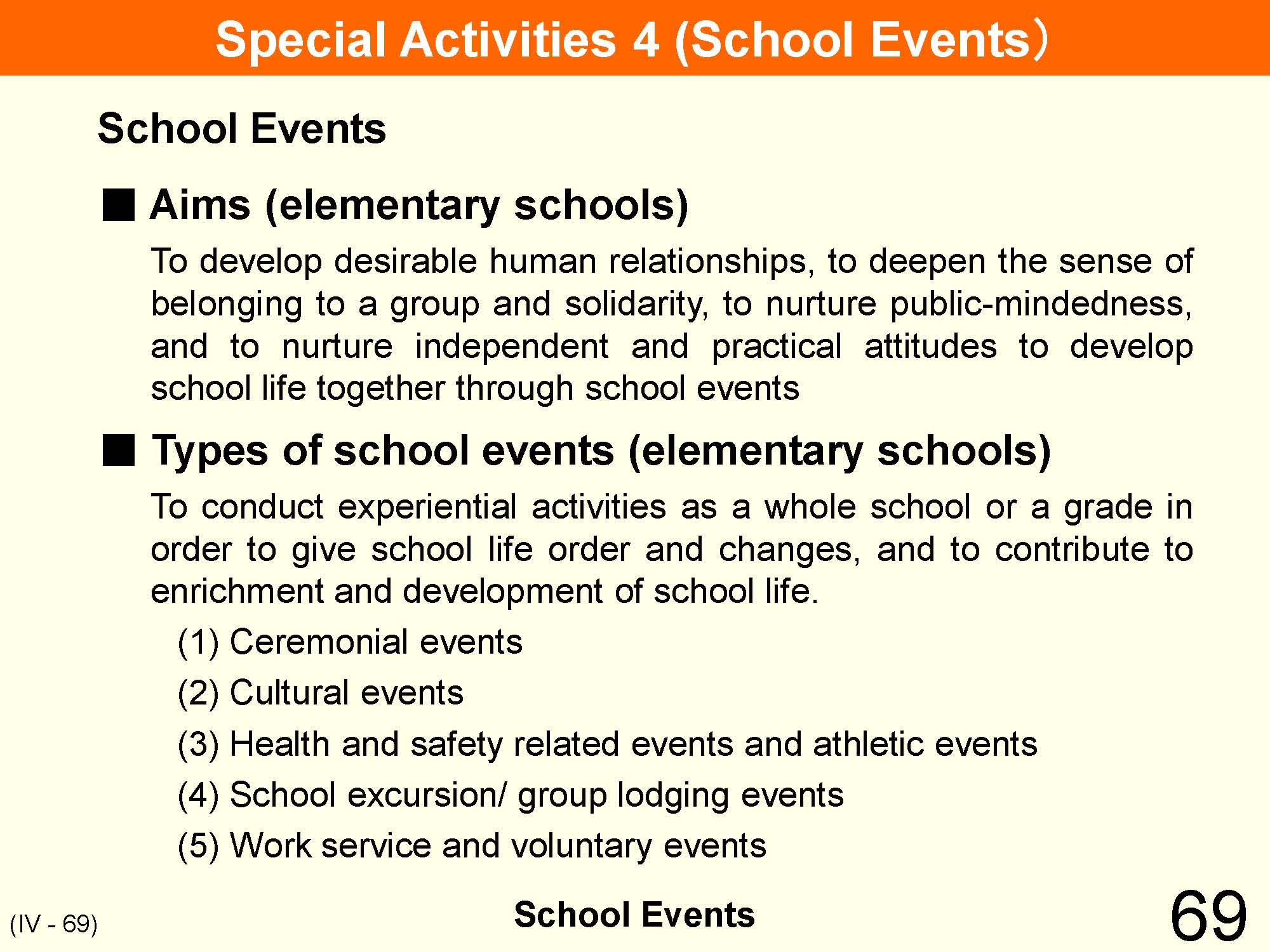 |
(1) Ceremonial events To conduct activities to give school life meaningful changes and milestones, to experience solemn and refreshed feelings, to be motivated to lead a new stage of life (2) Cultural events To conduct activities to present achievement of daily leaning activities, to increase motivation for improvement further, and to get familiar with culture and art (3) Health and safety related events and athletic events To conduct activities to raise awareness of building healthy minds and bodies and of maintenance and enhancement of health, to learn safe behavior and orderly group behavior, to nurture attitudes to enjoy exercise, to develop responsibility and sense of solidarity, and to improve physical condition. (4) School excursion / group lodging events To conduct activities to broaden one’s knowledge, to enjoy nature and culture, to be able to have desirable experiences of a way of group living such as human relationships, and public morals in life environment which is different from ordinary environment such as group lodging in a natural environment. (5) Work service and voluntary events To conduct activities to learn the value of work and joy of production by experience, to gain experiences to nurture spirit of social dedication such as volunteer activities. |
| 70 | 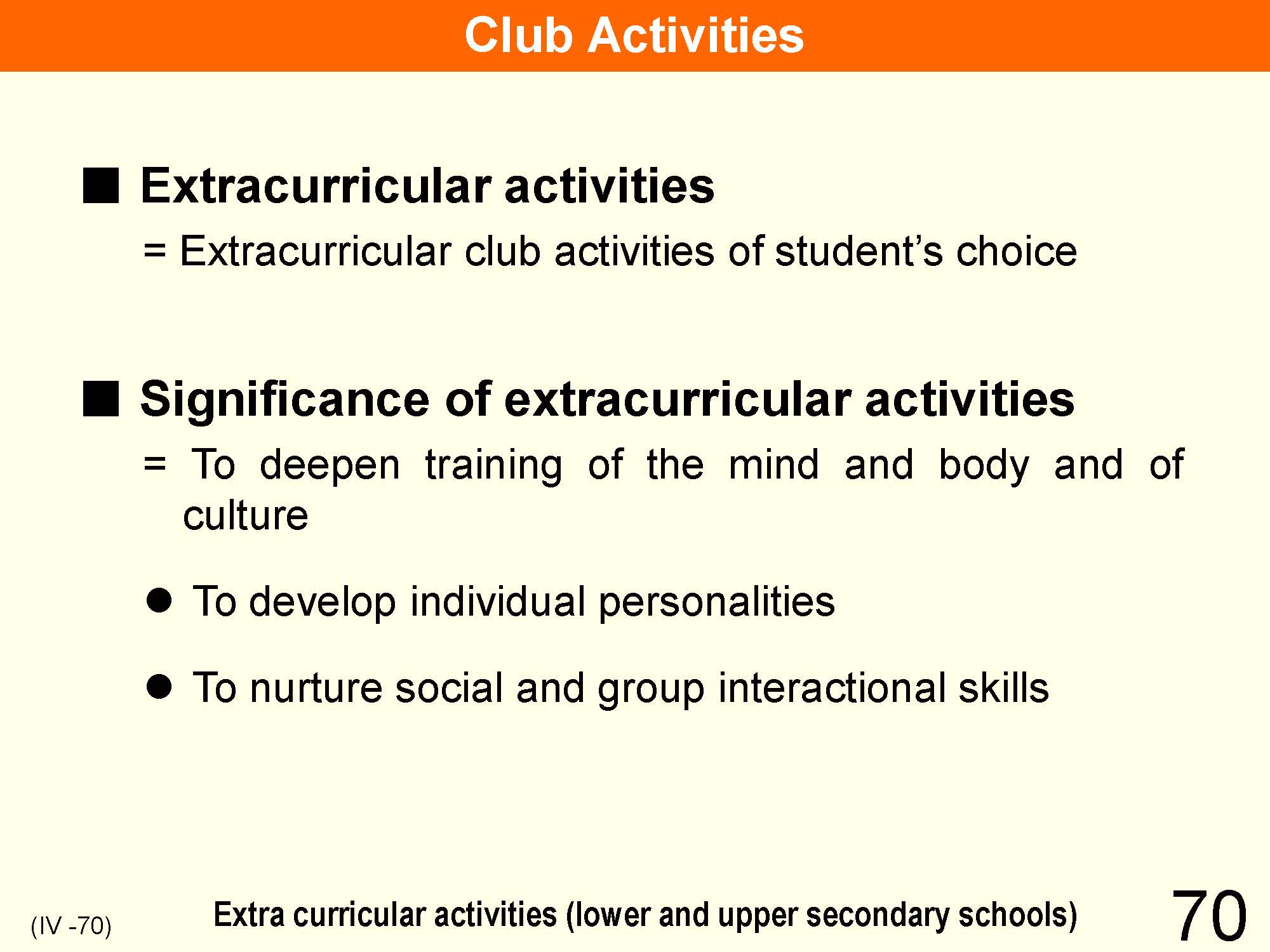 |
When compared with compulsory “club activities” in elementary school which are performed during class hours with participation by all students, “extracurricular activities” are club activities of students’ choices which are organized outside the curriculum at lower secondary schools or higher school levels. At present, the “extracurricular activities” are practiced at most lower and upper secondary schools. Since the “extracurricular activities” represent activities chosen by students outside of regular school curriculums, students can develop social and group skills that are more difficult to learn from school classroom subjects, as well as to develop their individual personalities. |
| 71 | 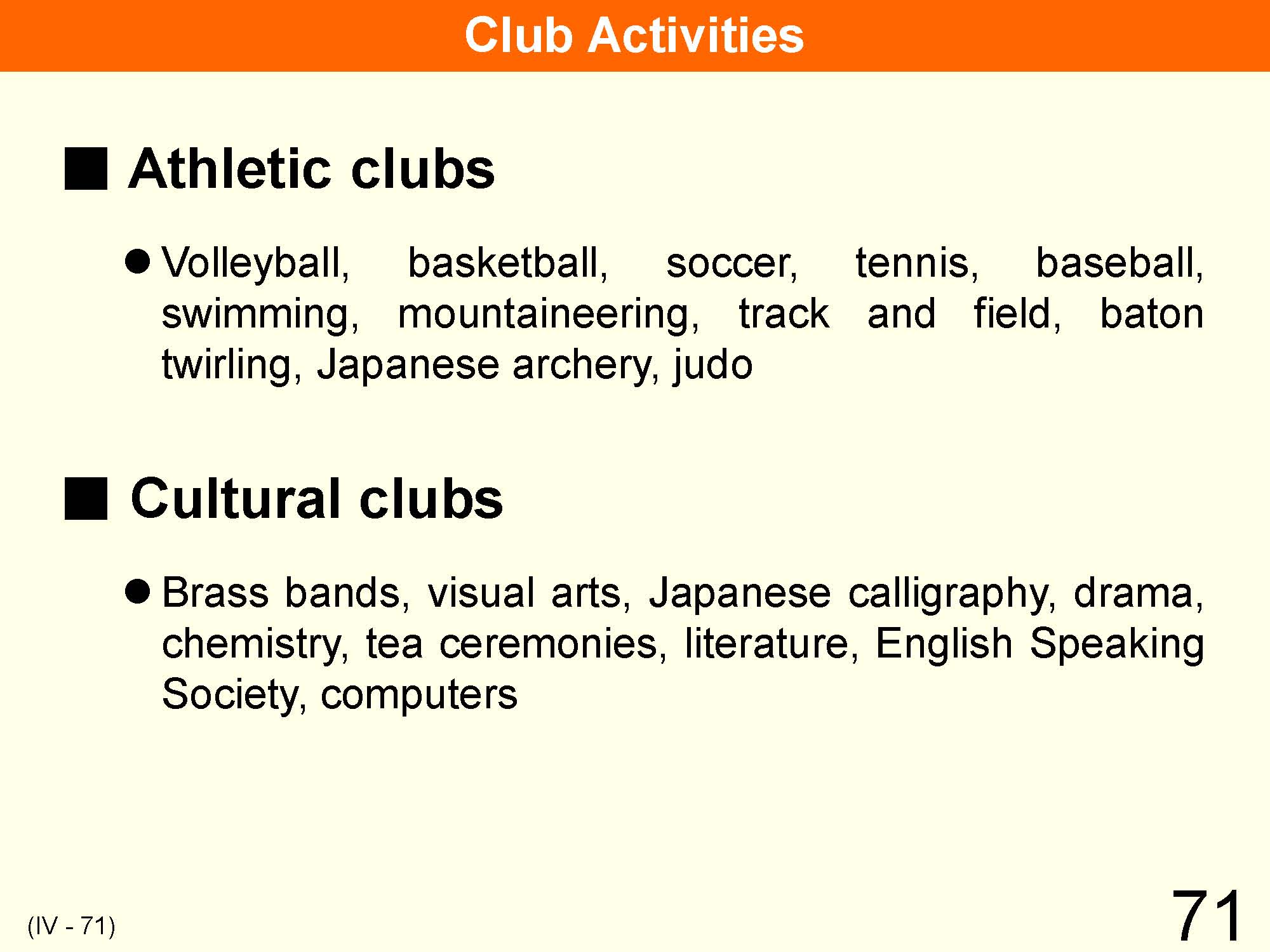 |
The above list of club activities are extracurricular, and are divided into athletic and cultural clubs in school. Through such club activities, students can learn respect for their seniors, sympathy toward juniors, and social interaction skills that cross age groups. |
| 72 | 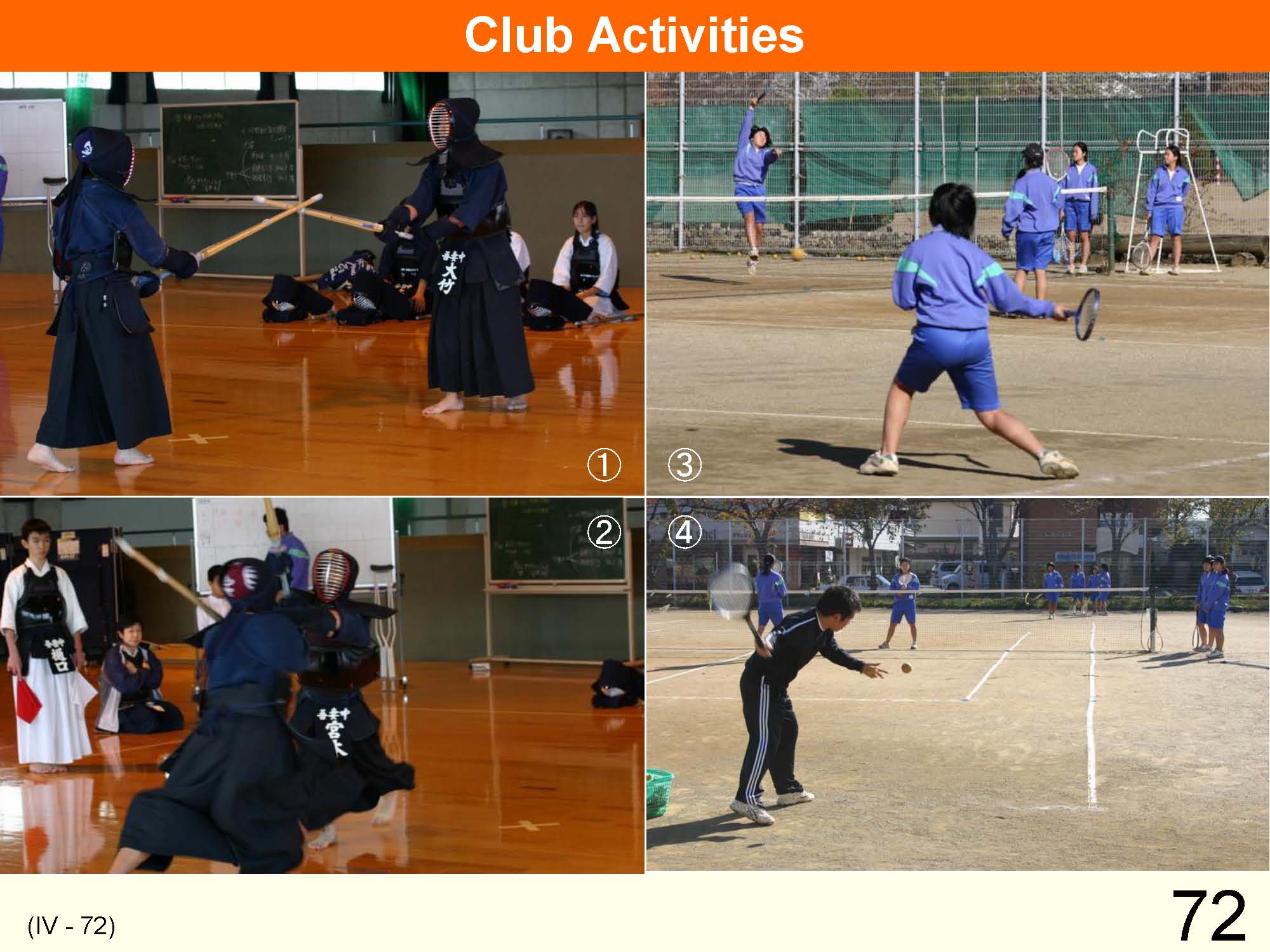 |
The above pictures show athletic club activities: Kendo and Softball tennis. Through club activities, students participate in official games and tournaments. During practice sessions, advisory teachers also participate in club activities (1)(2) Kendo (Japanese fencing), November 2004 (3)(4) Soft tennis, December 2004 |
| 73 |  |
The above pictures show athletic club activities: baseball and basketball. Through club activities, students participate in official games and tournaments. During practice sessions, advisory teachers also participate in club activities (1)(2) Baseball, November 2004 (3)(4) Basketball, November 2004 |
| 74 |  |
These are pictures of extra-curricular cultural activities such as computer clubs and brass band clubs. In these activities, students show their abilities by exhibiting their work at exhibitions held both within and outside school premises, including performing in concerts. Feedback from external evaluations is designed to develop students skills and to improve the quality of their activities. (1)(2) Computer club, December 2004 (3)(4) Brass bands, December 2004 |
| TOP | ||
Please send your comments and concerns here
kamada@criced.tsukuba.ac.jp
Center for Research on International Cooperation in Educational Development (CRICED) University of Tsukuba
1-1-1, Tennodai, Tsukuba-shi, IBARAKI
305-8572 JAPAN